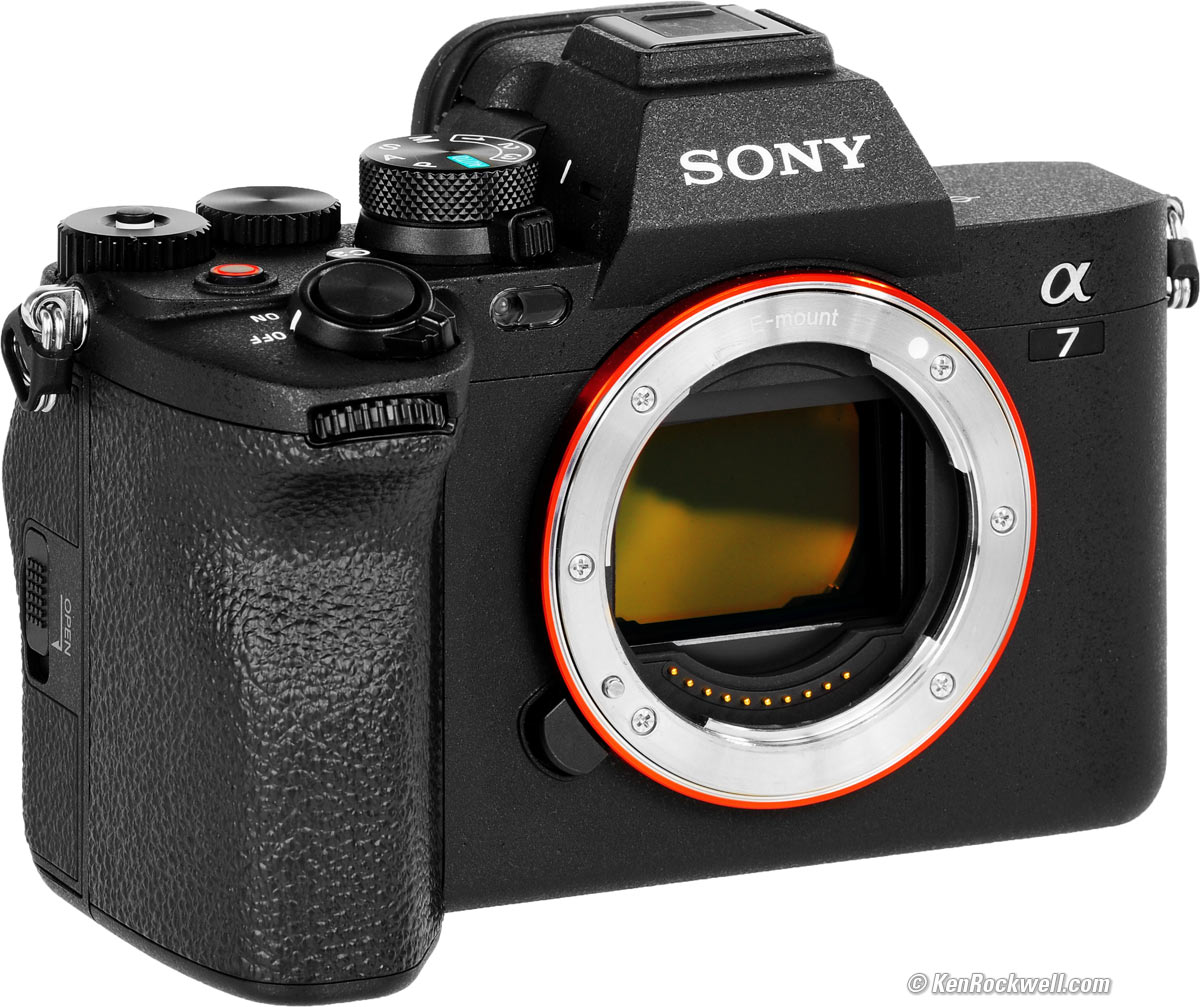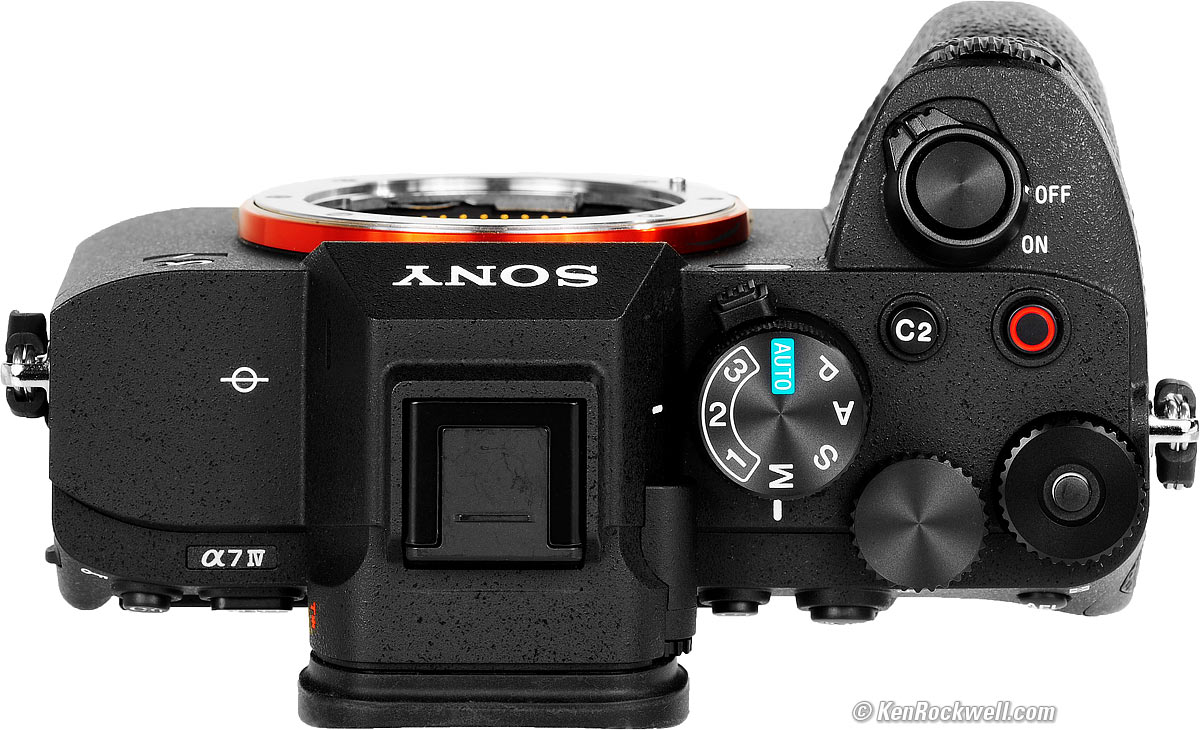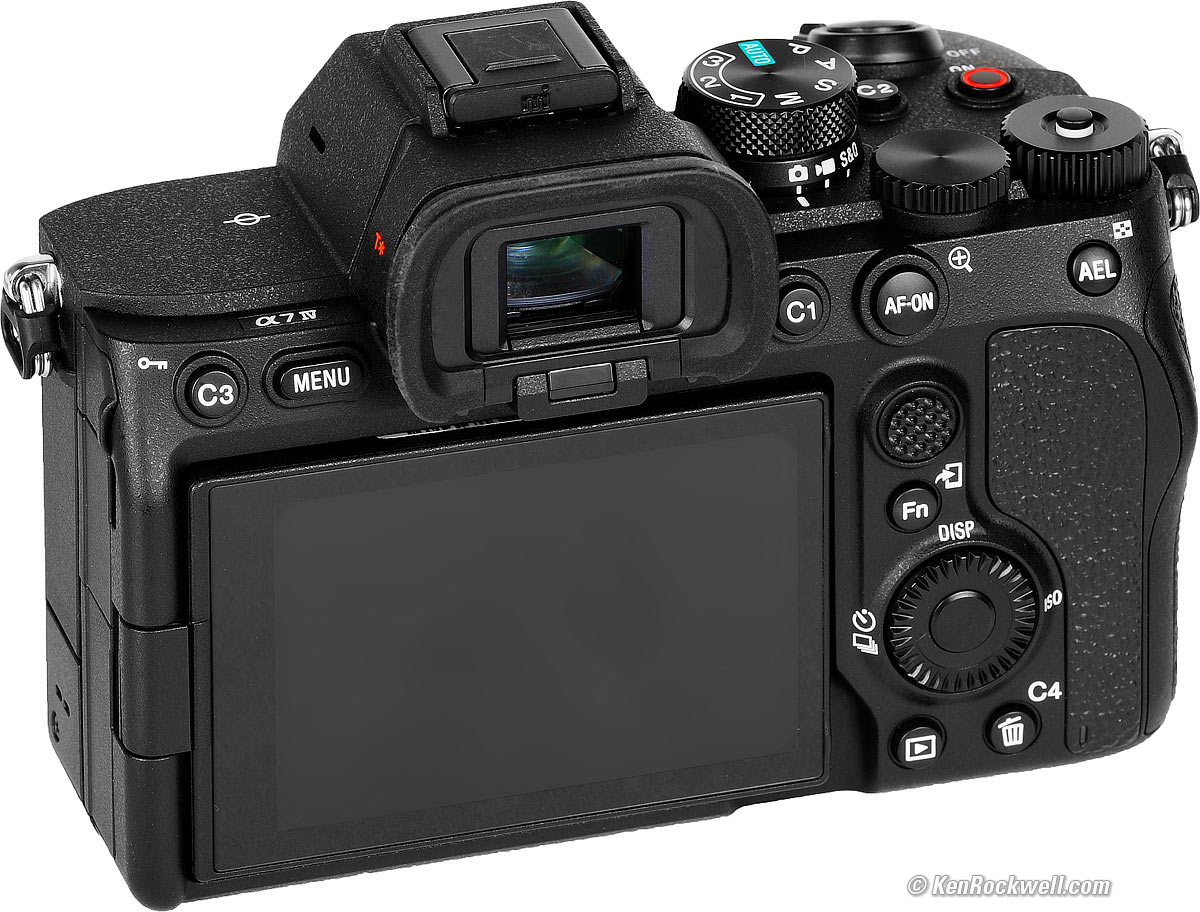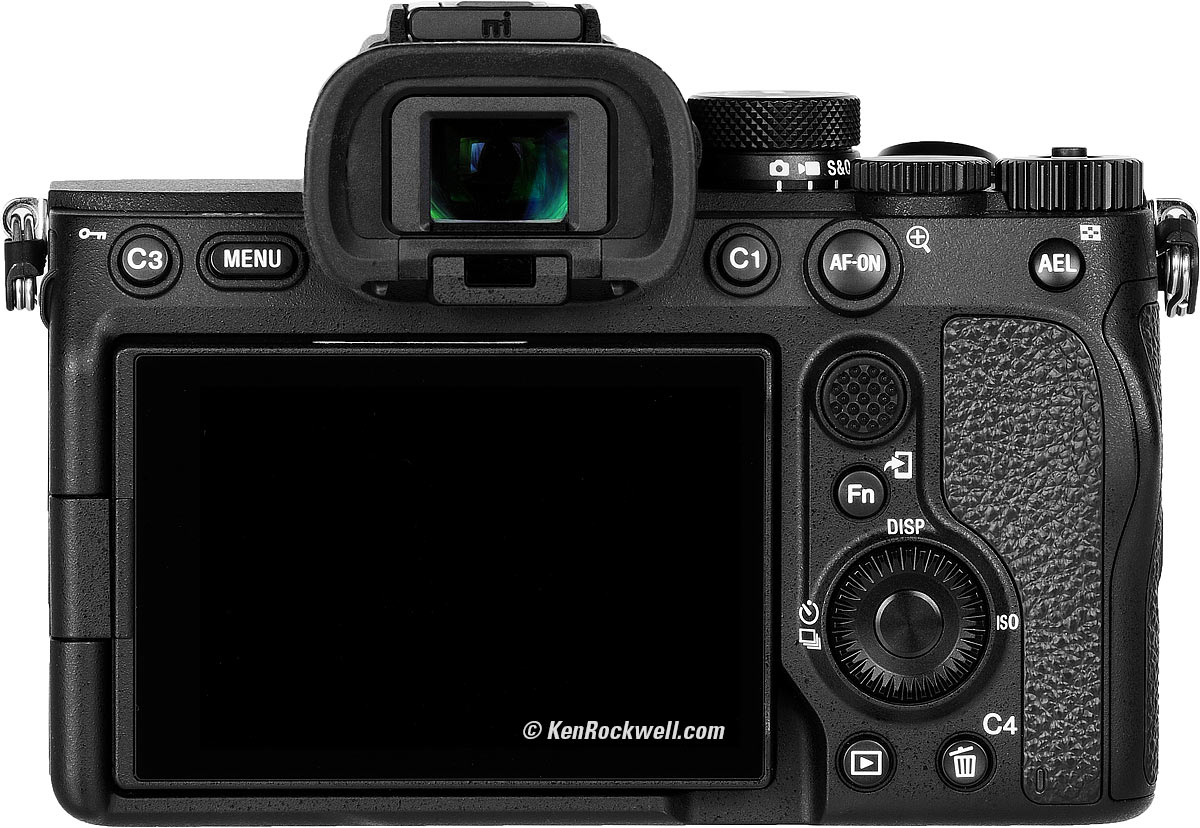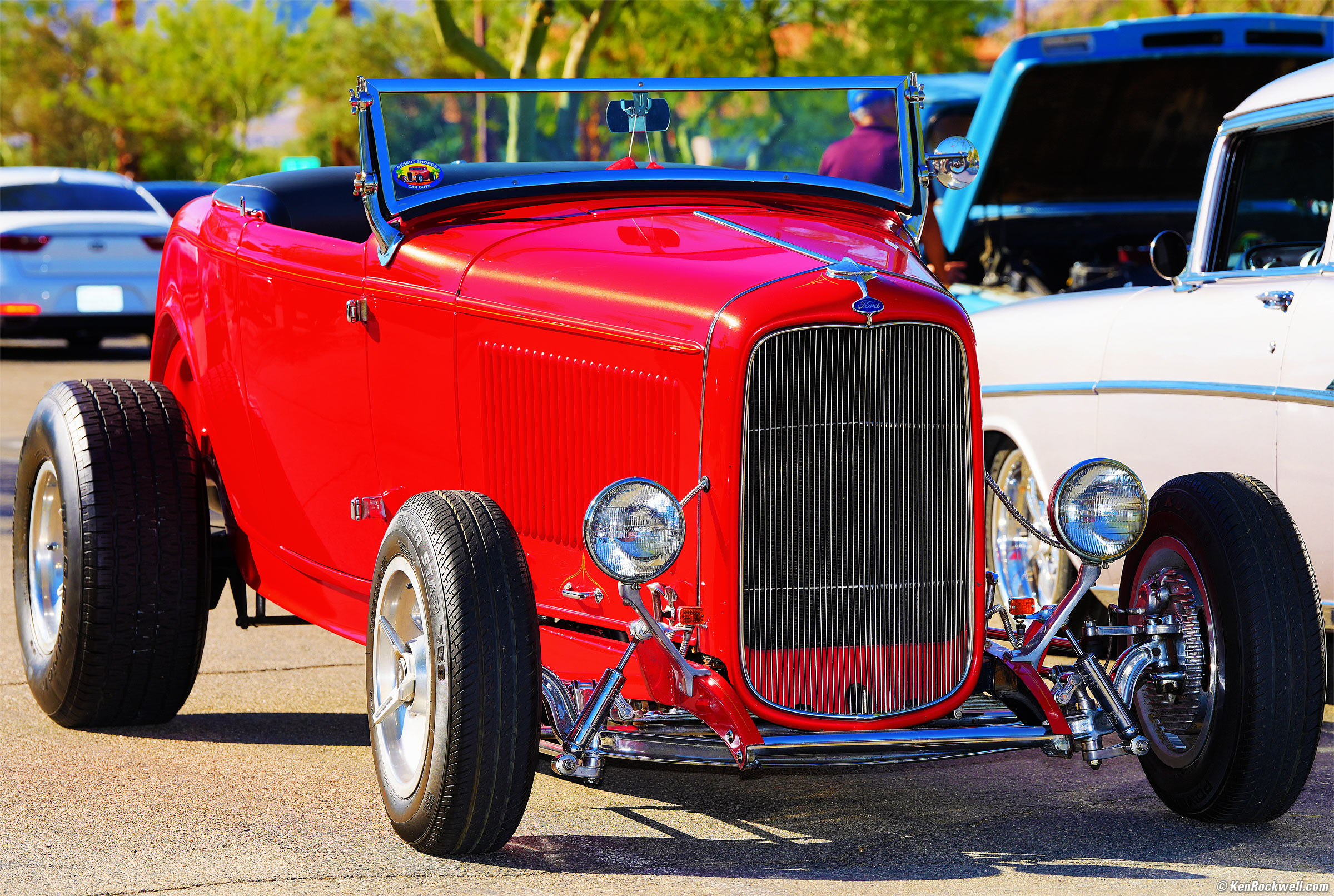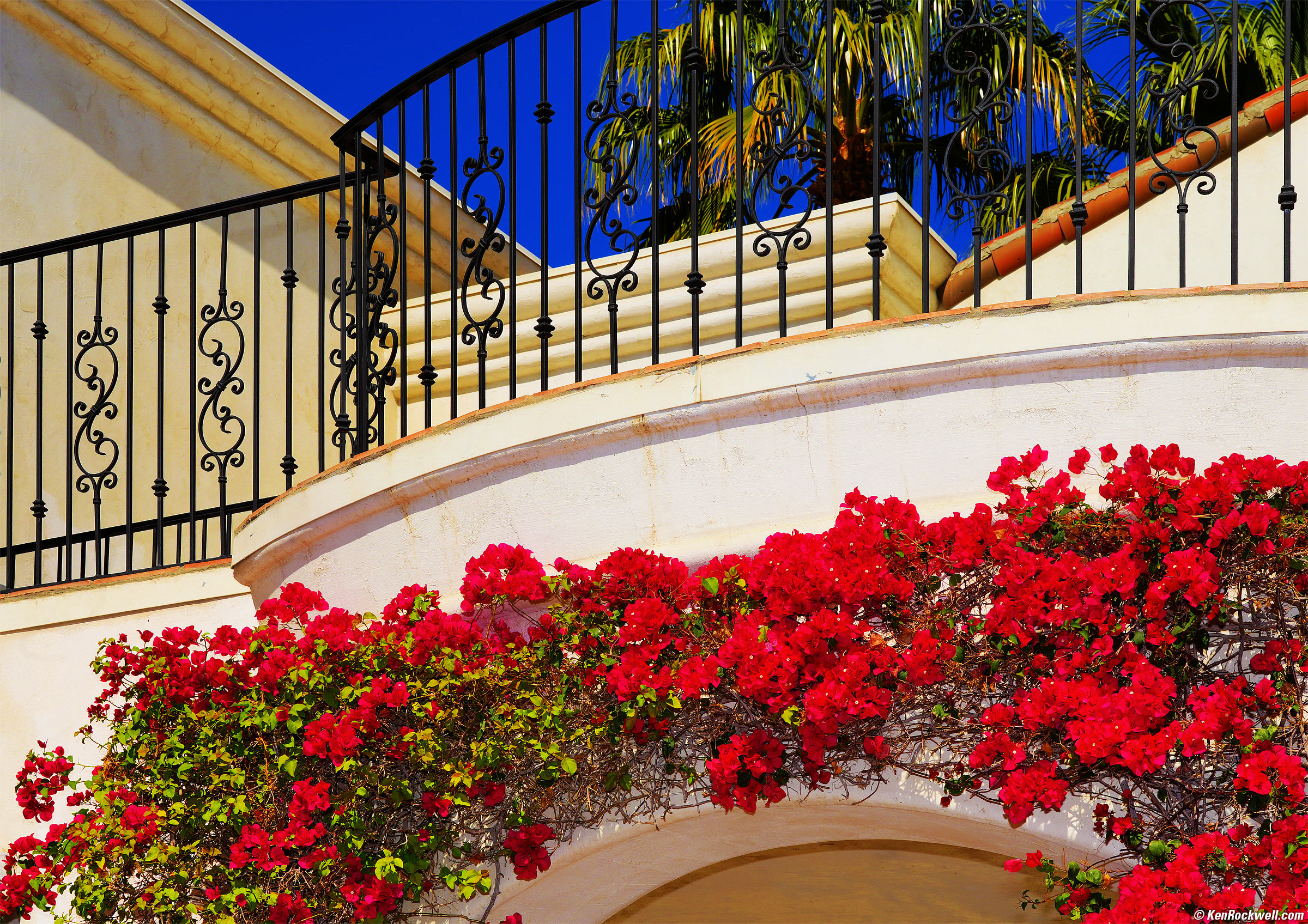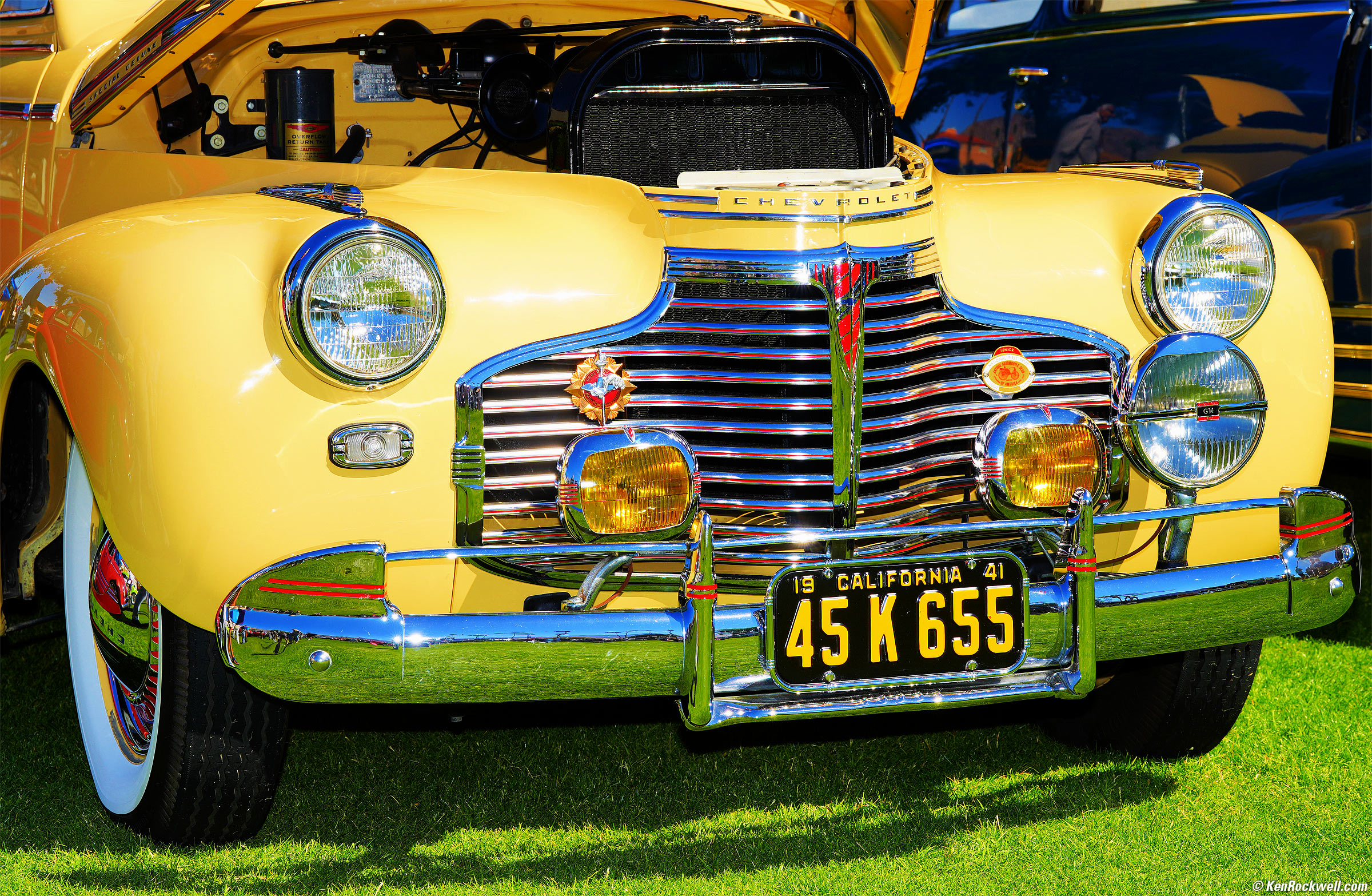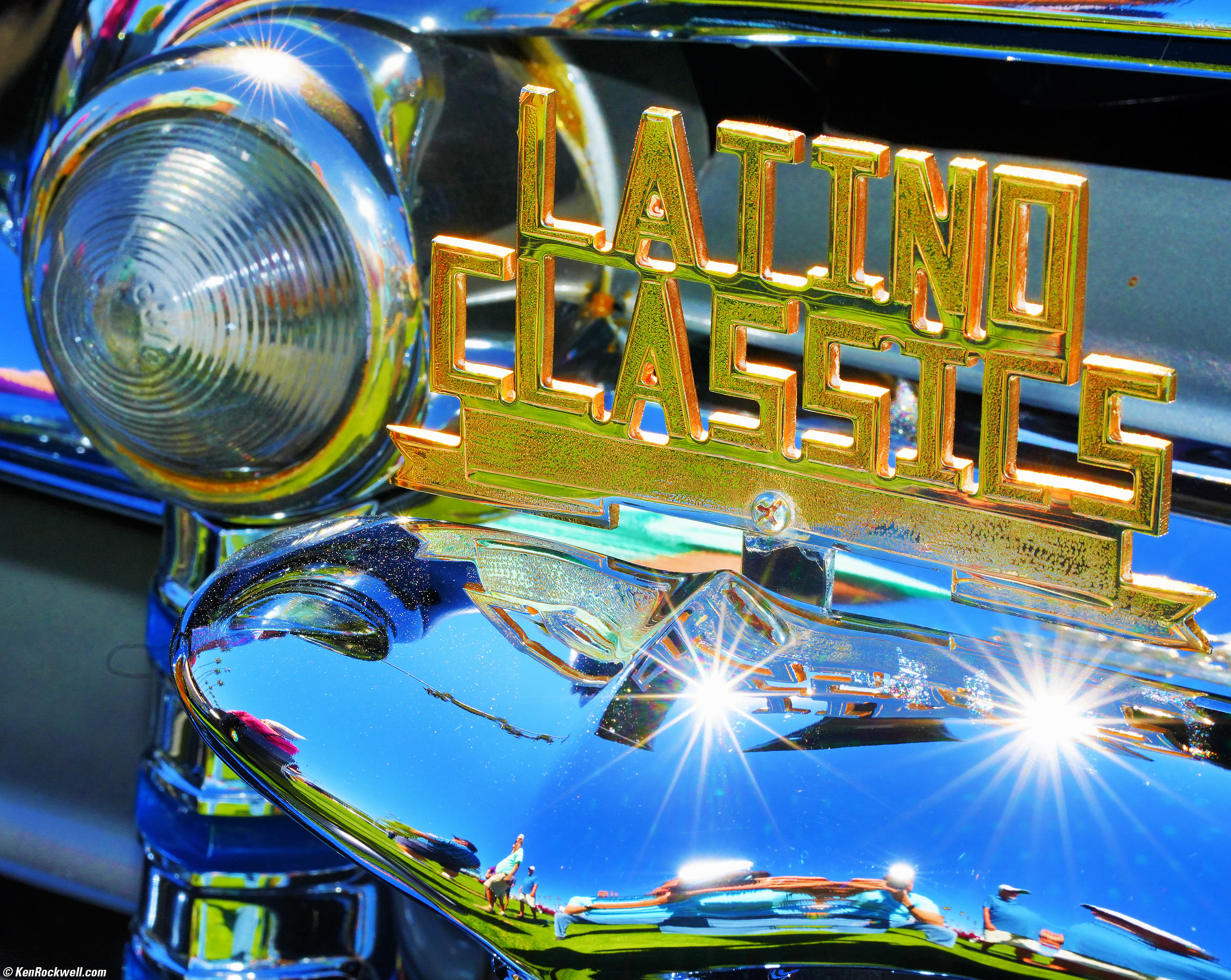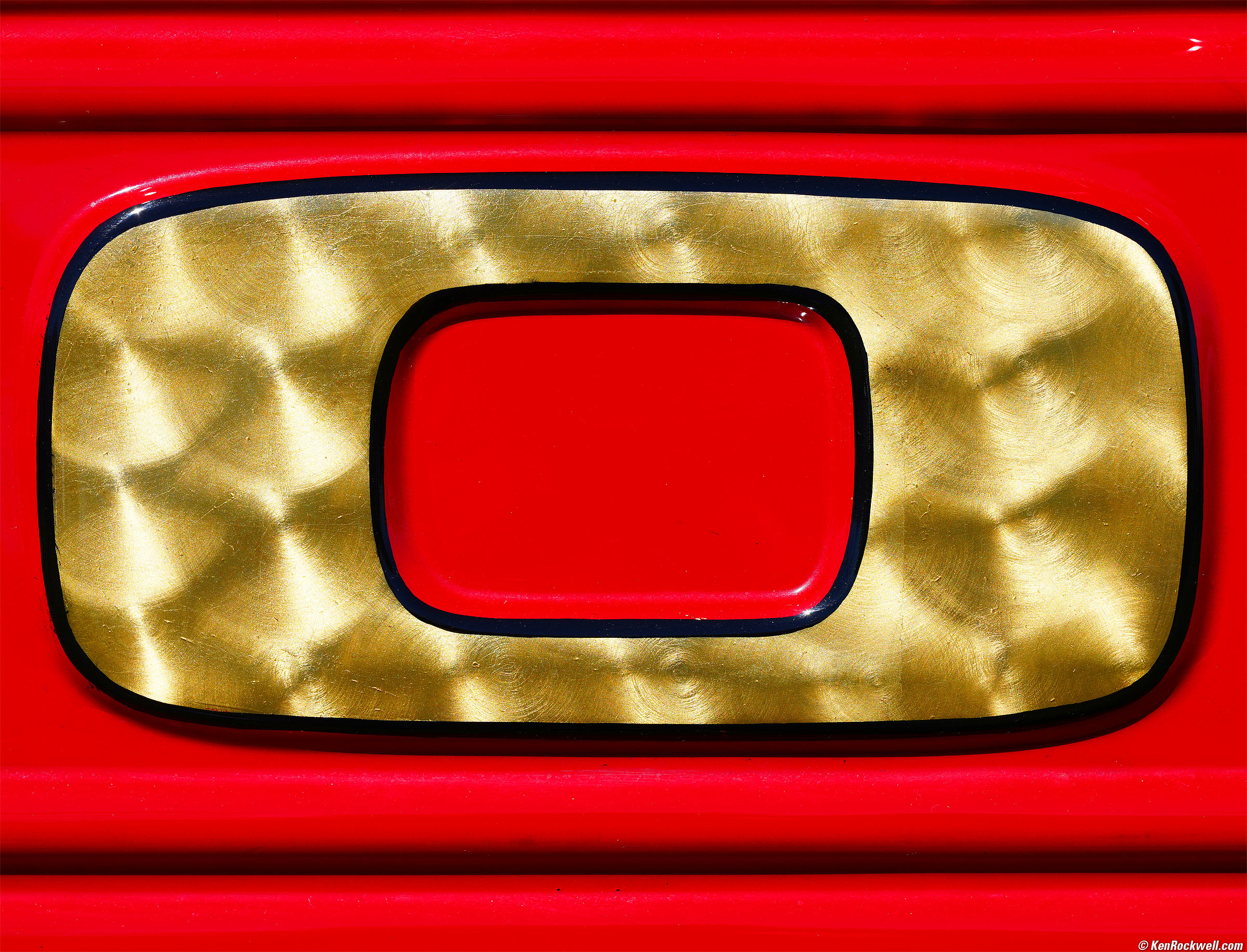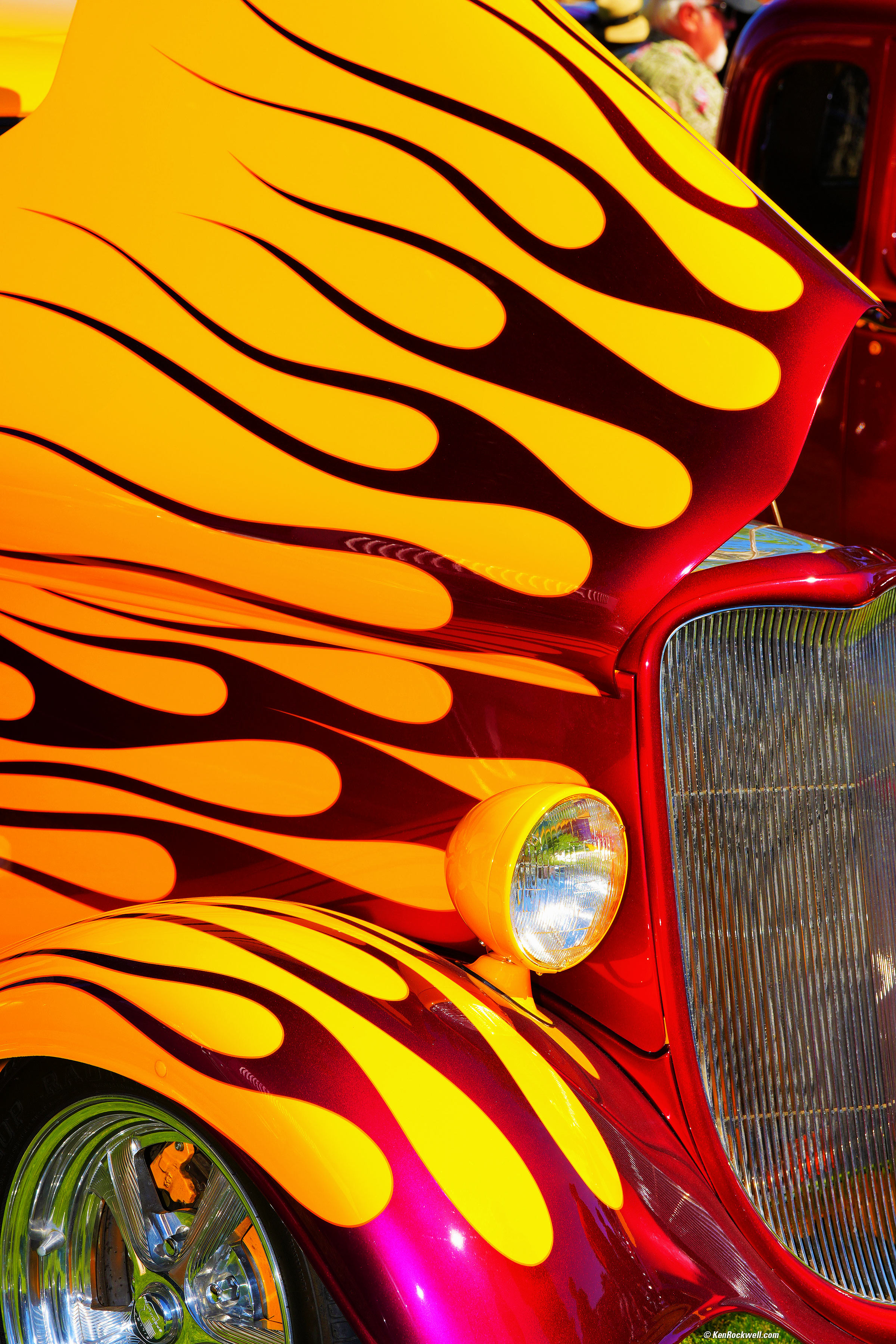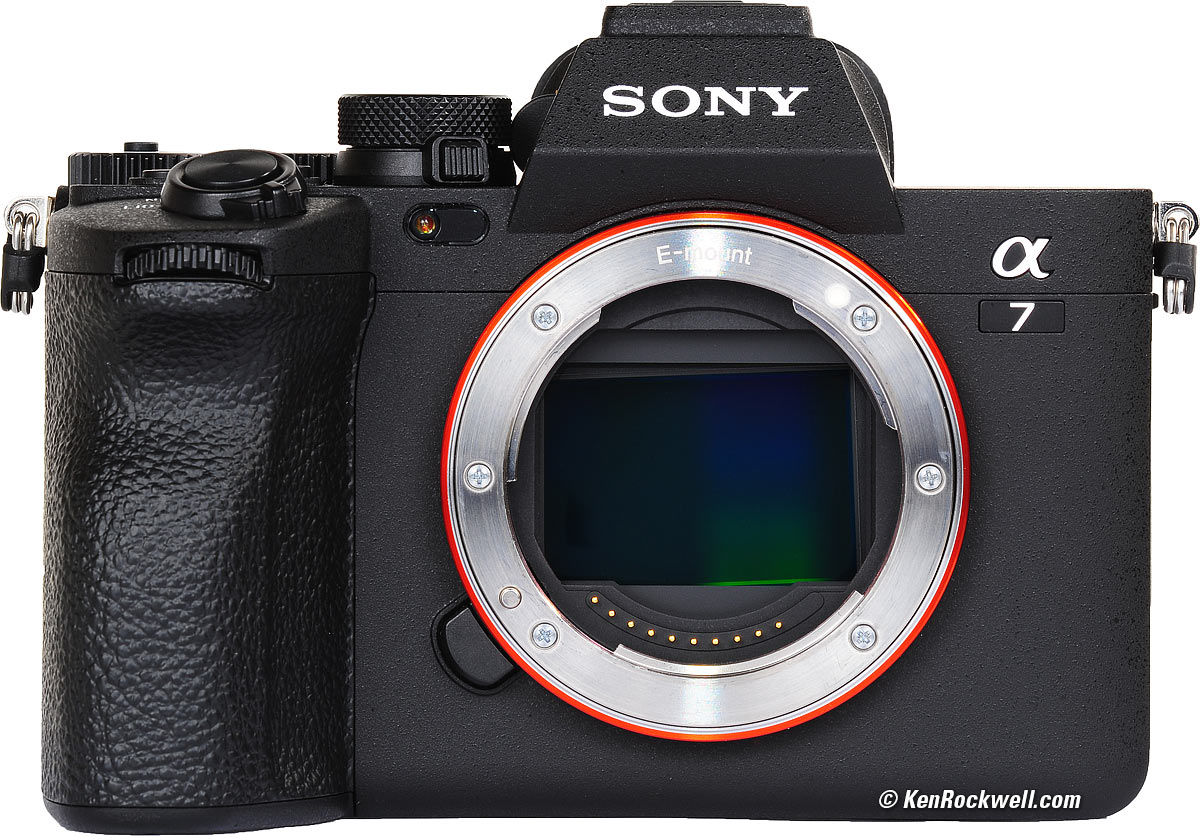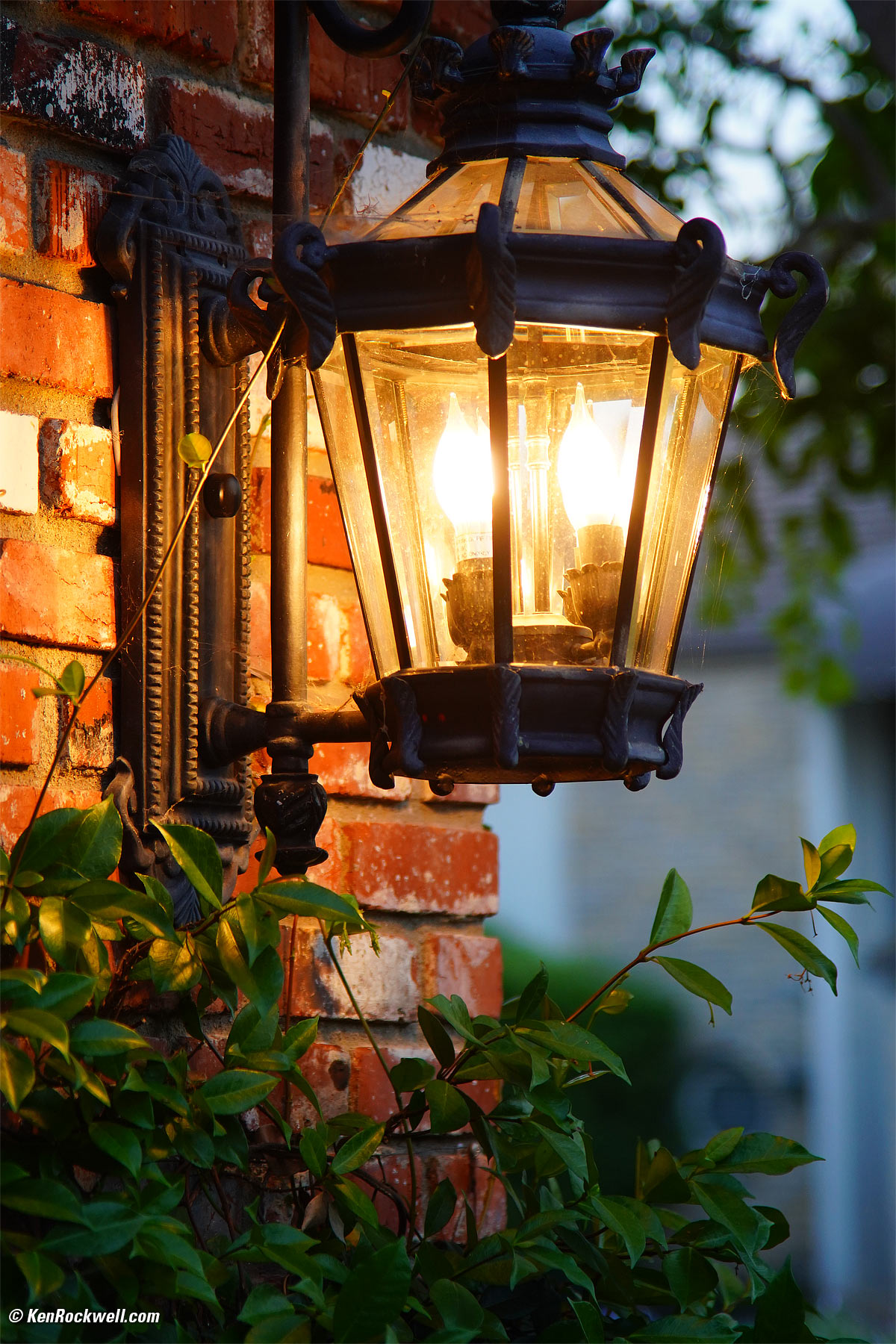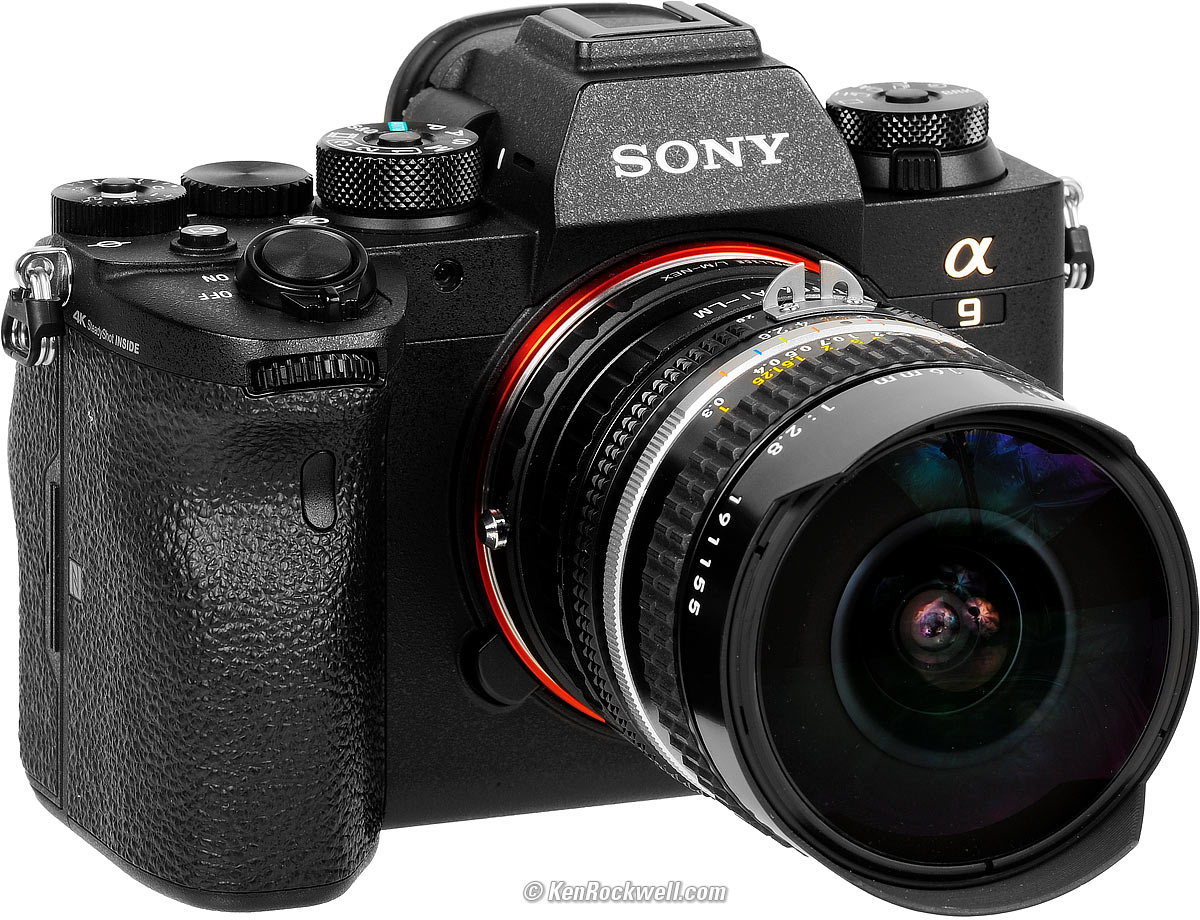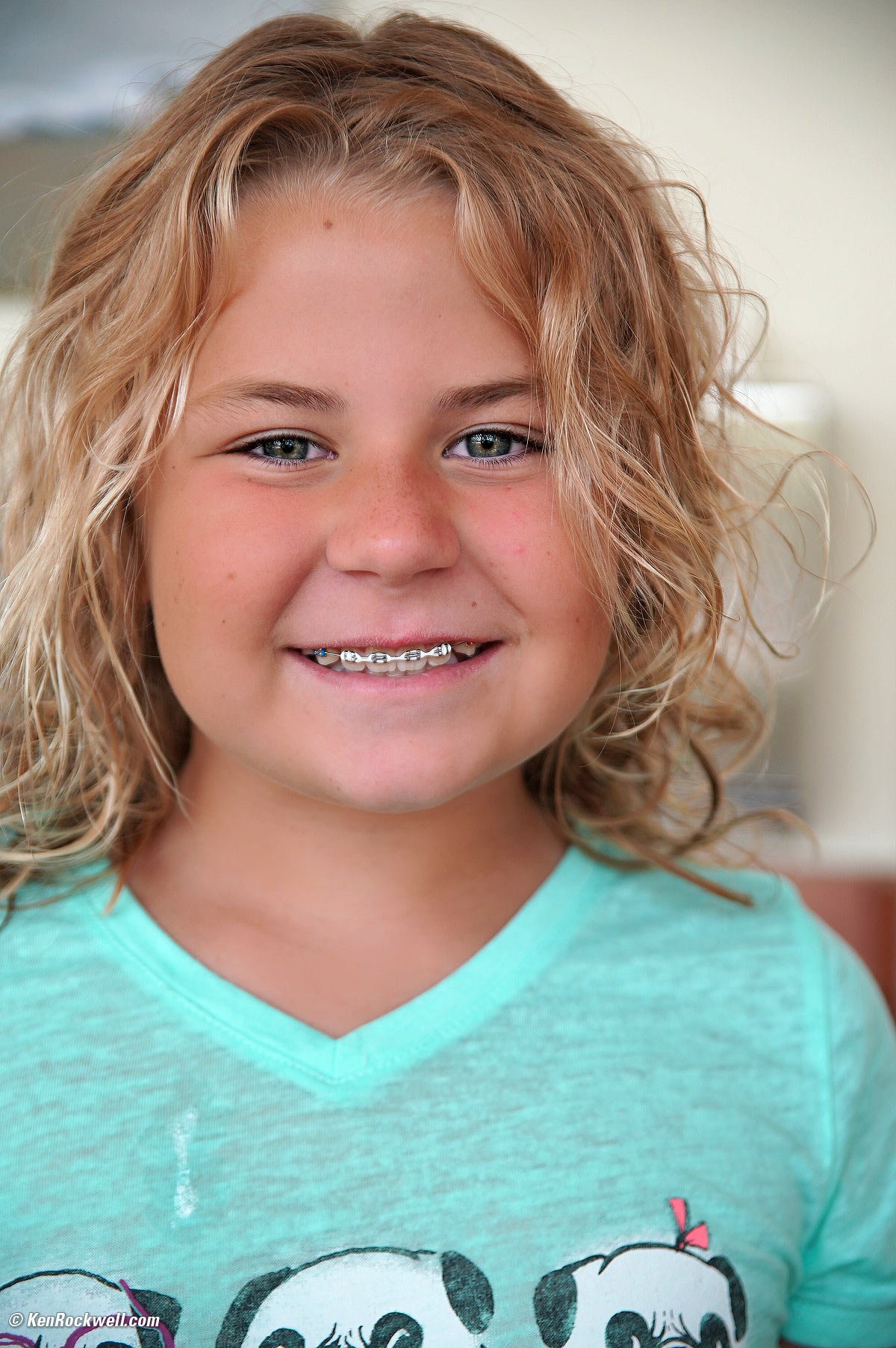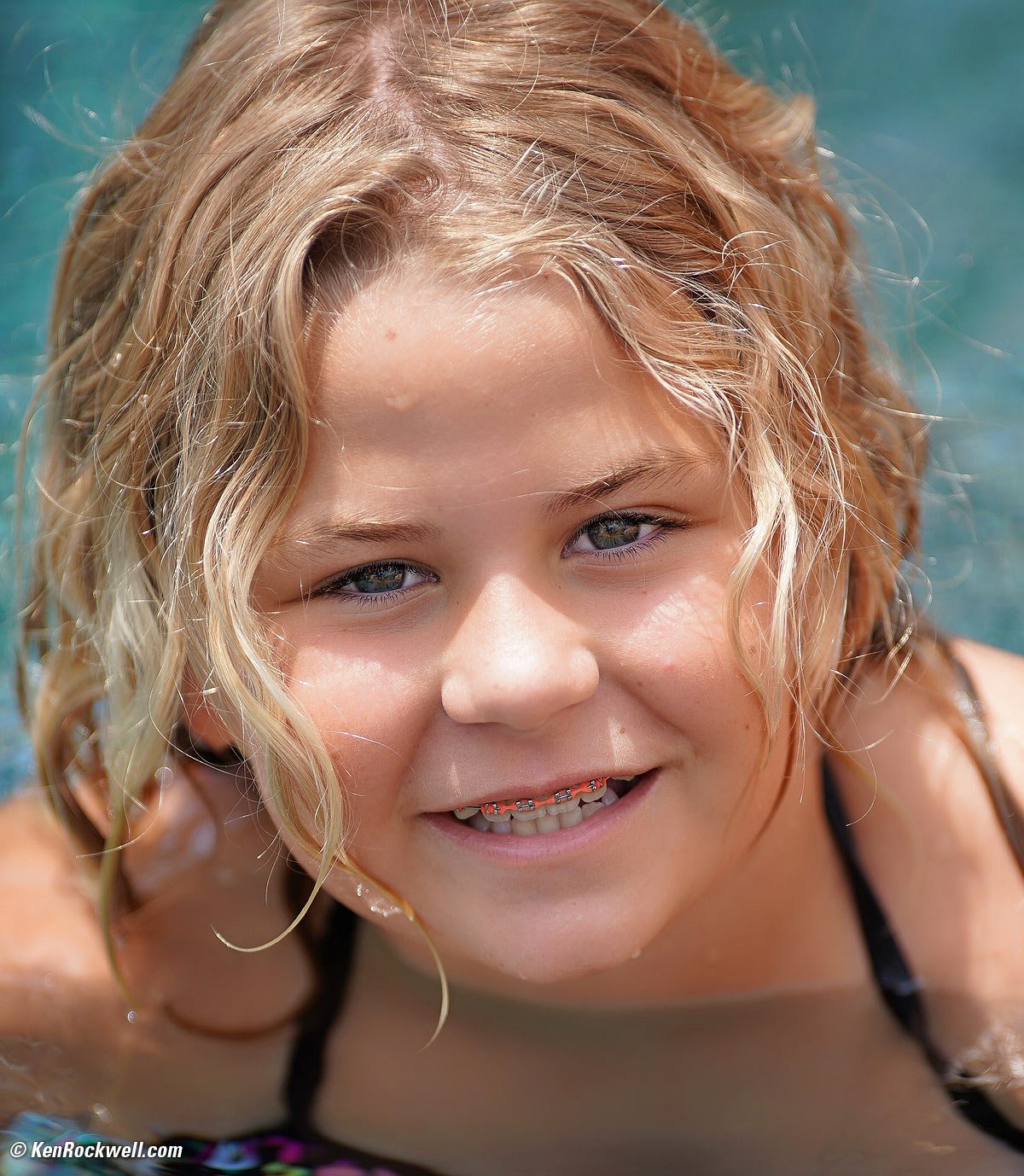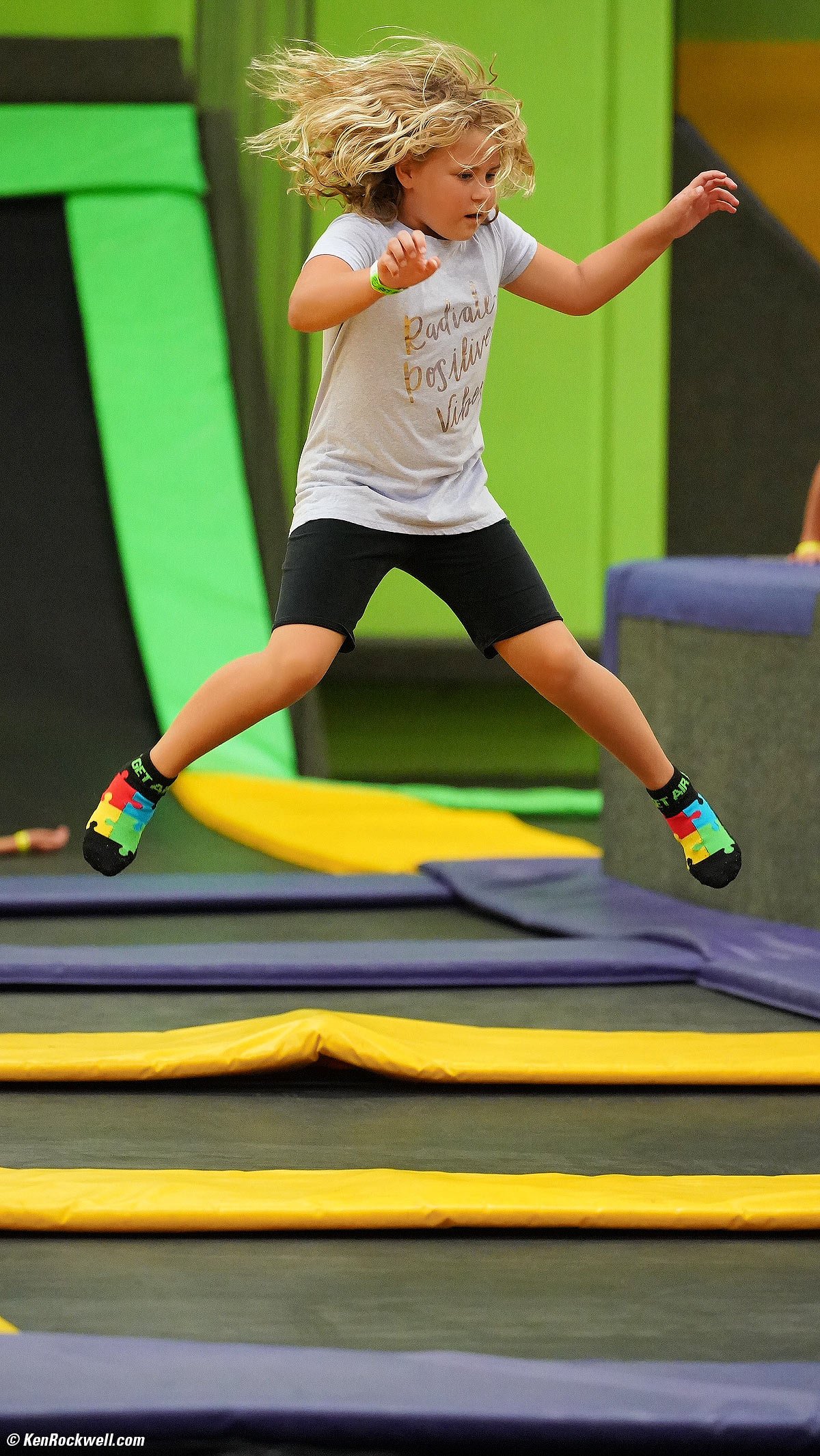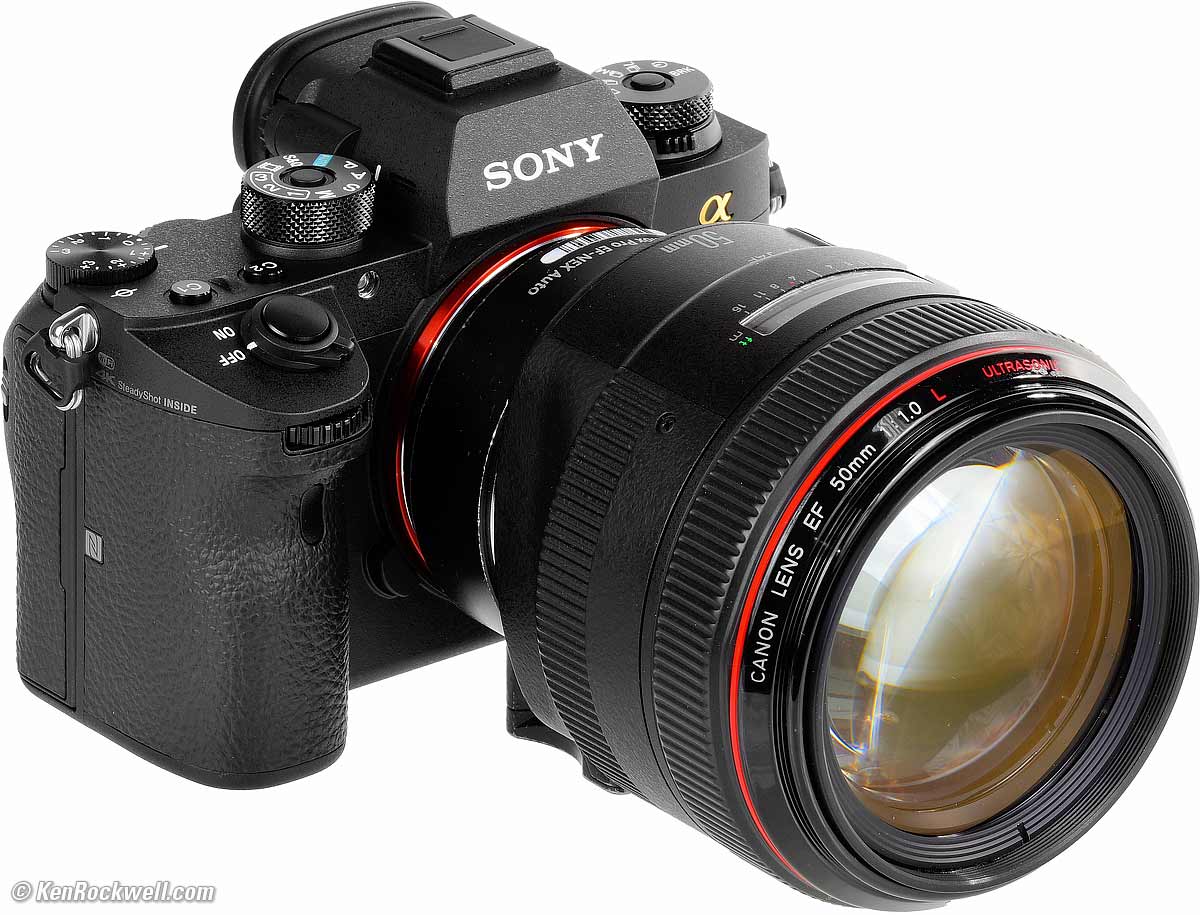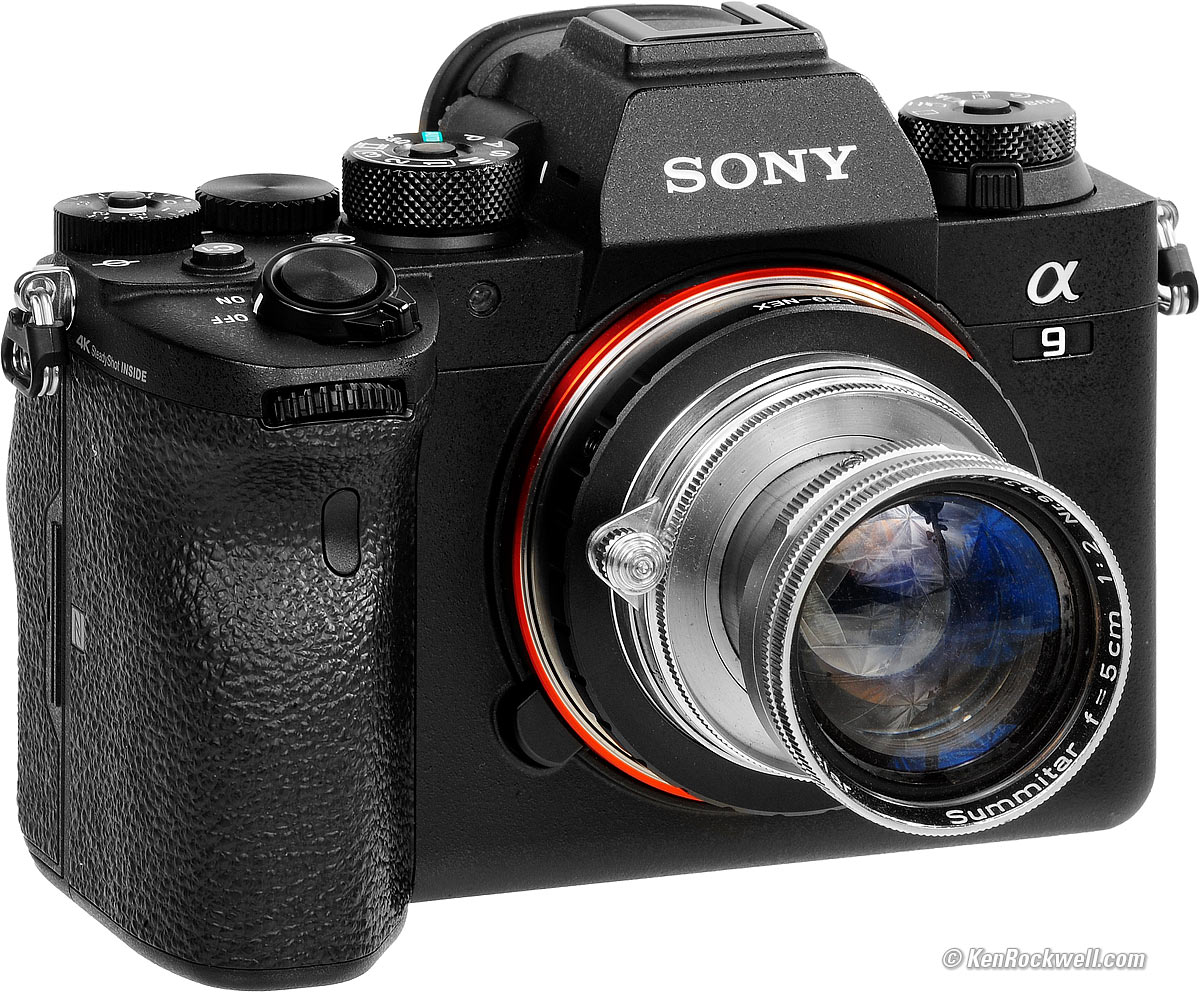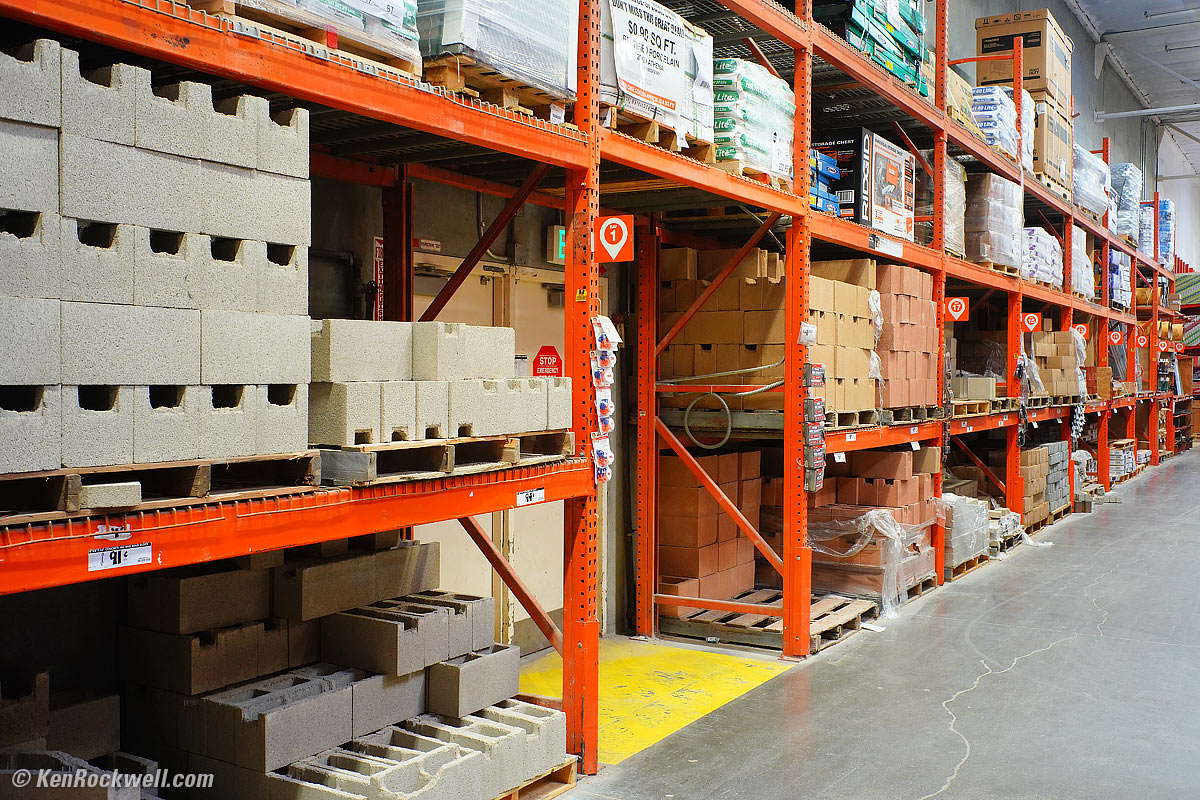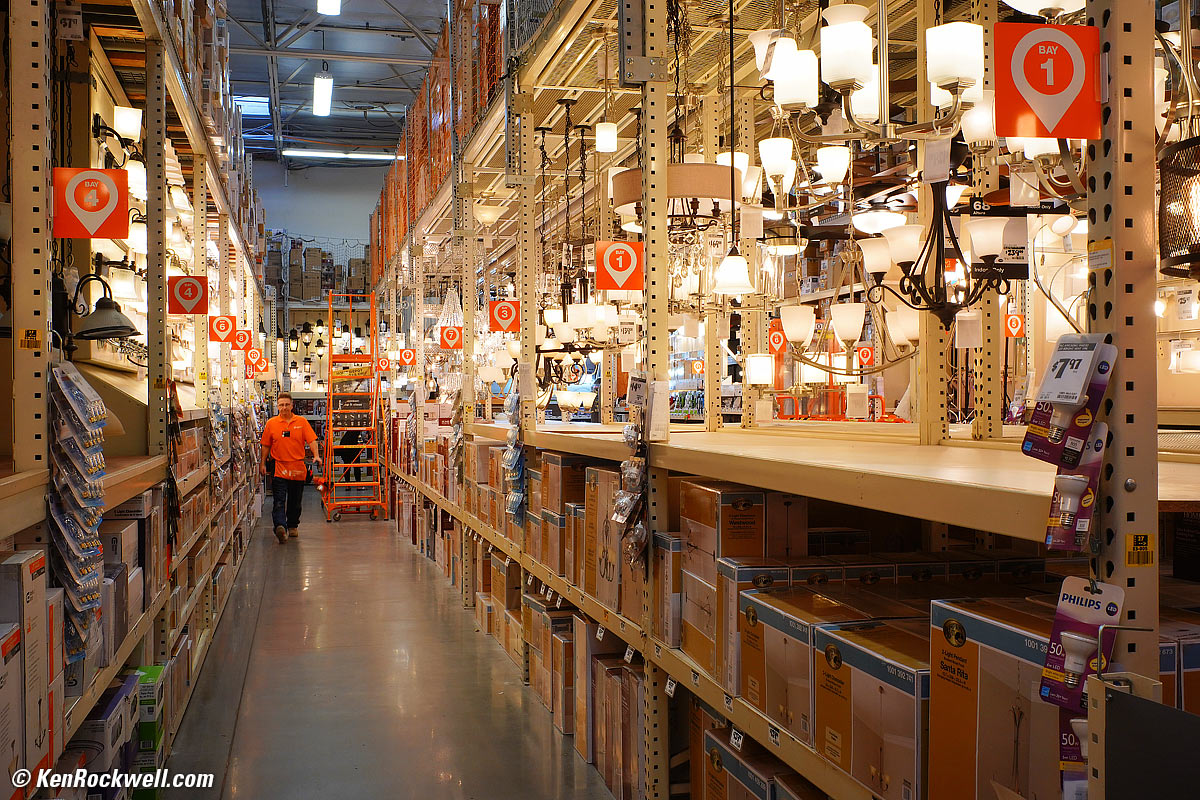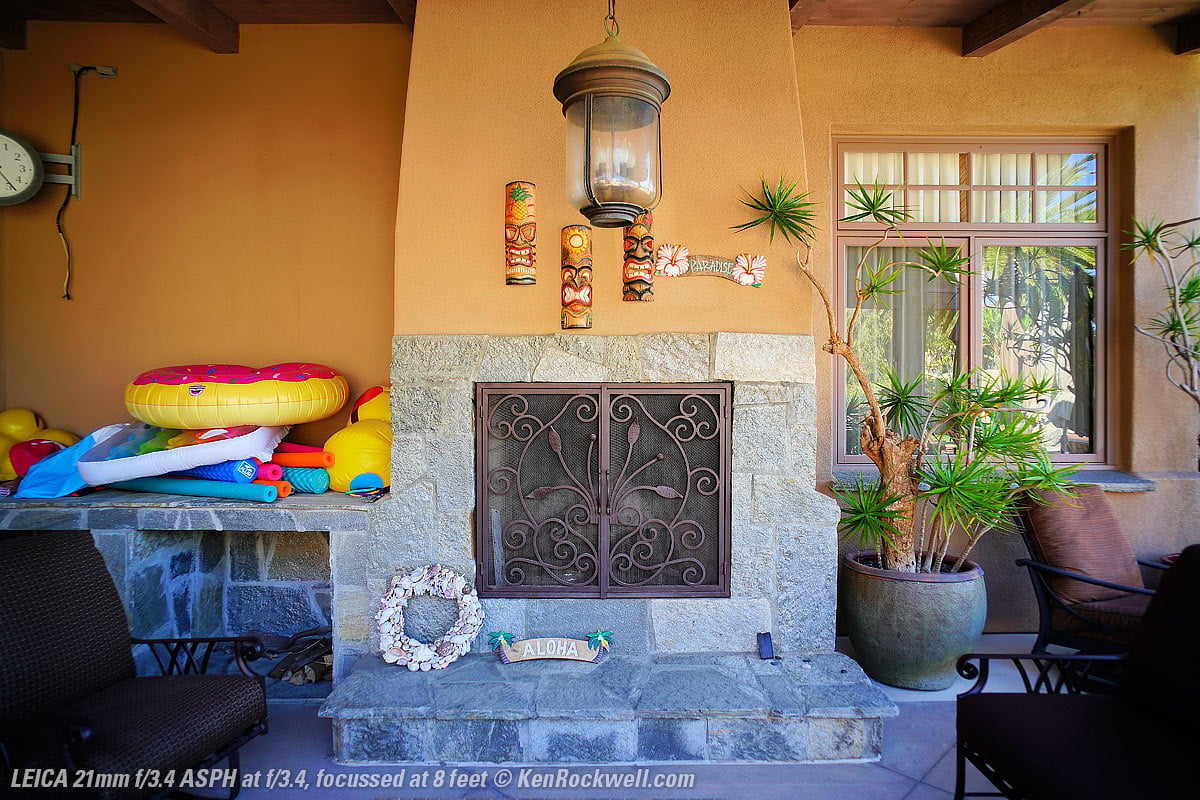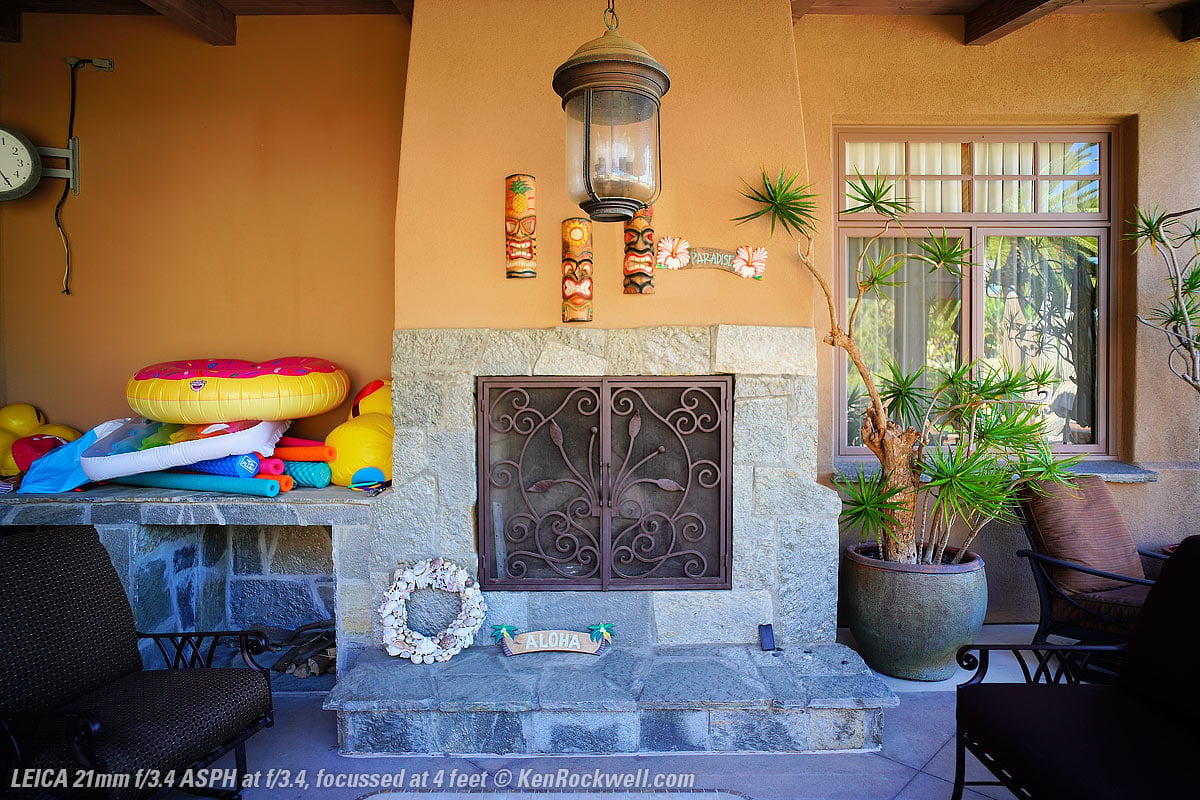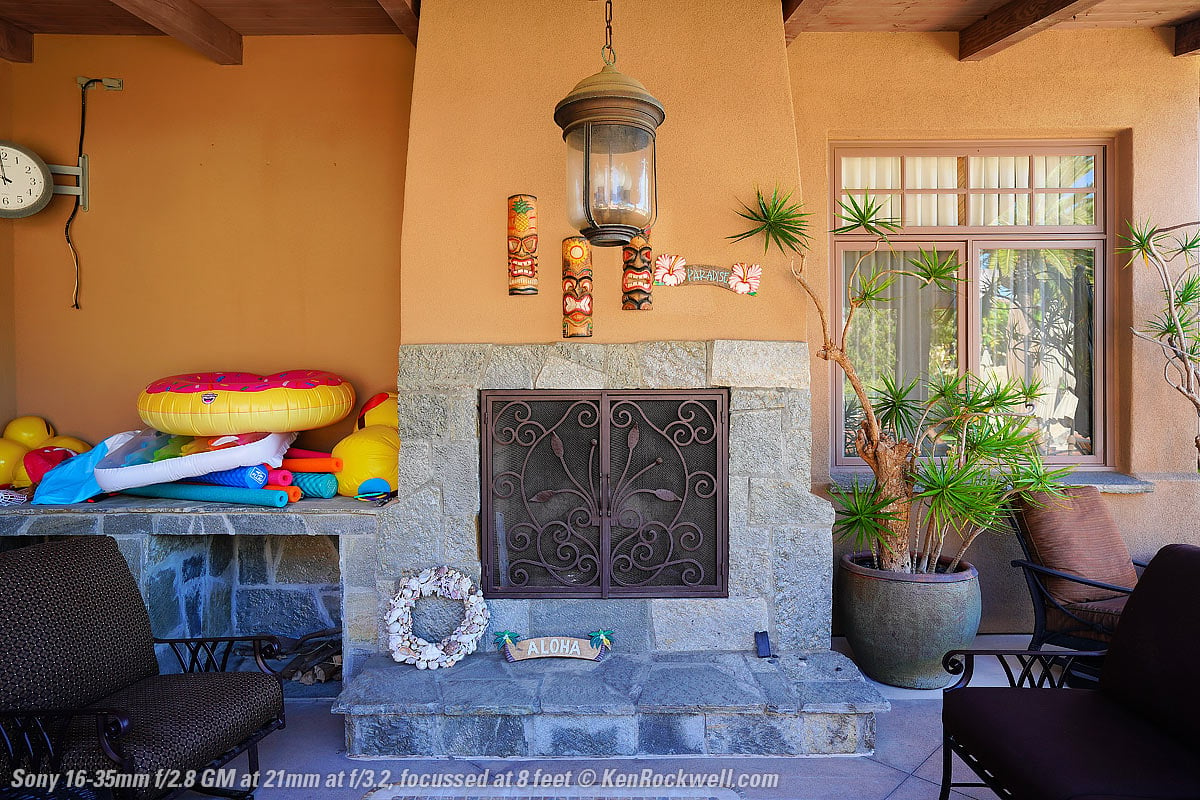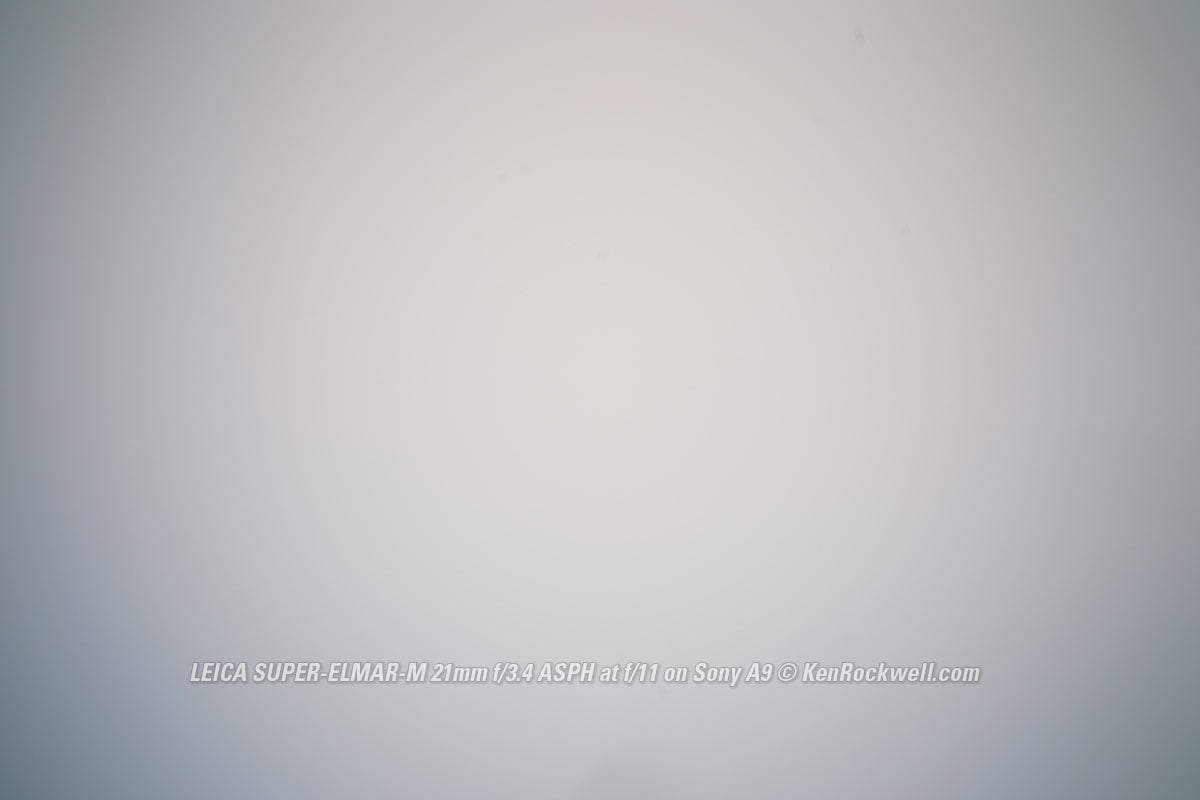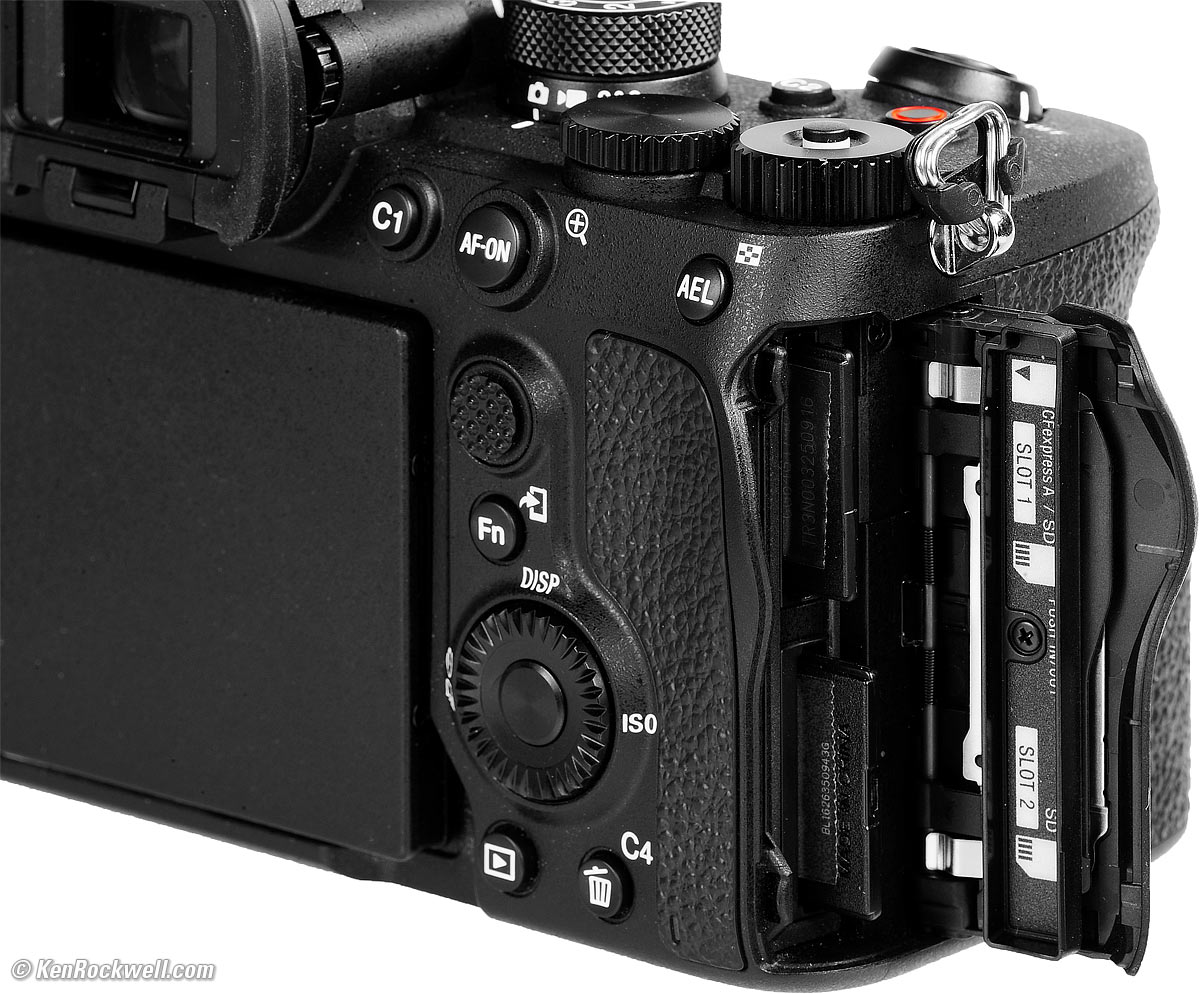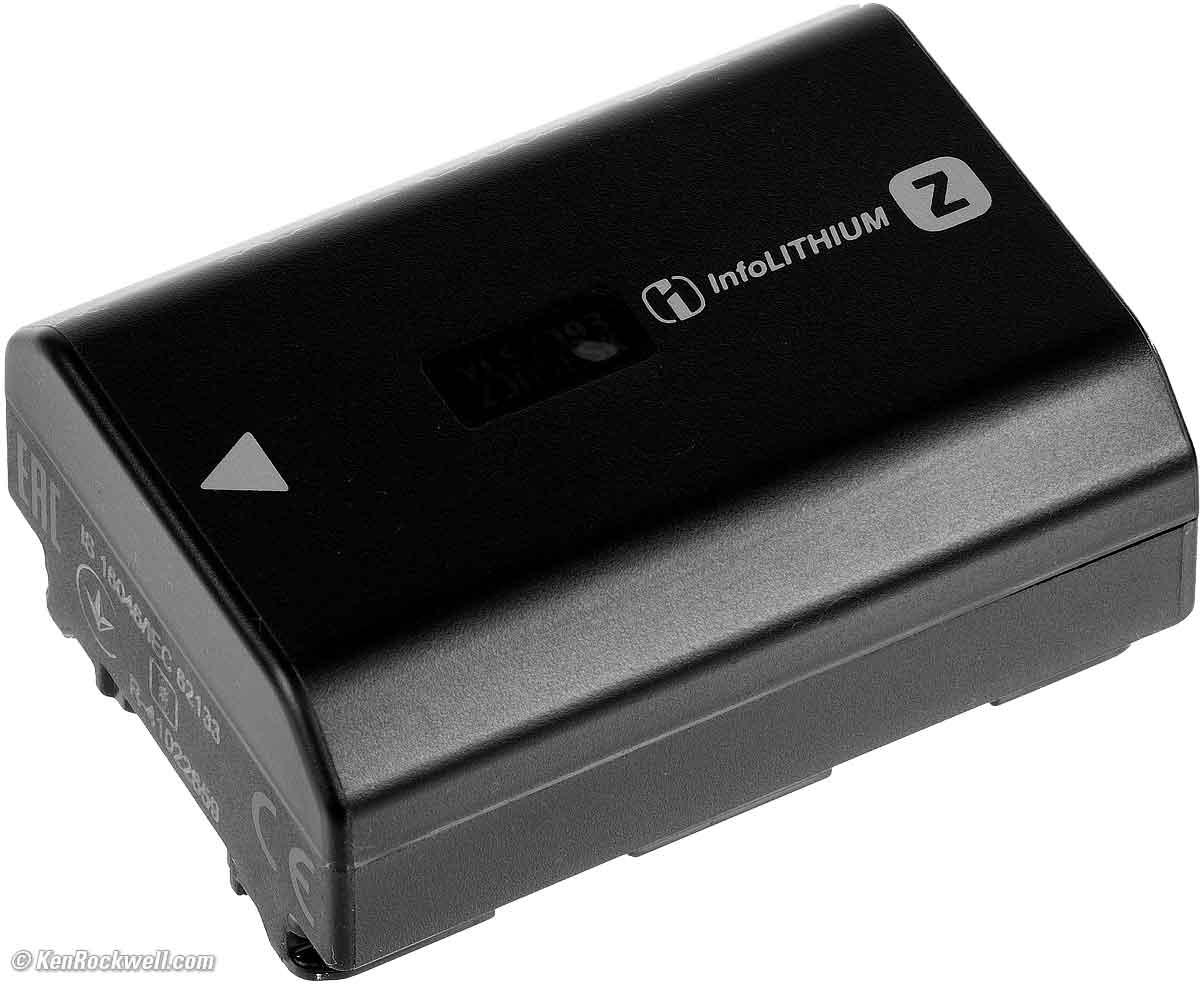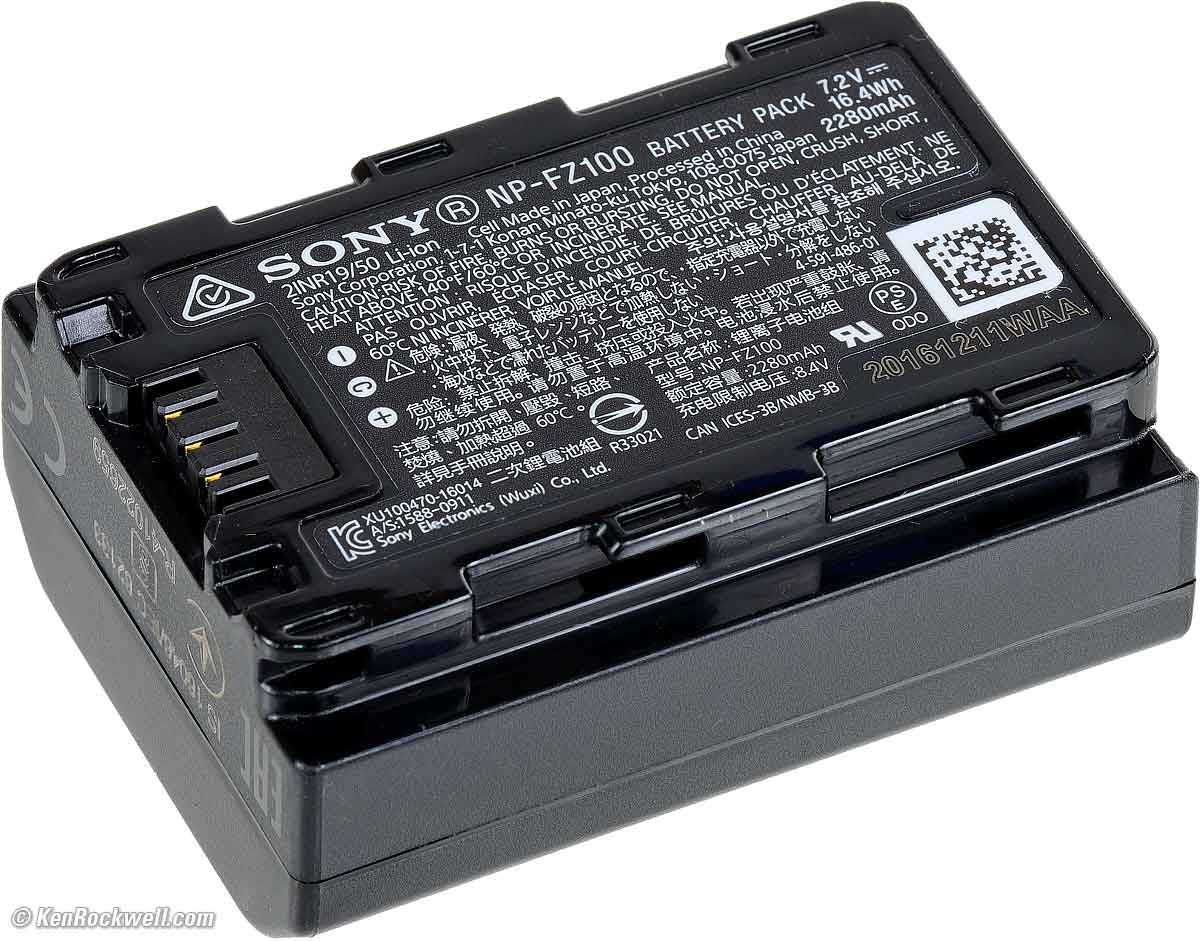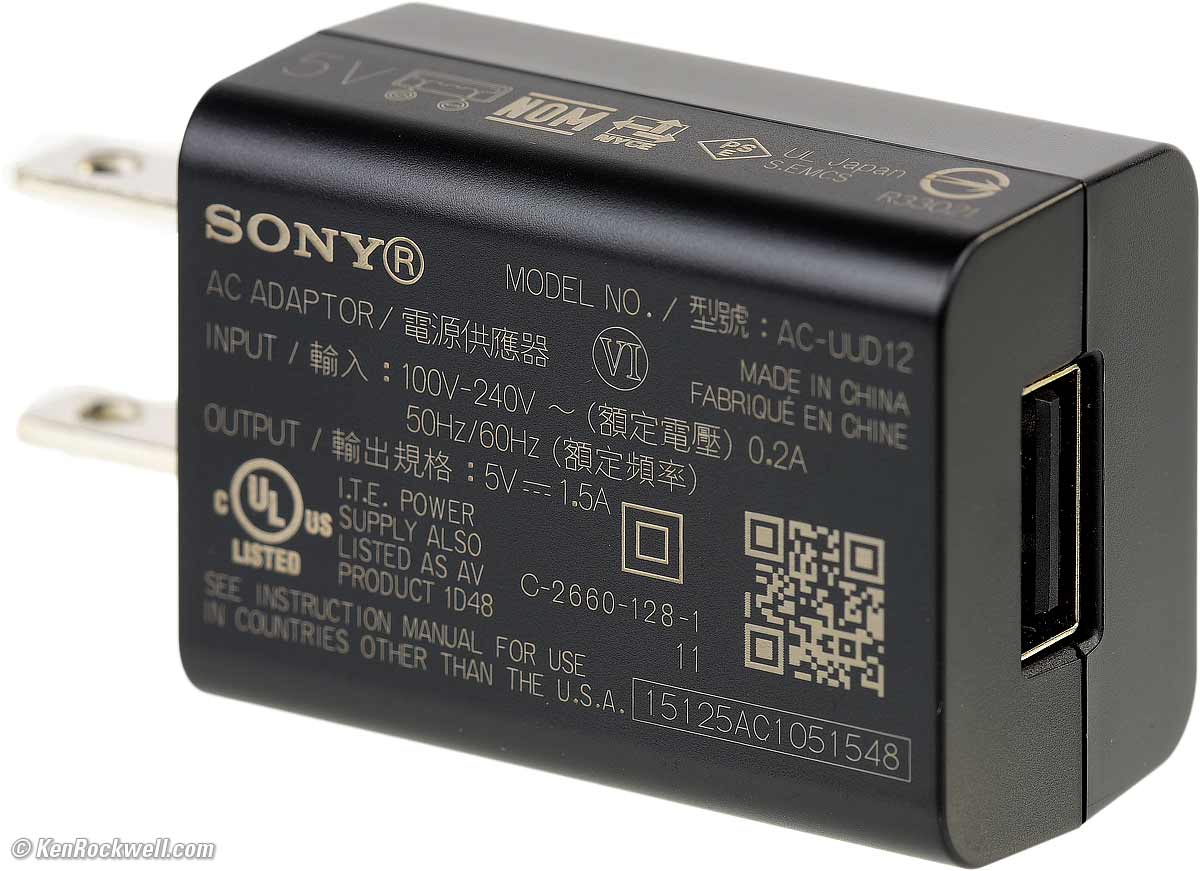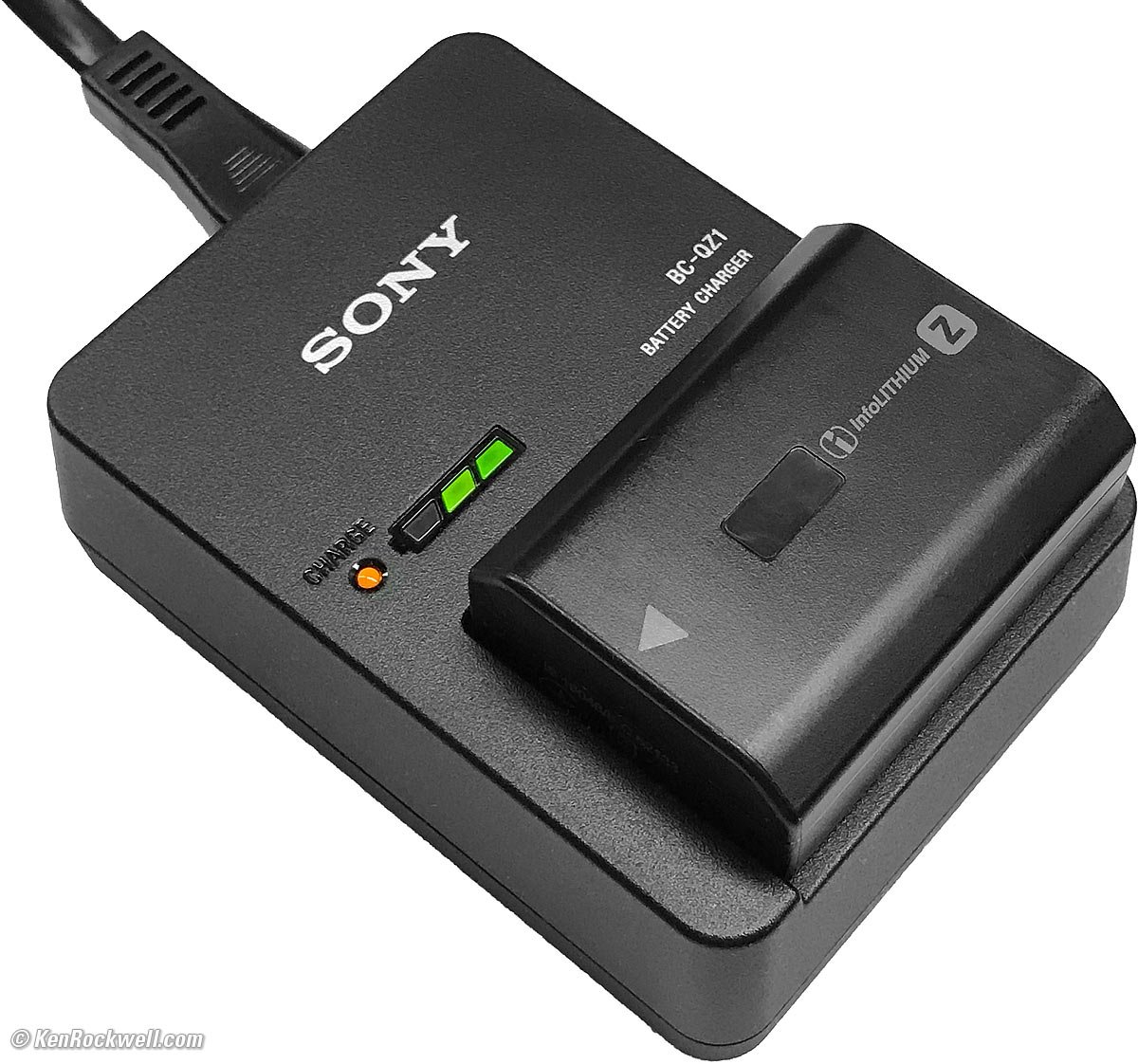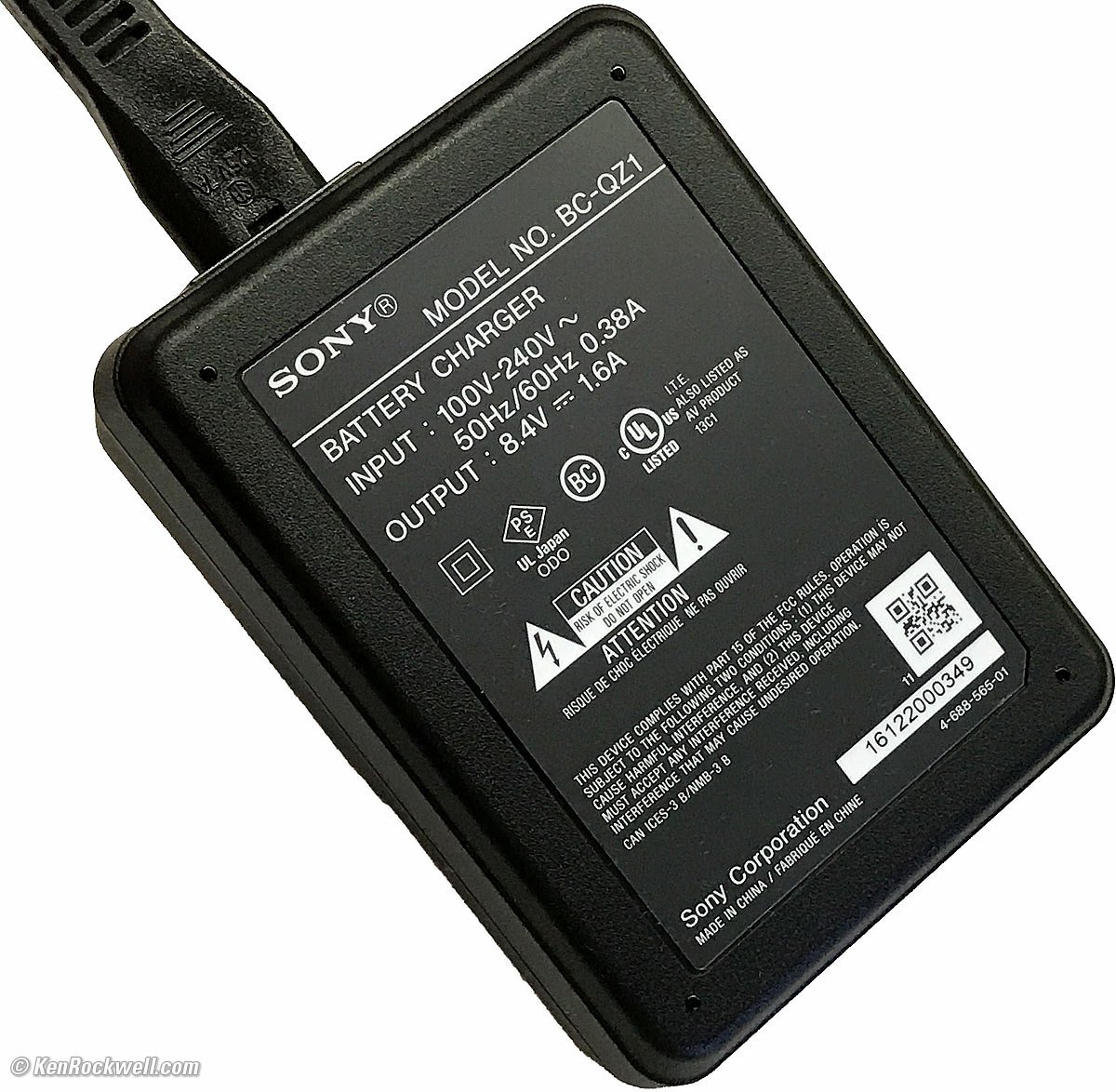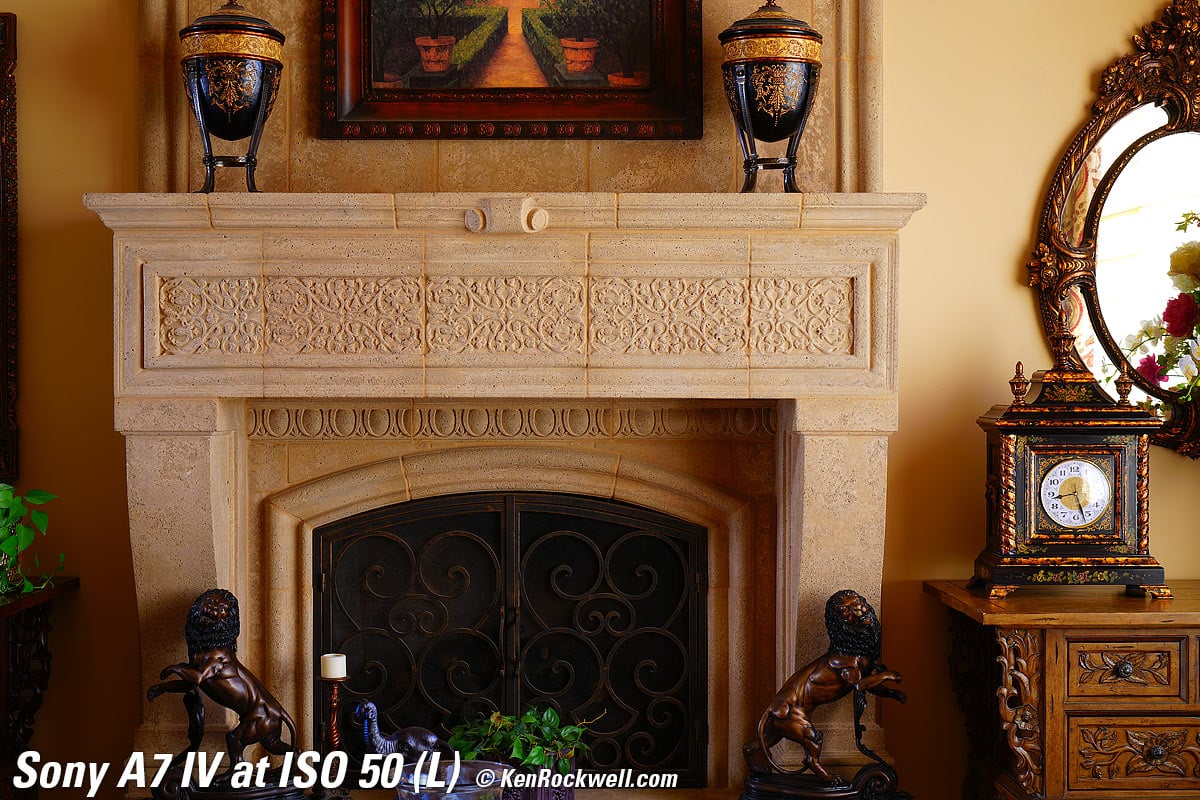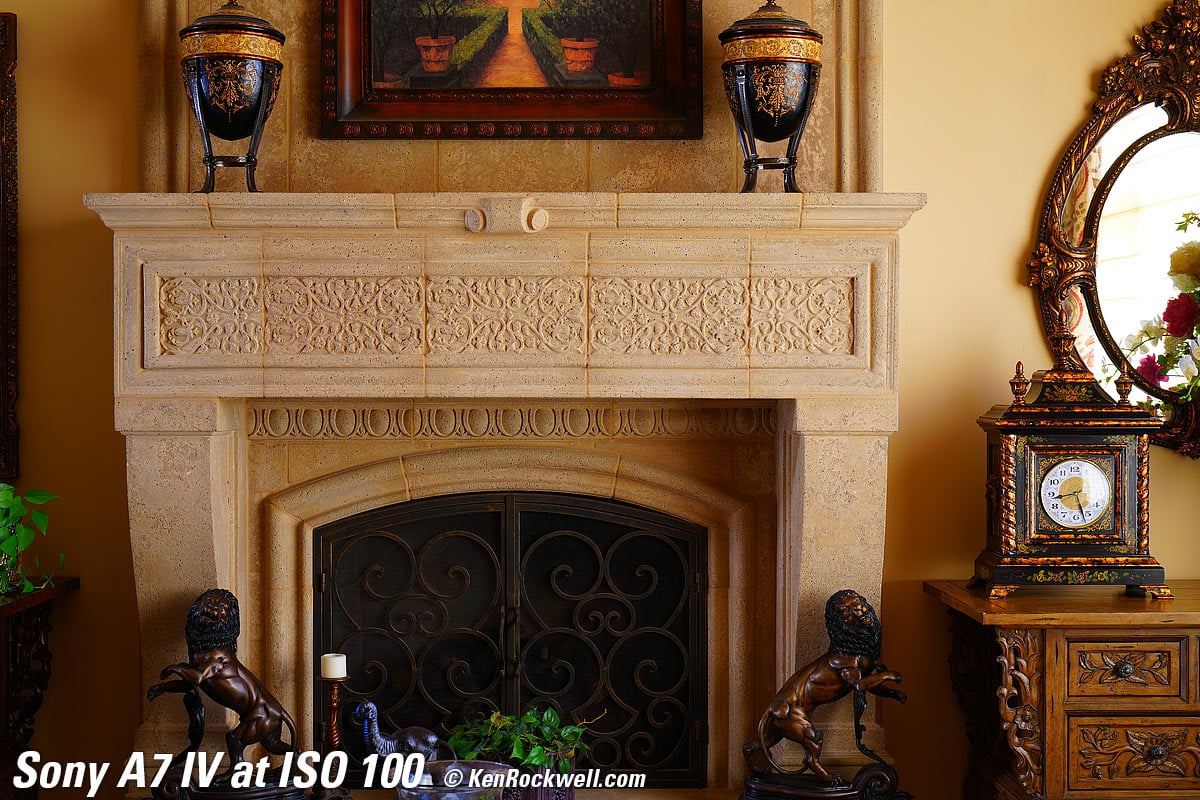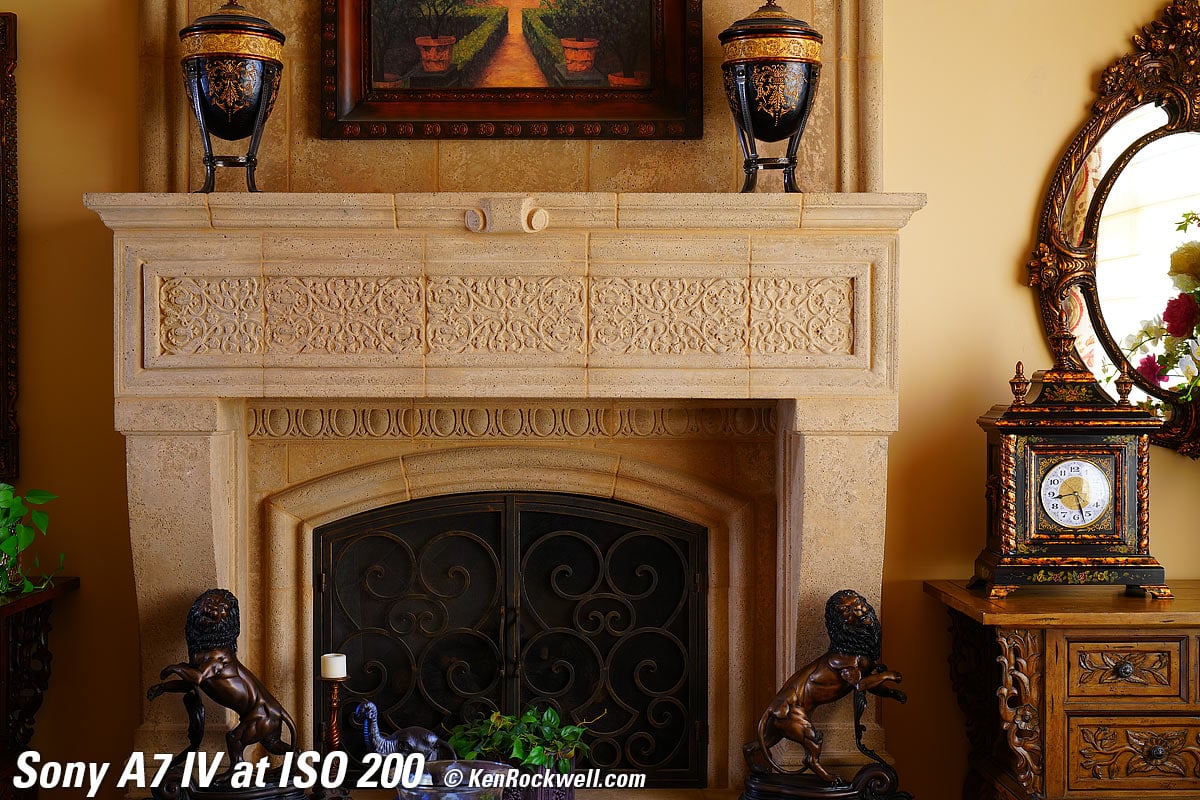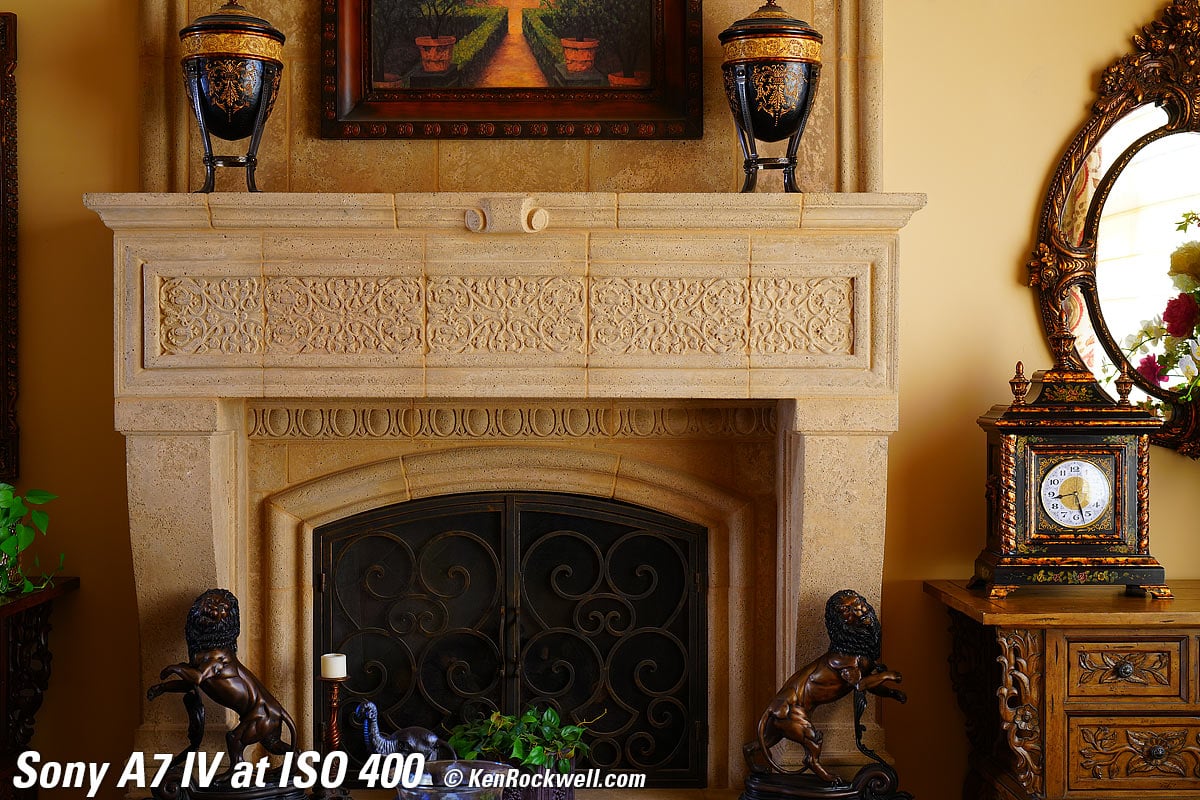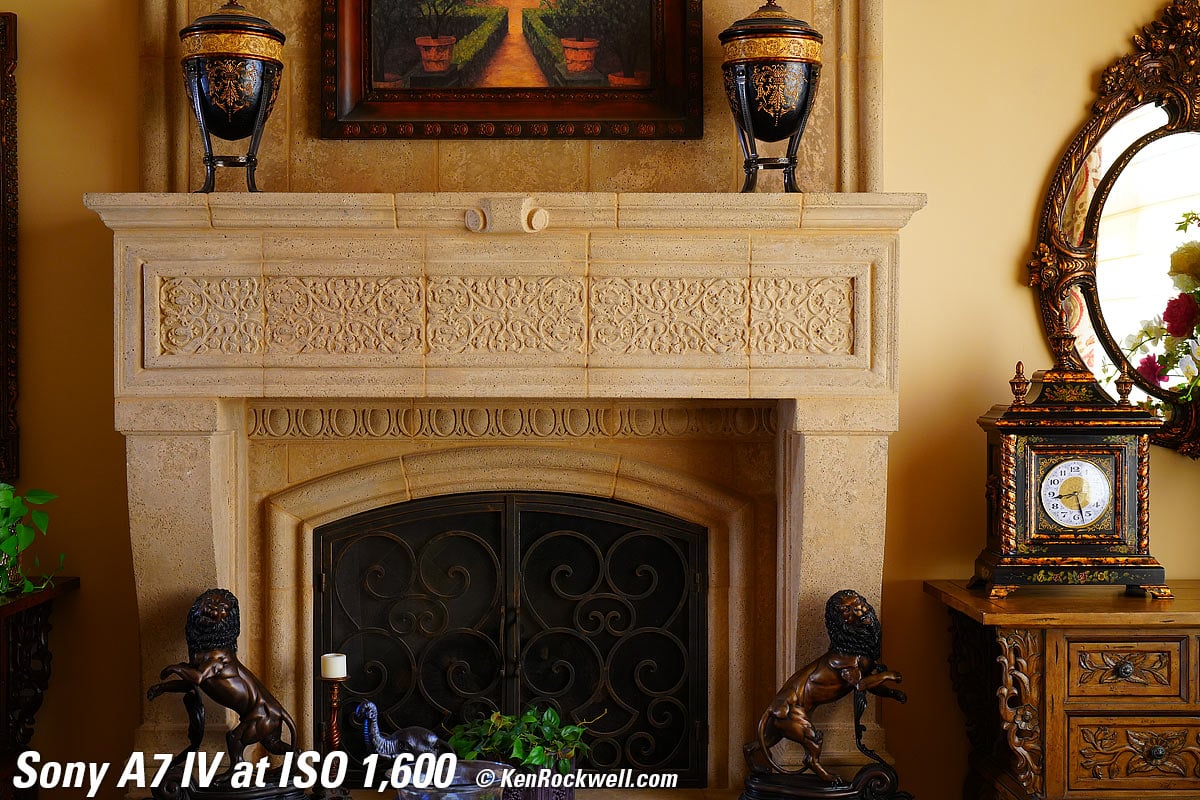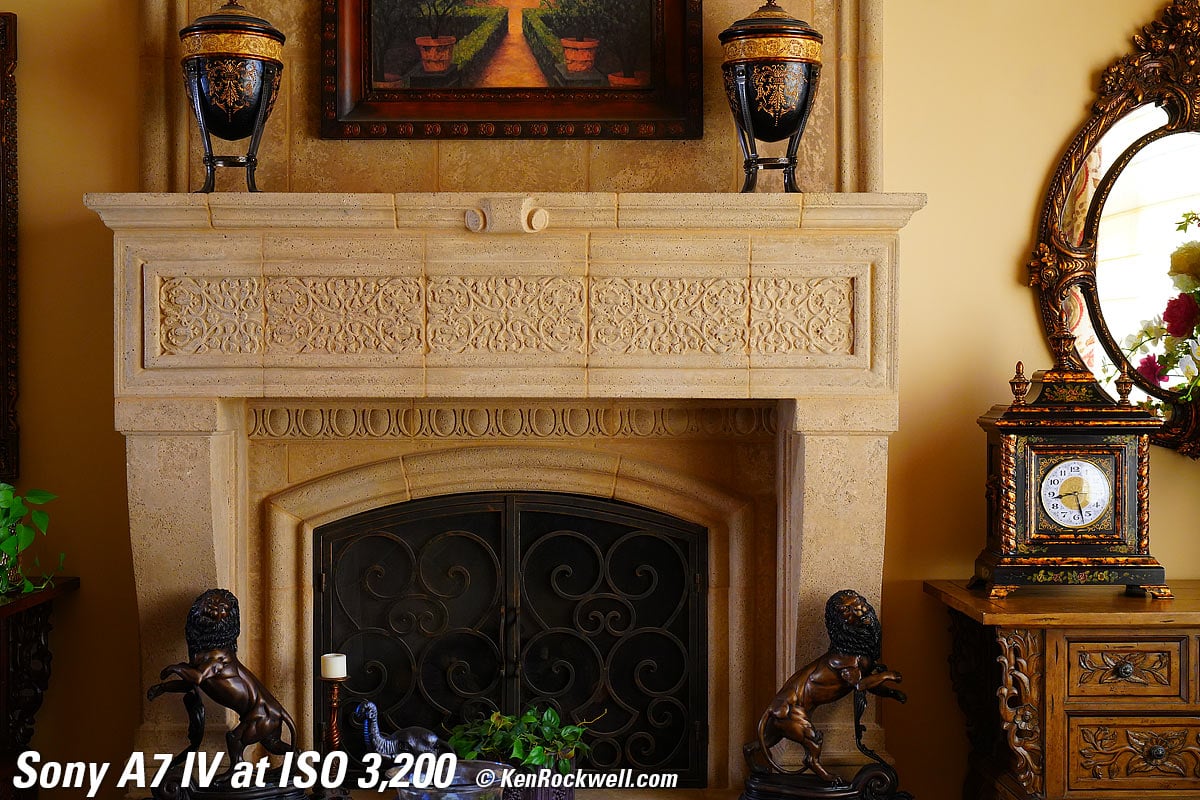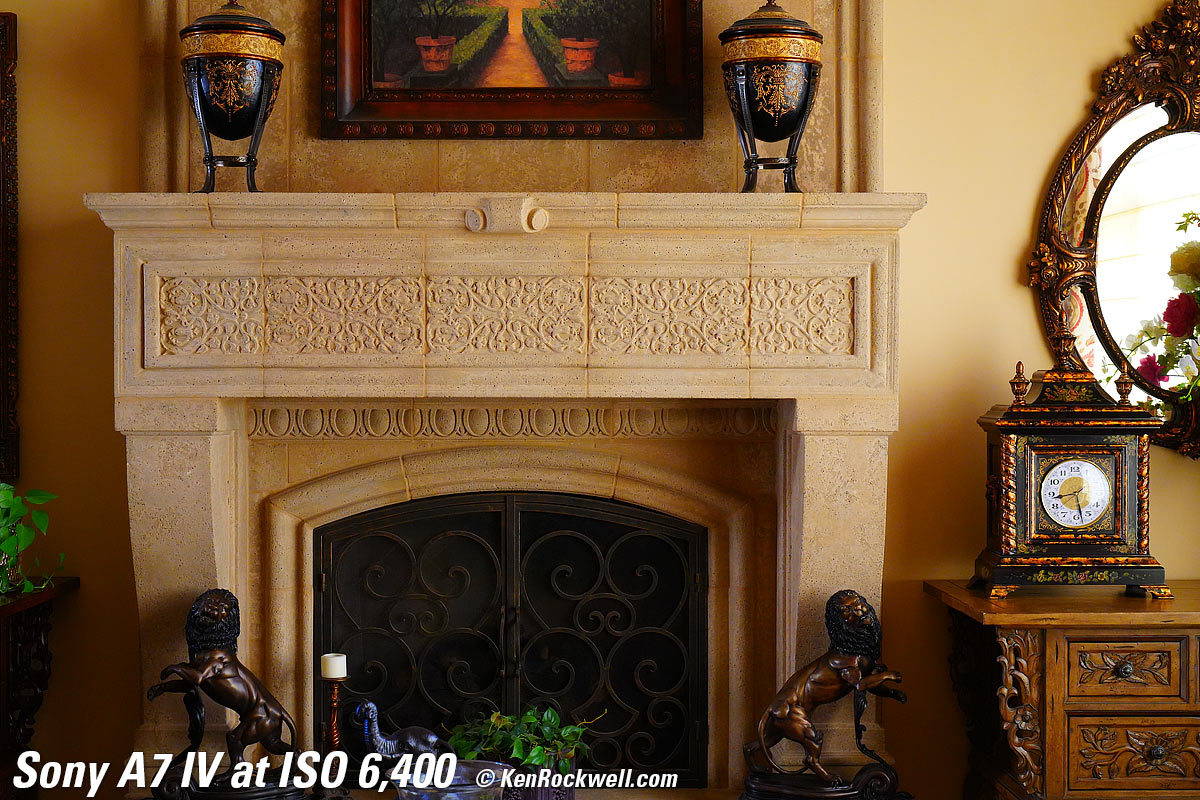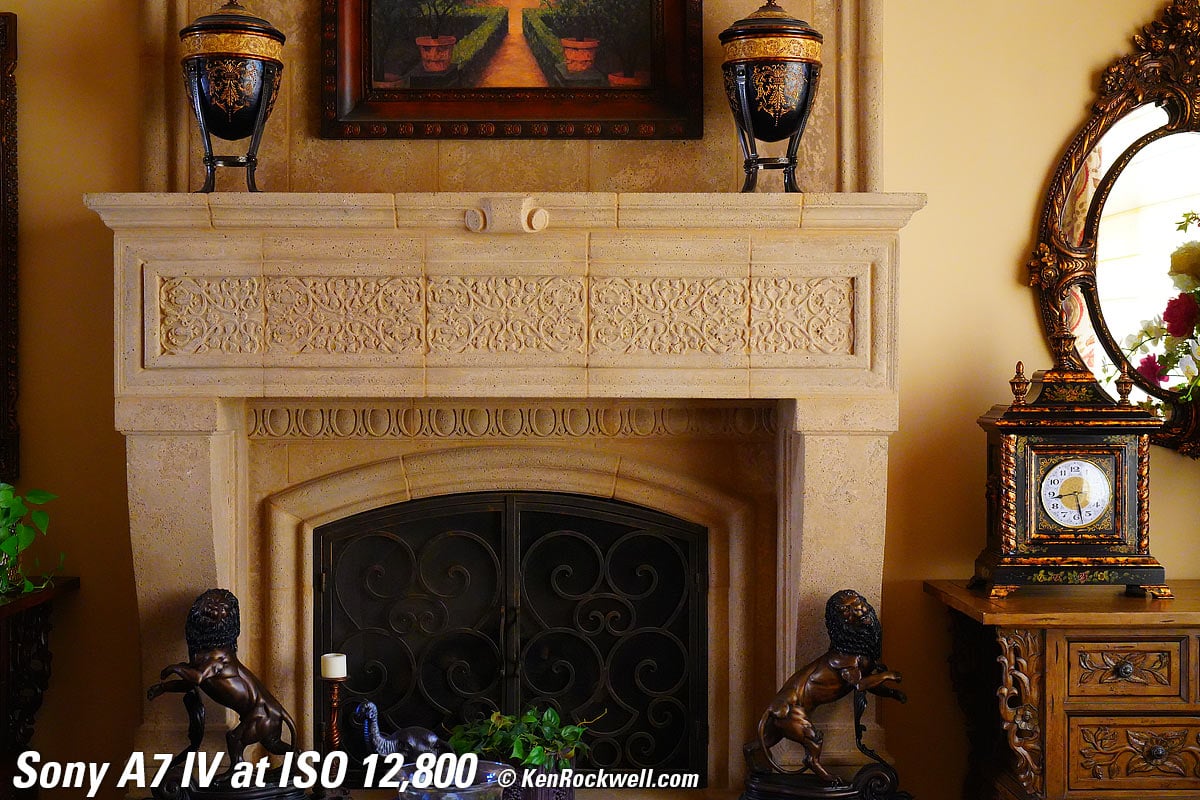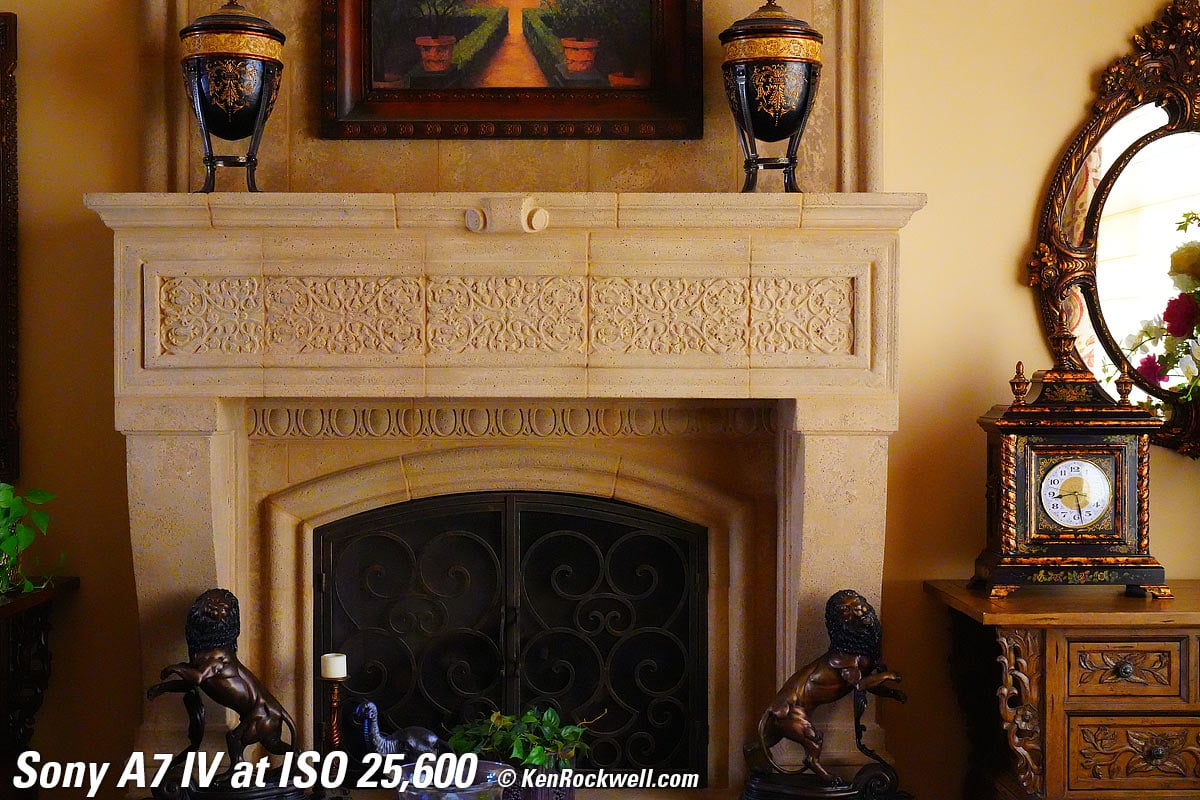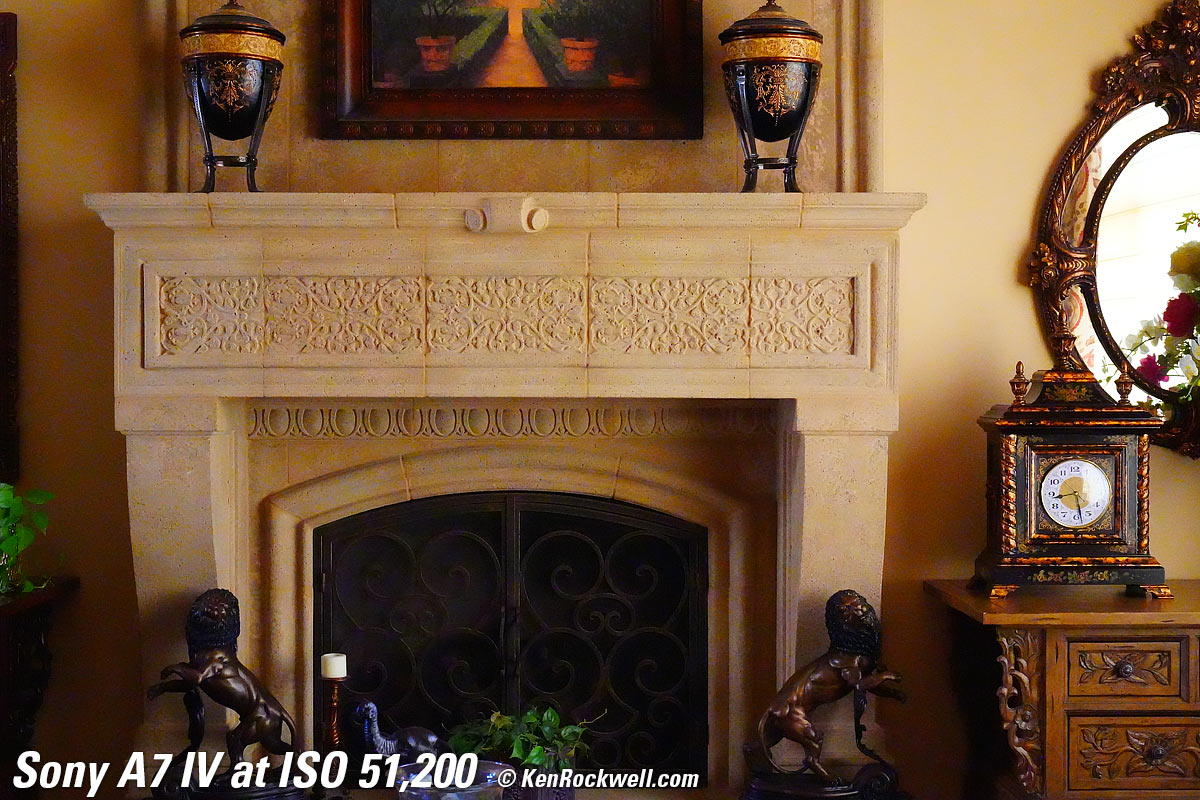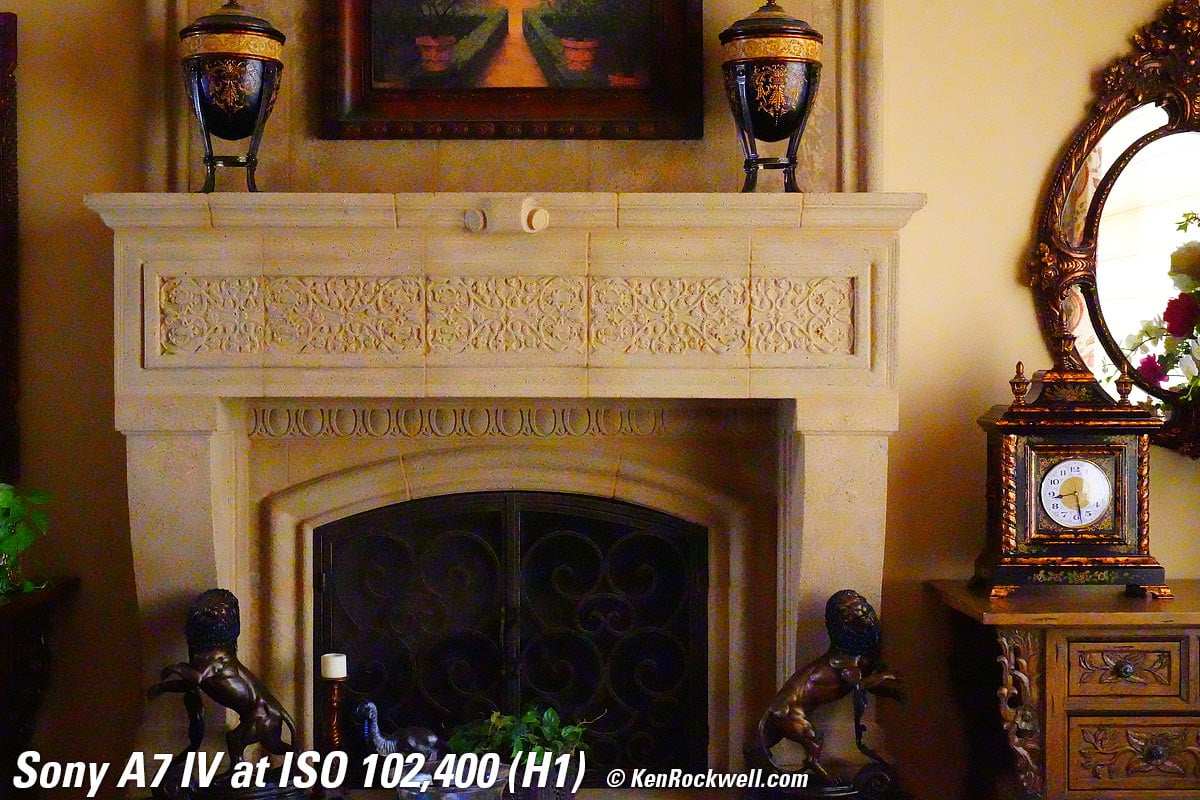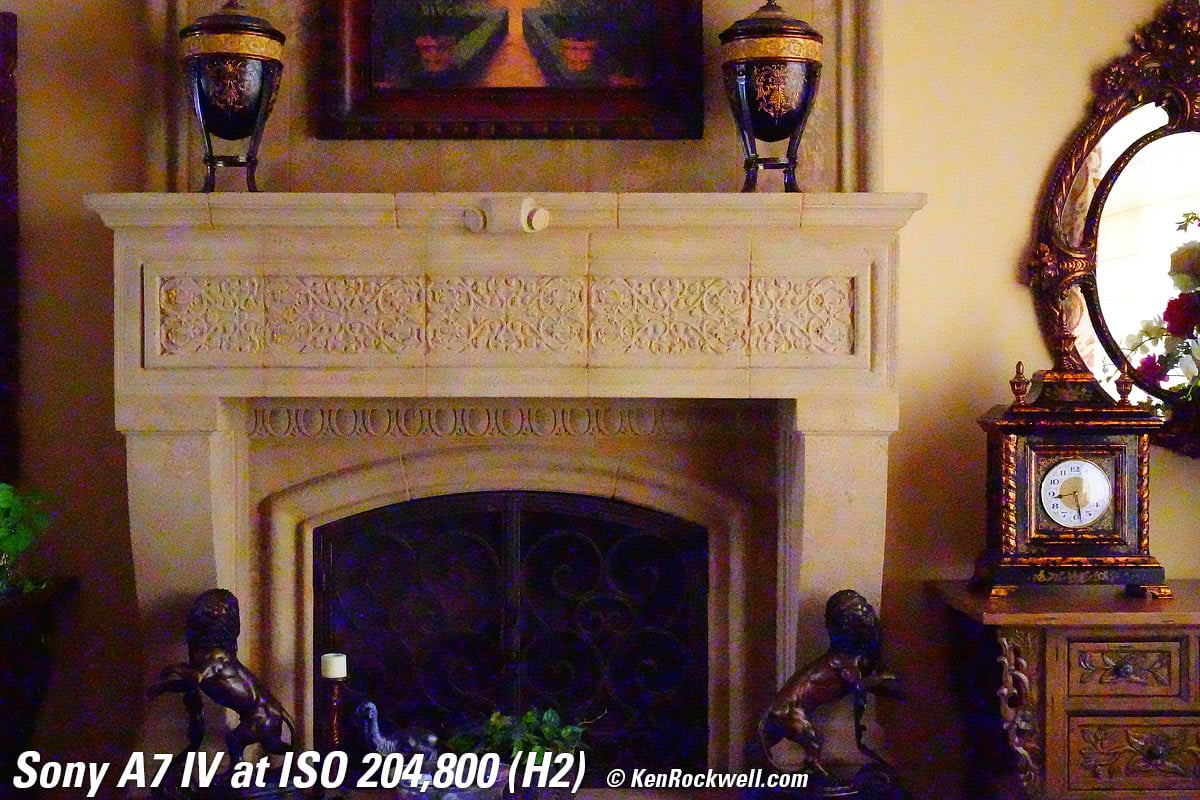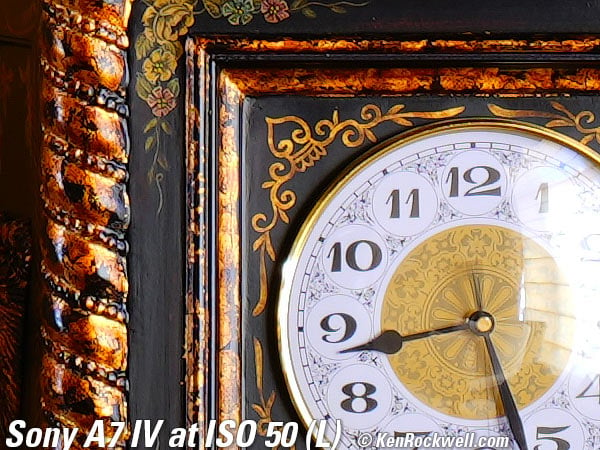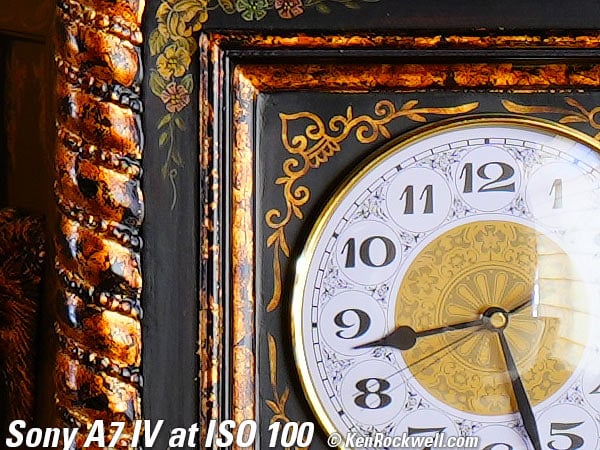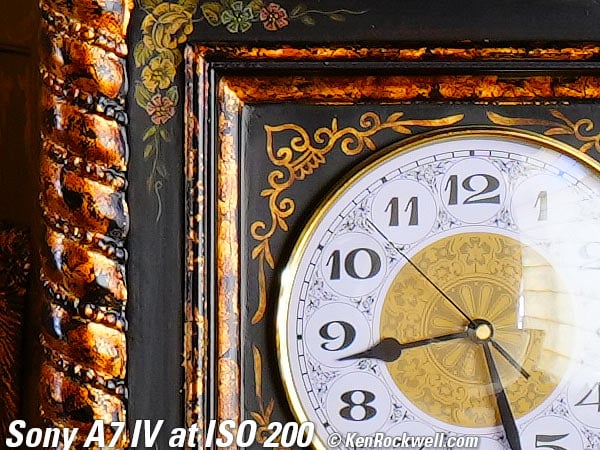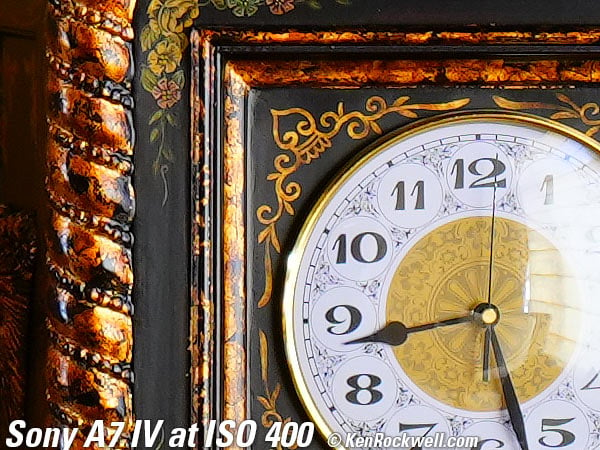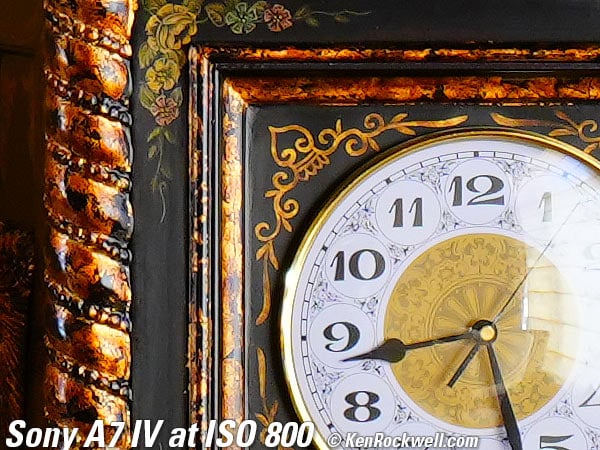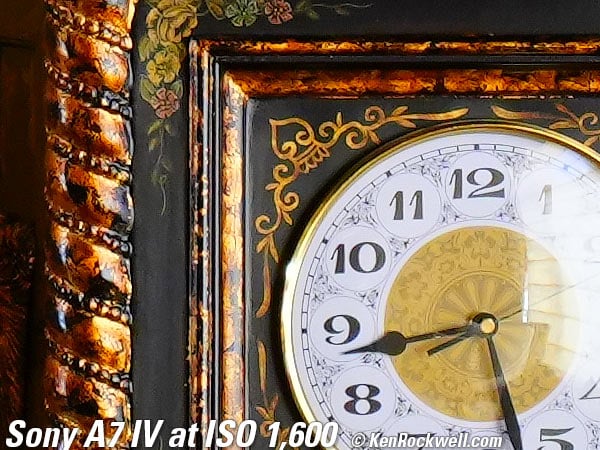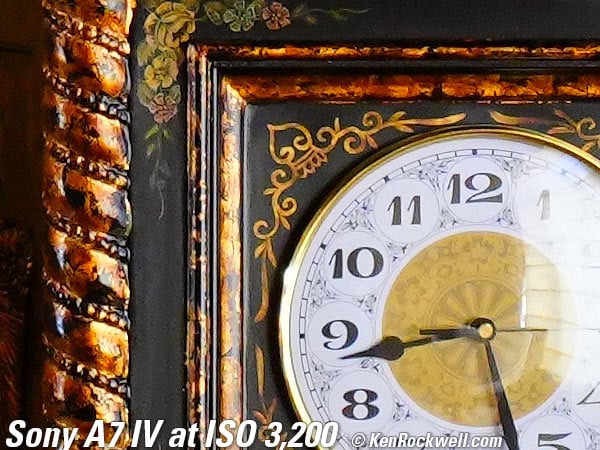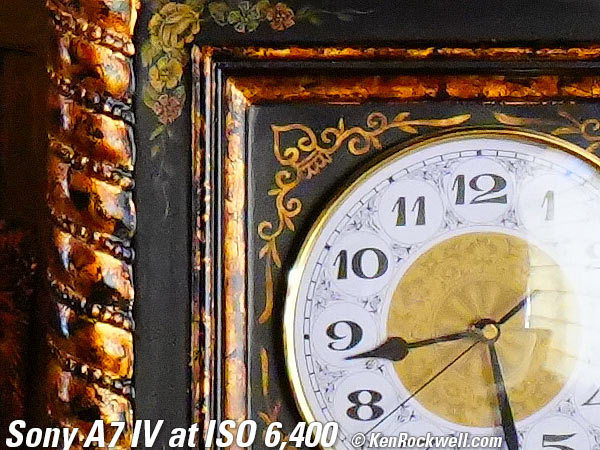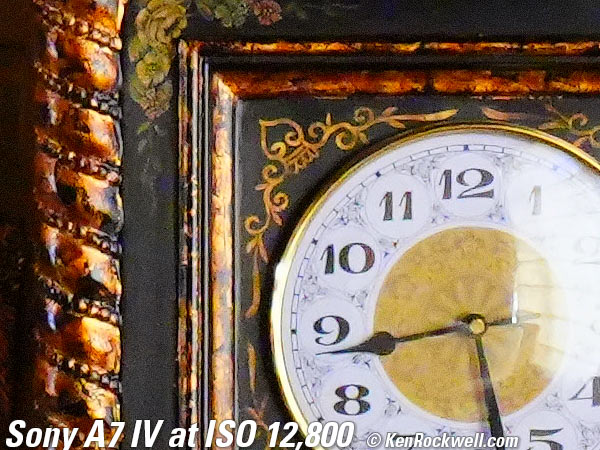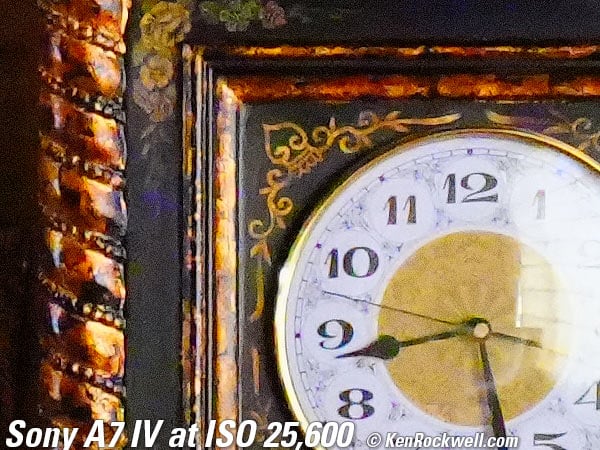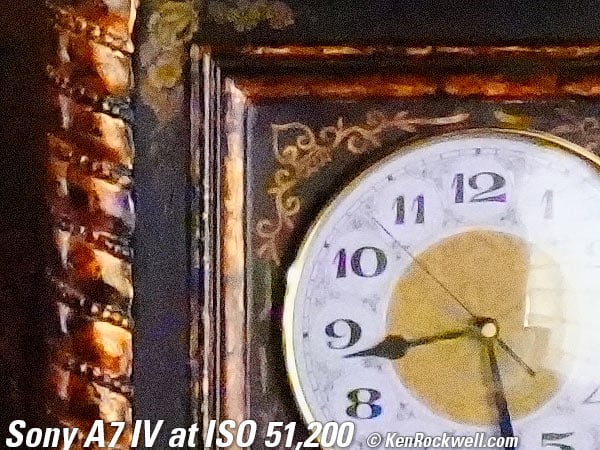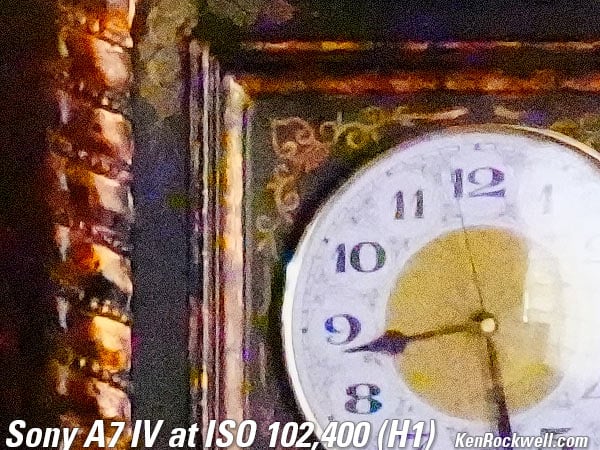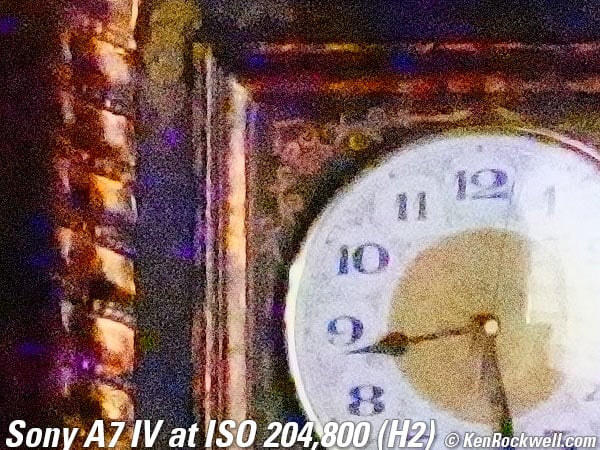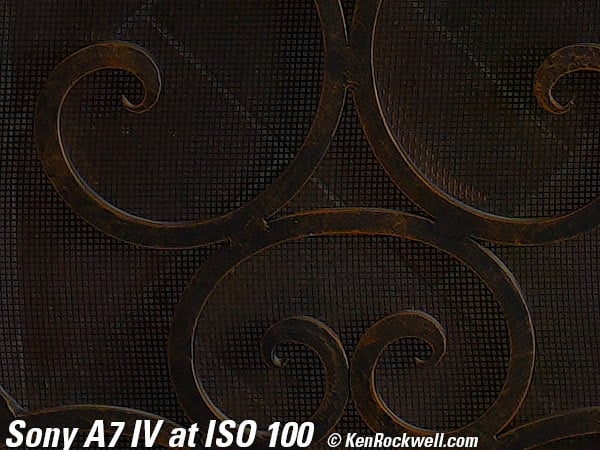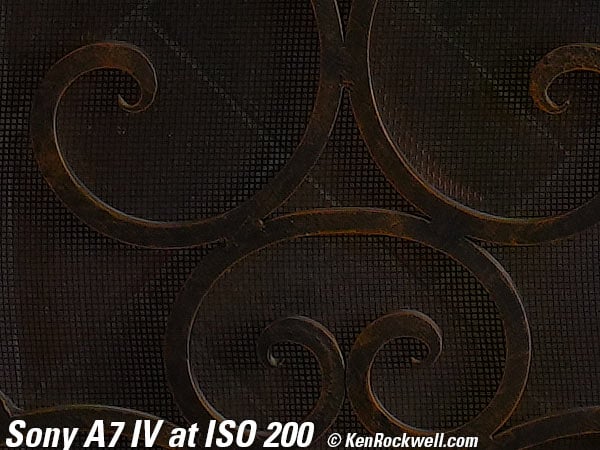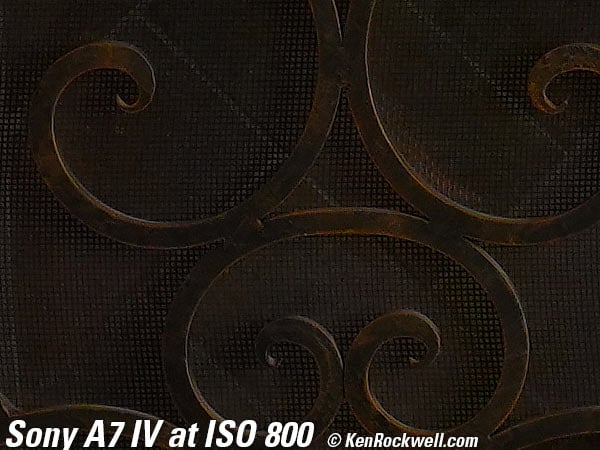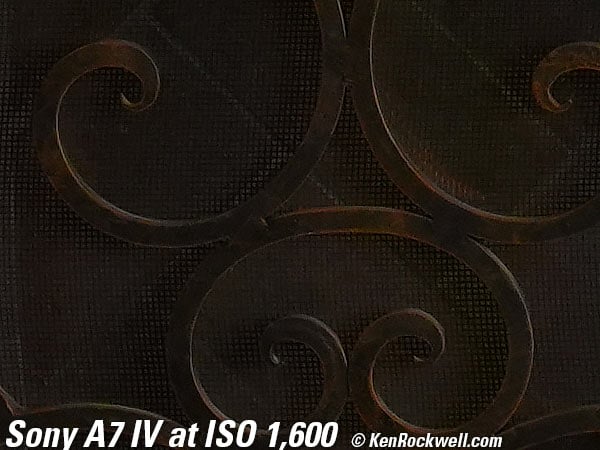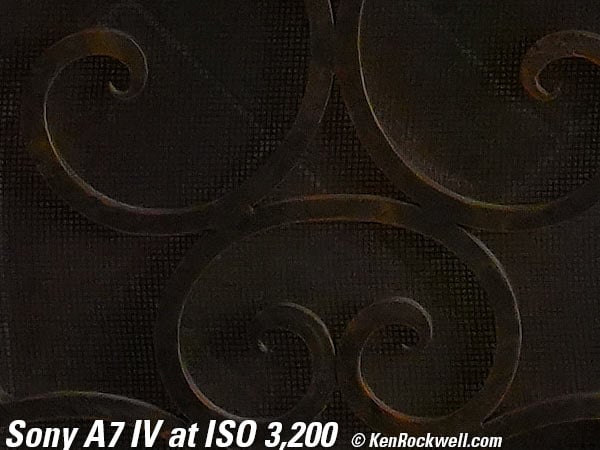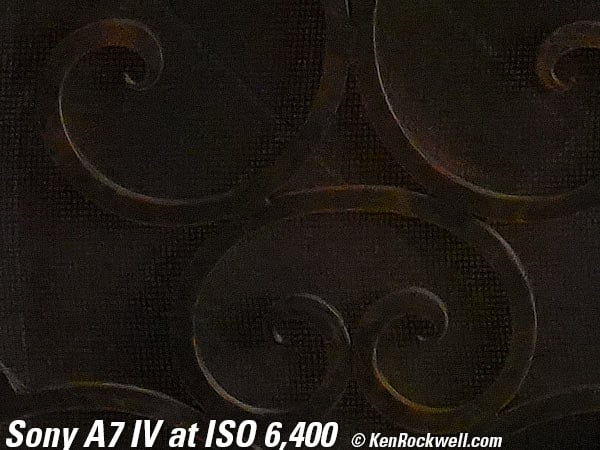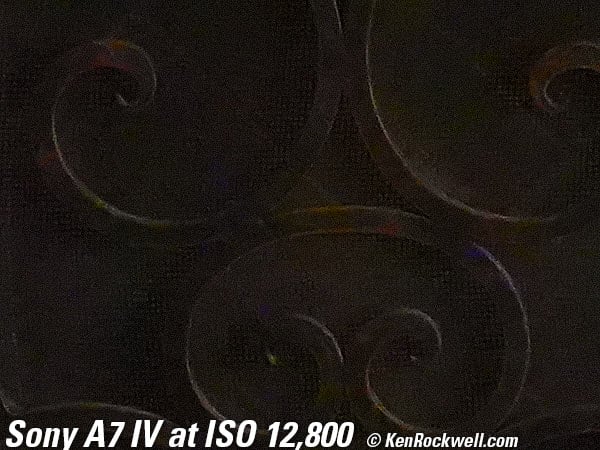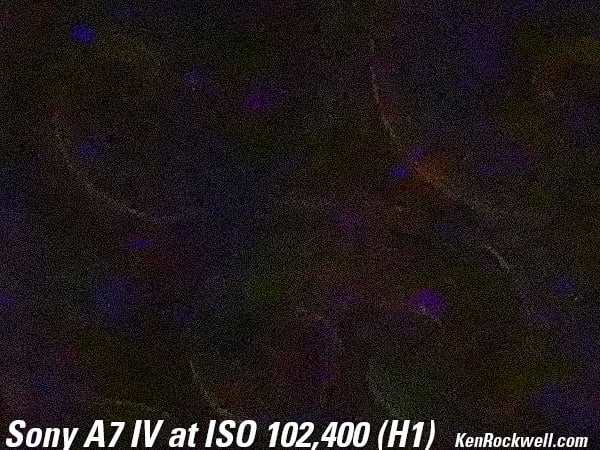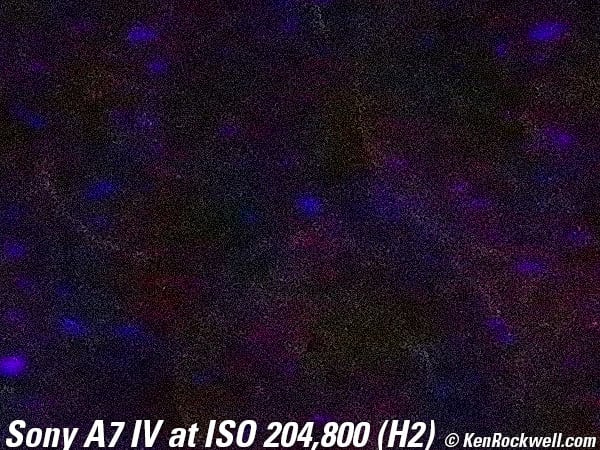Sony A7 IV
33 MP Stabilized Full-Frame, Silent 10FPS, ISO 204,800, 4K HDR Stereo
Sample Images Intro New Good Bad Missing
Lenses & Adapters Specifications Accessories
USA Version Performance Compared
Sony: A9 III A1 A9 II A9 A7R V A7R IV A7R III A7 IV A7 III A7R II A7S III A7c A7 II A6600 A6400 A6100 A6000 ZV-E10 RX10/4 RX100/7 RX100/6 Flash Lenses
Sony A7 IV (23.2 oz./658g with battery and SD card, other slot takes an SD or an expensive Sony-specific CFexpress type A card (the less-expensive CFexpress type B cards do not fit), $2,498). bigger.
I'd get mine at Adorama, at Amazon, at B&H or at Crutchfield, or eventually used at eBay if you know How to Win at eBay. It also comes as a kit with the crappy FE 28-70mm lens for $2,698 at Adorama, at Amazon, at B&H and at Crutchfield. I'd pass on that kit; I'd get the kit with the superb FE 24-105/4 G instead; the smart money is always spent on better lenses.
This 100% all-content, junk-free website's biggest source of support is when you use those or any of these links to my personally approved sources I've used myself for way over 100 combined years when you get anything, regardless of the country in which you live — but I receive nothing for my efforts if you get it elsewhere. Sony does not seal its boxes in any way, so never buy at retail or any other source not on my personally approved list since you'll have no way of knowing if you're missing accessories, getting a defective, damaged, returned, dropped, incomplete, gray-market, store demo or used camera — and all of my personally approved sources allow for 100% cash-back returns for at least 30 days if you don't love your new camera. I've used many of these sources since the 1970s because I can try it in my own hands and return it if I don't love it, and because they ship from secure remote warehouses where no one gets to touch your new camera before you do. Buy only from the approved sources I've used myself for decades for the best prices, service, return policies and selection.
March 2022 Sony Lenses Zeiss Nikon Canon Fuji LEICA All Reviews
Older model A7 III
Nikon vs Canon vs Sony Full Frame Mirrorless Compared.
Sony A7 IV. bigger.
Sony A7 IV. bigger.
Sony A7 IV. bigger.
Sample Images top
Sample Images Intro New Good Bad Missing
Lenses & Adapters Specifications Accessories
USA Version Performance Compared
(More samples at High ISOs)
These are just snapshots; my real work is in my Gallery.
These are all shot hand-held as LIGHT JPGs; no tripods, no STANDARD, FINE or EXTRA FINE JPGs or RAW files were used or needed.
Red 1932 Ford Roadster, 9:20 AM, Saturday, 26 February 2022. Sony A7 IV set to VV (Vivid) Creative Look with +9 Saturation, Sony HVL-F46RM flash in TTL mode, Sony FE 70-200mm f/2.8 GM OSS II at 136mm at f/7.1 at 1/250 at Auto ISO 100 (LV 13.6), Perfectly Clear. bigger or camera-original 33 MP © JPG file (6 MB).
Bougainvillea, 11:10 AM, Saturday, 26 February 2022. Sony A7 IV set to VV (Vivid) Creative Look with +9 Saturation, Sony HVL-F60RM2 flash in TTL mode, Sony FE 70-200mm f/2.8 GM OSS II at 70mm at f/16 at 1/250 at Auto ISO 100, -0.7 stops exposure compensation (LV 16.0), Perfectly Clear, perspective correction in Photoshop CS6. bigger or camera-original 33 MP © JPG file (6 MB).
Yellow 1941 Chevrolet Special Deluxe, 11:22 AM, Saturday, 26 February 2022. Sony A7 IV set to VV (Vivid) Creative Look with +9 Saturation, Sony HVL-F60RM2 flash in TTL mode, Sony FE 70-200mm f/2.8 GM OSS II at 88mm at f/9 at 1/250 at Auto ISO 100 (LV 14.3), Perfectly Clear. bigger or camera-original 33 MP © JPG file (7 MB).
Latino Classic, 11:35 AM, Saturday, 26 February 2022. Sony A7 IV set to VV (Vivid) Creative Look with +9 Saturation, Sony HVL-F60RM2 flash in TTL mode (that's me and the flash in the reflection in the bumper on the lower right), Sony FE 70-200mm f/2.8 GM OSS II at 125mm at f/22 for (great sunstars) at 1/125 at Auto ISO 640 (LV 13.2), Perfectly Clear. bigger or camera-original 33 MP © JPG file (5 MB).
Red Ford Pickup Liftgate, 11:46 AM, Saturday, 26 February 2022. Sony A7 IV set to VV (Vivid) Creative Look with +9 Saturation, no flash, Sony FE 70-200mm f/2.8 GM OSS II at 200mm at f/5.6 at 1/640 at Auto ISO 100 (LV 14.3), Perfectly Clear. bigger or camera-original 33 MP © JPG file (6 MB).
The Sony FE 70-200mm f/2.8 GM OSS II gets super close!!!
Black 1956 VW Beetle, 12:02 PM, Saturday, 26 February 2022. Sony A7 IV set to VV (Vivid) Creative Look with +9 Saturation, Sony HVL-F60RM2 flash in TTL mode, Sony FE 70-200mm f/2.8 GM OSS II at 94mm at f/5 at 1/250 at Auto ISO 100 (LV 12.6), as shot. bigger or camera-original 33 MP © JPG file (6 MB).
Flaming Hot Rod, 12:16 PM, Saturday, 26 February 2022. Sony A7 IV set to VV (Vivid) Creative Look with +9 Saturation, Sony HVL-F60RM2 flash in TTL mode, Sony FE 70-200mm f/2.8 GM OSS II at 88mm at f/9 at 1/250 at Auto ISO 100 (LV 14.3), Perfectly Clear. bigger or camera-original 33 MP © JPG file (4 MB).
Introduction top
Sample Images Intro New Good Bad Missing
Lenses & Adapters Specifications Accessories
USA Version Performance Compared
|
I buy only from these approved sources. I can't vouch for ads below. |
Back in February 2018 the previous A7 III was wildly popular, becoming the world's most-popular full-frame mirrorless, because it was as good as previous Sony cameras that cost twice as much. The A7 III was a no-brainer, and now this A7 IV adds numerous updates to 2018's A7 III — but costs a solid 25% ($500) more.
While this A7 IV adds a zillion little nice things to the A7 III, $500 is $500 and they both take the same pictures. There's no visible difference between 33 and 24MP, both have the same frame rates, same ISO range, same general AF performance and so forth. If some particular improvement is important to you (I LOVE the Vivid and new +9 saturation setting for instance) or if you simply just want the newest, go for it, but at the end of the day they're very similar. Is it worth it? That depends on you; see Is It Worth It.
I'd get my A7 IV at Adorama, at Amazon, at B&H or at Crutchfield, or eventually used at eBay if you know How to Win at eBay. It also comes as a kit with the crappy FE 28-70mm lens for $2,698 at Adorama, at Amazon, at B&H and at Crutchfield. I'd pass on that kit; I'd get the kit with the superb FE 24-105/4 G instead; the smart money is always spent on better lenses.
New since the A7 III intro top
 33 MP rather than the A7 III's 24 MP. While 33 MP seems like more than the A7 III's 24 MP reading it here, this is less than a 17% increase in linear resolution (7,008 versus 6,000 pixels wide), which is invisible in actual use! Even if you're working at extreme enlargements where you can see every pixel, you still can't see a minor 17% increase, and 99% of the time you're not working at anywhere near that level of magnification — although camera makers want you to think you can. See The Megapixel Myth and Pixel Dumping; it just doesn't matter.
33 MP rather than the A7 III's 24 MP. While 33 MP seems like more than the A7 III's 24 MP reading it here, this is less than a 17% increase in linear resolution (7,008 versus 6,000 pixels wide), which is invisible in actual use! Even if you're working at extreme enlargements where you can see every pixel, you still can't see a minor 17% increase, and 99% of the time you're not working at anywhere near that level of magnification — although camera makers want you to think you can. See The Megapixel Myth and Pixel Dumping; it just doesn't matter.
 Three preset memory modes (1, 2, & 3) on the top dial, rather then just two as on the A7 III.
Three preset memory modes (1, 2, & 3) on the top dial, rather then just two as on the A7 III.
 Preset memory modes (1, 2, 3, M1, M2, M3 & M4) now recall immediately as they should, without the maddening delay in the A7 III.
Preset memory modes (1, 2, 3, M1, M2, M3 & M4) now recall immediately as they should, without the maddening delay in the A7 III.
 Slightly higher resolution finder, now has 3.68 Mdots vs. the A7 III's 2.36 Mdots.
Slightly higher resolution finder, now has 3.68 Mdots vs. the A7 III's 2.36 Mdots.
 This and the A7 III both have two SD card slots. This IV now has one slot that can take Sony's expensive CFexpress type A cards (NOT type B cards), but the IV no longer works with Memory Sticks.
This and the A7 III both have two SD card slots. This IV now has one slot that can take Sony's expensive CFexpress type A cards (NOT type B cards), but the IV no longer works with Memory Sticks.
 Both card slots now work with UHS-II SD cards. Only one slot in the A7 III could take advantage of the faster UHS-II cards.
Both card slots now work with UHS-II SD cards. Only one slot in the A7 III could take advantage of the faster UHS-II cards.
 New losslessly compressed raw option. Both this and the A7 III offer uncompressed and (lossy) compressed raw.
New losslessly compressed raw option. Both this and the A7 III offer uncompressed and (lossy) compressed raw.
 New HEIF file option stores 10-bit data in about the same space as an 8-bit JPG (be careful: not all software that you or your clients have can read HEIF files).
New HEIF file option stores 10-bit data in about the same space as an 8-bit JPG (be careful: not all software that you or your clients have can read HEIF files).
 New "LIGHT" JPG file option is half the file size of a STANDARD JPG and looks just as good. It stores twice as many images in the same space as STANDARD JPG. I use LIGHT JPG for all my shots.
New "LIGHT" JPG file option is half the file size of a STANDARD JPG and looks just as good. It stores twice as many images in the same space as STANDARD JPG. I use LIGHT JPG for all my shots.
 Adds square and 4:5 as-shot crops (A7 III offered only 16:9 crops).
Adds square and 4:5 as-shot crops (A7 III offered only 16:9 crops).
 Internal stabilization rated 5.5 versus 5 stops.
Internal stabilization rated 5.5 versus 5 stops.
 New electronic video stabilization option in addition to sensor-shift stabilization allows correction of even jerkier hand-holding (crops the sensor about 10% for videos if you use this option, as is typical for these systems).
New electronic video stabilization option in addition to sensor-shift stabilization allows correction of even jerkier hand-holding (crops the sensor about 10% for videos if you use this option, as is typical for these systems).
 Imperceptibly higher resolution LCD, now has 1,036,800 dots vs. the A7 III's 921,600 dots.
Imperceptibly higher resolution LCD, now has 1,036,800 dots vs. the A7 III's 921,600 dots.
 LCD now flips all the way around for self portraits.
LCD now flips all the way around for self portraits.
 Bird eye recognition, in addition to people and mammal eyes also recognized in the A7 III.
Bird eye recognition, in addition to people and mammal eyes also recognized in the A7 III.
 Much more flexible picture controls. Now contrast and saturation set to ±9, sharpening sets to +9, and there are new settings for Highlights (how bright are the bright areas, sets to ±9), Shadows (how dark are the dark areas, sets to ±9), Fade (no one knows what this does, but whatever it is it sets from 0 to +9; I'll guess it allows you to reduce the overall effect of the picture control as you increase it), Sharpness Range (alters the sharpening radius and sets from 1 to 5. 1 sharpens coarser details while 5 sharpens finer details) and Clarity (mild low-spatial-frequency boost to increase apparent contrast without affecting highlights or shadows, sets from 0 to +9).
Much more flexible picture controls. Now contrast and saturation set to ±9, sharpening sets to +9, and there are new settings for Highlights (how bright are the bright areas, sets to ±9), Shadows (how dark are the dark areas, sets to ±9), Fade (no one knows what this does, but whatever it is it sets from 0 to +9; I'll guess it allows you to reduce the overall effect of the picture control as you increase it), Sharpness Range (alters the sharpening radius and sets from 1 to 5. 1 sharpens coarser details while 5 sharpens finer details) and Clarity (mild low-spatial-frequency boost to increase apparent contrast without affecting highlights or shadows, sets from 0 to +9).
 New "Soft Skin" effect for stills and video. This is a feature that's been in studio broadcast cameras for many decades, now in a still camera.
New "Soft Skin" effect for stills and video. This is a feature that's been in studio broadcast cameras for many decades, now in a still camera.
 Option to have the shutter closed when off. Yay!
Option to have the shutter closed when off. Yay!
 Same 1/250 flash sync with mechanical shutter (only), but now goes to 1/320 in APS-C crop. So?
Same 1/250 flash sync with mechanical shutter (only), but now goes to 1/320 in APS-C crop. So?
 Some flashes and commander units can be set directly from the camera.
Some flashes and commander units can be set directly from the camera.
 "Multi Interface" hot shoe with numerous contacts to provide direct connections for digital audio & etc. — but sadly now both camera and flashes come with prophylactic covers to prevent dirt from mucking up these delicate connections.
"Multi Interface" hot shoe with numerous contacts to provide direct connections for digital audio & etc. — but sadly now both camera and flashes come with prophylactic covers to prevent dirt from mucking up these delicate connections.
 Deeper buffer claimed if you use Sony's expensive CFexpress type A cards, around 1,000 shots versus a couple of hundred, but for all I know tis is due to the faster card option rather than more in-camera memory.
Deeper buffer claimed if you use Sony's expensive CFexpress type A cards, around 1,000 shots versus a couple of hundred, but for all I know tis is due to the faster card option rather than more in-camera memory.
 Menu system no longer locked-out while writing to a card.
Menu system no longer locked-out while writing to a card.
 New menu system is pretty good for a change.
New menu system is pretty good for a change.
 759 versus 693 Phase-Detection AF points.
759 versus 693 Phase-Detection AF points.
 AF now rated down to LV -4 with an f/2 lens, versus LV -3 with the A7 III.
AF now rated down to LV -4 with an f/2 lens, versus LV -3 with the A7 III.
 Phase-Detection AF points now work down to f/22; they only worked down to f/11 in the A7 III (no big deal, either camera still works in contrast-detection at smaller apertures).
Phase-Detection AF points now work down to f/22; they only worked down to f/11 in the A7 III (no big deal, either camera still works in contrast-detection at smaller apertures).
 Less battery life; rated 520 shots versus 610 shots in the A7 III using the finder, or 580 vs. 710 shots with the rear LCD.
Less battery life; rated 520 shots versus 610 shots in the A7 III using the finder, or 580 vs. 710 shots with the rear LCD.
 Electronic video focus-breathing compensation with certain Sony lenses.
Electronic video focus-breathing compensation with certain Sony lenses.
 Now you have three speed settings for how quickly auto white balance responds to changing light with movies.
Now you have three speed settings for how quickly auto white balance responds to changing light with movies.
 Top rear control dial much bigger and nicer. Now on top of camera rather than hidden inside the body.
Top rear control dial much bigger and nicer. Now on top of camera rather than hidden inside the body.
 Buttons poke out more, making them easier to find by feel.
Buttons poke out more, making them easier to find by feel.
 Movie button now on top rather than on the back.
Movie button now on top rather than on the back.
 Mode dial is now plastic rather than metal.
Mode dial is now plastic rather than metal.
 New locking dial added under the Mode dial to select still, movie or "S&Q" ("slow and quick" or over- or under-crank video slo-mo and time-lapse) modes.
New locking dial added under the Mode dial to select still, movie or "S&Q" ("slow and quick" or over- or under-crank video slo-mo and time-lapse) modes.
 Most camera settings are stored and then recalled as you swap among the still, movie or "S&/Q" modes on that dial.
Most camera settings are stored and then recalled as you swap among the still, movie or "S&/Q" modes on that dial.
 What was only an exposure compensation dial on the A7 III now can be programmed as you like it, and it has a lock/unlock control.
What was only an exposure compensation dial on the A7 III now can be programmed as you like it, and it has a lock/unlock control.
 New card door latch gets in the way of getting to your cards.
New card door latch gets in the way of getting to your cards.
 Wi-Fi adds 5 GHz bands.
Wi-Fi adds 5 GHz bands.
 Movie mode can live stream directly via USB (A7 III only could do that through some Sony apps), but only at 4K/15 (?!), 1,080/60, 1,080/30 or 720/30.
Movie mode can live stream directly via USB (A7 III only could do that through some Sony apps), but only at 4K/15 (?!), 1,080/60, 1,080/30 or 720/30.
 Now can be powered over USB-C (A7 III could charge, but not run from USB-C). This A7 IV only charges with power off; it still can't charge while turned on.
Now can be powered over USB-C (A7 III could charge, but not run from USB-C). This A7 IV only charges with power off; it still can't charge while turned on.
 USB-C port now works at 10 Gb/s (1.25 GB/s), up from 5 Gb/s (625 MB/s).
USB-C port now works at 10 Gb/s (1.25 GB/s), up from 5 Gb/s (625 MB/s).
 No more NFC.
No more NFC.
 Full-size HDMI port (A7 III has Micro-HDMI).
Full-size HDMI port (A7 III has Micro-HDMI).
 Uses the newer VG-C4EM battery grip, not the older VG-C3EM.
Uses the newer VG-C4EM battery grip, not the older VG-C3EM.
 Production now offshored to Thailand instead of being dumped straight to China like the A7 III.
Production now offshored to Thailand instead of being dumped straight to China like the A7 III.
 About 4% bigger in each dimension and 0.3 oz (8g) heavier.
About 4% bigger in each dimension and 0.3 oz (8g) heavier.
 Now $2,498, not only $1,998 like the A7 III, as of March 2022.
Now $2,498, not only $1,998 like the A7 III, as of March 2022.
Good intro top
 Completely silent in Silent Mode, but this mode isn't on by default. See How to Set Silent Mode.
Completely silent in Silent Mode, but this mode isn't on by default. See How to Set Silent Mode.
 Two card slots.
Two card slots.
 Uses the same great NP-FZ100 battery as other top Sony cameras.
Uses the same great NP-FZ100 battery as other top Sony cameras.
 Option to have the shutter closed when off. Yay!
Option to have the shutter closed when off. Yay!
 Unlimited video take length.
Unlimited video take length.
 Hybrid AF system uses phase-detection for speed and contrast detection for ultimate precision and accuracy.
Hybrid AF system uses phase-detection for speed and contrast detection for ultimate precision and accuracy.
 Battery percentage always shown next to the battery icon.
Battery percentage always shown next to the battery icon.
 In-finder 2-axis level works great for keeping horizons and vertical lines as they should be.
In-finder 2-axis level works great for keeping horizons and vertical lines as they should be.
 In-camera, as-shot automatic lens vignetting, lateral chromatic aberration and distortion correction.
In-camera, as-shot automatic lens vignetting, lateral chromatic aberration and distortion correction.
 Almost any lens of any brand or age can be adapted to work - but with no lens corrections.
Almost any lens of any brand or age can be adapted to work - but with no lens corrections.
 Stereo microphone built-in.
Stereo microphone built-in.
 3.5mm powered Mic and headphone jacks.
3.5mm powered Mic and headphone jacks.
 Camera-state save to/from card at MENU > Setup > 2 Reset/Save Settings > Save/Load Settings.
Camera-state save to/from card at MENU > Setup > 2 Reset/Save Settings > Save/Load Settings.
 Can make a new folder each day if you set MENU > Shooting > 3 File > File/Folder Settings > Folder Name > Date Form.
Can make a new folder each day if you set MENU > Shooting > 3 File > File/Folder Settings > Folder Name > Date Form.
 Wi-Fi.
Wi-Fi.
 Bluetooth.
Bluetooth.
Bad intro top
 The electronic viewfinder (EVF) is a step down from all other Sonys because while it has auto-adjusting brightness, it doesn't automatically get bright enough in daylight. In daylight I need to set it manually to +2, after which it's fine — until I go back inside. Bad Sony!
The electronic viewfinder (EVF) is a step down from all other Sonys because while it has auto-adjusting brightness, it doesn't automatically get bright enough in daylight. In daylight I need to set it manually to +2, after which it's fine — until I go back inside. Bad Sony!
 One slot can use a hot-rod CFexpress card, however it only takes the expensive Sony-specific CFexpress type A cards, NOT the faster and less-expensive CFexpress type B cards.
One slot can use a hot-rod CFexpress card, however it only takes the expensive Sony-specific CFexpress type A cards, NOT the faster and less-expensive CFexpress type B cards.
 If you set it to record to two cards simultaneously as I do for backup, it locks-up and won't shoot if you remove either card or either card fills or has an error. It should just shoot to either card that has space, not leave you dead in the water if one dies; that's the whole point of this mode.
If you set it to record to two cards simultaneously as I do for backup, it locks-up and won't shoot if you remove either card or either card fills or has an error. It should just shoot to either card that has space, not leave you dead in the water if one dies; that's the whole point of this mode.
 Cards not titled when formatted.
Cards not titled when formatted.
 "Rolling Shutter" effect with silent or electronic shutter leads to tilted vertical lines when panning, and prevents the use of flash (all is OK with the usual mechanical shutter).
"Rolling Shutter" effect with silent or electronic shutter leads to tilted vertical lines when panning, and prevents the use of flash (all is OK with the usual mechanical shutter).
 Production offshored to Thailand, not made domestically in Japan.
Production offshored to Thailand, not made domestically in Japan.
Missing intro top
 Silent electronic shutter is a game-changer, but won't work with flash. Flash sync speed is still only 1/250.
Silent electronic shutter is a game-changer, but won't work with flash. Flash sync speed is still only 1/250.
 No timed manual exposures longer than 30 seconds. You have to use Bulb, a remote release and an external timer instead. Even the first Nikon F5 of 1996 gave manual exposures out to 30 minutes.
No timed manual exposures longer than 30 seconds. You have to use Bulb, a remote release and an external timer instead. Even the first Nikon F5 of 1996 gave manual exposures out to 30 minutes.
 No built-in flash.
No built-in flash.
 No illuminated buttons.
No illuminated buttons.
 No color histograms while shooting (only on playback).
No color histograms while shooting (only on playback).
 In-finder data displays do not rotate when the camera is held vertically.
In-finder data displays do not rotate when the camera is held vertically.
 Menus don't rotate when the camera is held vertically.
Menus don't rotate when the camera is held vertically.
 Not threaded to use a standard threaded cable release.
Not threaded to use a standard threaded cable release.
 "Mystery Meat" unmarked connector covers. You have to open each one to see what's inside.
"Mystery Meat" unmarked connector covers. You have to open each one to see what's inside.
 Still only Bluetooth 4.1. So?
Still only Bluetooth 4.1. So?
 No auto brightness control for the rear LCD.
No auto brightness control for the rear LCD.
 No Mode dial lock (good!).
No Mode dial lock (good!).
 No GPS, but a free app may let it tag from your phone.
No GPS, but a free app may let it tag from your phone.
 No shutter speed dial.
No shutter speed dial.
 No ISO dial.
No ISO dial.
 No more NFC.
No more NFC.
 No more swept panoramas (an iPhone does this better anyway).
No more swept panoramas (an iPhone does this better anyway).
Lenses & Adapters top
Sample Images Intro New Good Bad Missing
Lenses & Adapters Specifications Accessories
USA Version Performance Compared
I'd get my A7 IV at Adorama, at Amazon, at B&H or at Crutchfield, or eventually used at eBay if you know How to Win at eBay. It also comes as a kit with the crappy FE 28-70mm lens for $2,698 at Adorama, at Amazon, at B&H and at Crutchfield. I'd pass on that kit; I'd get the kit with the superb FE 24-105/4 G instead; the smart money is always spent on better lenses.
Lens Compatibility
Lens Mount, Sony A7 IV. bigger.
The A7 IV uses the Sony E-Mount, whose shallow 18mm flange focal distance allows better lens designs than DSLRs do — the same advantage rangefinder cameras have, as well as allowing just about any lens to mount with an adapter.
The A7 IV works best with lenses made by Sony, Zeiss and others native to Sony's mirrorless E-Mount.
If you mount a Sony or Zeiss APS-C lens, it automatically uses only the central APS-C section of the full-frame sensor. You'd never know, since all the displays just look right. It's that seamless, but sort of silly to waste most of this camera's sensor area with an APS-C lens.
Highest Performance Lenses lenses top
Sony's G, and especially GM lenses are the very best, better than any of the older Zeiss-for-Sony lenses from a few years ago.
See also my older list of Best Sony Lenses.
Stick to GM for the very best, or at least G for great performance.
Of course use only Sony's full-frame FE lenses. APS-C lenses work fine, but use less than half of your sensor. Skip them.
Sony's Adapters lenses top
Sony's own adapters work pretty well, but know that none of Sony's A-mount lenses are as good as the latest E-mount lenses, especially when used on E-mount.
LA-EA2 lenses top
Discontinued.
LA-EA3 lenses top
For lenses with built-in AF motors.
The LA-EA3 is a great adapter and allows just about full performance with any Sony Alpha DSLR or Minolta MAXXUM 35mm SLR - but only if it's one of the very few lenses with an internal autofocus motor.
If the lens has its own AF motor, with this adapter you should get full communication and AF and everything - but top frame rate may be limited to 10 FPS.
LA-EA4 lenses top
Recommended for all Sony Alpha and Minolta MAXXUM lenses for use on the A7 IV.
Katie at the Luau, 14 July 2017. (Sony A9 with Sony Minolta 28-135mm on Sony LA-EA4 adapter at 110mm at f/4.5 at 1/100 at Auto ISO 100, Perfectly Clear.) bigger.
Lamp, 8:01 PM, 14 July 2017. Sony A9 with Sony LA-EA4 adapter, Sony Minolta 28-135mm at 135mm at f/4.5 at 1/80 second hand-held at Auto ISO 1,250. bigger or camera-original © file.
The LA-EA4 is everything the LA-EA3 is, and adds its own AF motor to drive every Sony Alpha and Minolta MAXXUM lens for full autofocus — for every lens back to 1986. It works with lenses both with or without internal AF motors.
Sony Alpha and Minolta MAXXUM lens work great with the LA-EA4 on the A9 II. They focus very fast, and even Auto ISO and Program Shift all follow your zoom's focal length.
While phase-detection points only are active around the center of the frame, Face Recognition sees and focusses on faces anywhere. Oddly the face box stays gray or white, not locking-on in green unless the face is near the center of the frame, but it works anyway.
Lenses stay wide open most of the time for framing and focus and only stop down for the exposure. I program my C1 button for aperture preview.
While Sony only claims operation to 10 FPS, my 1980s Minolta MAXXUM lenses run at about 17 FPS just fine, complete with tracking autofocus and exposure. Bravo!
Other Brand Adapters lenses top
While you can adapt any lens of any brand or age to the A7 IV, they won't work as well as native Sony or Zeiss FE lenses, or Alpha or MAXXUM lenses with the LA-EA4 adapter.
Those lenses autofocus extremely well, but once you use an off-brand lens or adapter, lenses that perform magnificently on their own brand of camera may or may not autofocus that well. If you demand the best performance, just use the same brand of lens as your camera. Adapters should never be your go-to for the best performance. Don't expect the best results for sharpness or for autofocus from other-brand adapters if you're picky.
Sony A9 II with Nikon AI NIKKOR 55mm f/1.2. bigger.
Adapters are great for fun; you can get adapters cheap for any kind of lens, but not only may autofocus be iffy, adapted wide-angle lenses usually aren't very sharp on the sides at large apertures because Sony's full-frame mirrorless sensors are optimized for lenses with a curved field. Most other adapted lenses won't seem very sharp on the sides at large apertures due their flat fields not interfacing well with the curved fields needed by Sony's sensors on these cameras. If you get the center in focus, the sides will probably be off, and if you get the sides in focus, the center will be off. This is more of a problem with wider lenses and at large apertures; stop a lens down and the sides will come into better focus.
Sony A9 II with Nikon AI Fisheye-NIKKOR 16mm f/2.8s. bigger.
Metabones Mark V Adapter lenses top
The Metabones Canon EF to Sony E-Mount Mark V Adapter is the best I've used.
It works with every crazy Canon lens with which I tried it, and the results were usually much sharper than I expected.
See its review for lots of sample images and details. If you want an adapter for Canon, this is the one.
Katie at the orthodontist, 06 July 2017. Sony A9 with Canon 28-105mm USM II on Metabones Mark V adapter at 1/125 at Auto ISO 320. bigger or full-resolution © file.
Katie in the pool, 06 July 2017. Sony A9 with Canon 300mm f/2.8 L on Metabones Mark V adapter at f/2.8 at 1/1,250 at Auto ISO 100. bigger or full-resolution © file.
Katie at Get Air, 18 July 2017. Sony A9 with Canon 100-400mm L IS II on Metabones Mark V adapter at 227mm at f/5 at 1/500 at Auto ISO 8,000, Perfectly Clear. bigger.
Other Canon Adapters lenses top
You never know which particular AF lenses will work or not with other brands of adapters. There is always firmware and software to update, so you never know. While my A9 works with my Canon Canon 100-400mm L IS II and most of my lenses including my 1986 Canon 80-200/2.8 L, with the Fotodiox adapter my 50mm f/1.0 most things work, including electronic manual focus — but AF doesn't.
I bought a Fotga adapter direct from China for $37 if you know How to Win at eBay, and it worked for 30 seconds, and then never communicated with any of my lenses again. Just get the Metabones if you are serious about this.
Sony A9, Fotodiox adapter and Canon 50mm f/1.0. bigger.
LEICA Lenses lenses top
Lenses with goggles for the LEICA M3 (35mm and 135mm) won't mount regardless of what adapter you use: the grip gets in the way.
Sony A9 II with 1951 LEICA SUMMITAR 5cm f/2. bigger.
2017 Sony A9 and 1937 LEICA SUMMAR 5cm f/2. bigger.
Ryan on his way to school, 07 June 2017. 2017 Sony A9 with 1990 LEICA SUMMICRON-M 35mm f/2 at f/2 at 1/125 at Auto ISO 1,250. bigger or full-resolution © file.
This is shot in my garage, half-lit from an open door to an overcast sky, half lit by warm white fluorescent, and the third half is lit by cool-white — and it all comes out looking perfect in this quick grab shot in Auto White Balance with an amazing glow.
Store, 07 June 2017. 2017 Sony A9 with 1990 LEICA SUMMICRON-M 35mm f/2 at f/8 handheld at 1/15 at Auto ISO 1,600. bigger or full-resolution © file.
Silent shooting: no one asks why I'm taking pictures of concrete. Sensor-stabilization makes it easy to hand hold at 1/15.
Lighting Store, 07 June 2017. 2017 Sony A9 with 1990 LEICA SUMMICRON-M 35mm f/2 at f/8 handheld at 1/15 at Auto ISO 640. bigger or full-resolution © file.
Silent shooting: no one asks why I'm taking pictures, period. Sensor-stabilization makes it easy to hand hold at 1/15.
While LEICA lenses are the world's finest, they are not designed for the curved fields or rear nodal point positions optimized for the Sony cameras, and like all other adapted lenses, perform more poorly than Sony's own lenses because the sides and corners often aren't in proper focus.
This A9 II has the same sensor as the old A9 on which I shot these, so the results are the same.
LEICA lenses of 35mm and wider aren't as sharp as they should be at the sides. They sharpen up as stopped down, but if you want great results, use LEICA lenses on a LEICA camera, or use Sony's lenses on the A9. It all has to do with the specific alignment of micro lenses and layer configuration towards the sides of the sensor.
Specifically, there is a lot of field curvature induced by the design of the Sony sensor, and to focus at infinity at the sides with a modern semi-retrofocus LEICA SUPER-ELMARIT-M 21mm f/3.4 ASPH, you have to turn the focus ring to about 10'/3 meters! With the 1959 SUPER-ANGULON 21mm f/4 whose rear nodal point really is only about 21mm away from the image plane, you have to set the focus ring to about 3'/1 meter to get things at infinity in focus at the sides!!! Because of this, I've tried and confirmed that my cheap Voigtländer 21mm f/4 works about as well on my A9 as my genuine ASPH LEICA 21mm.
Not only does the combination of a LEICA (or other traditional Nikon or Canon) lens and Sony A9 sensor induce field curvature (there are a lot of optics and micro lenses on a sensor before you get to the light-sensitive part), it also induces astigmatism: the sagittal and meridional planes diverge.
There's no need to splurge for the latest APO ASPH LEICA lenses since the LEICA's (or anyone else's) lenses, with their flat fields are never going to be that sharp across a frame that's expecting a curved field lens. Therefore, it's best to select the lightest-weight (older) lenses rather than the hottest new ones. The performance of my LEICA SUMMICRON-M 35mm f/2 (7-element) is the same as with the newest LEICA SUMMICRON-M 35mm f/1.4 ASPH (floating element), so I prefer to use the older, lighter lens.
Here are two samples shot with the LEICA SUPER-ELMARIT-M 21mm f/3.4 ASPH at f/3.4 on the Sony A9. Click either to get the camera-original file and look at each at 100%:
Focussed at the center, focus ring set to 8 feet. bigger or camera-original © file.
Enlarge the camera-original © file and you'll see that while the center is super-sharp, the sides are crummy — and this is the world's sharpest 21mm lens!
Focussed for sharpness at the sides, focus ring set to 4 feet. bigger or camera-original © file.
Enlarge the camera-original © file and you'll see that the sides are sharper, but now the center is out of focus, even though objects at the sides are slightly farther away!
Shot with a real Sony 16-35/2.8 GM lens at 21mm and f/3.2, sharp corner-to-corner. bigger or camera-original © file.
Enlarge the camera-original © file and you'll see that everything is ultra-sharp. It's not that the LEICA lens isn't this sharp; it's just that its field curvature (or rear nodal point location) isn't optimized to the Sony cameras as Sony's lenses are. Also you'll see that there is much less corner darkening with this real Sony GM lens instead of the LEICA lenses, since the A9 has lens correction data for it.
Corner color shifts with adapted rangefinder ultrawide lenses isn't as bad as seen on other cameras:
Color shifts with modern LEICA SUPER-ELMAR-M 21mm f/3.4 ASPH. bigger.
Color shifts with 1959 LEICA SUPER-ANGULON 21mm f/4. bigger.
With my LEICA APO-SUMMICRON-M 90mm f/2 ASPH, probably the world's sharpest photographic lens legally sold to consumers, it actually works reasonably well because the curvature effects are less pronounced, but it's still not as good as a SONY lens on my A9, or the APO-SUMMICRON on a LEICA. It all has to do with how well sensors interface with particular lenses.
My LEICA TELE-ELMAR-M 135mm f/4 works great because its rear nodal point is far enough away from the sensor to give sharp images edge-to-edge wide open.
LEICA lenses also have the big disadvantage of not focussing any closer than 0.7 or 1 meters (2.5 or 3 feet). A huge advantage of mirrorless is that the system works great regardless of close-focus distance, so if you're going to use a lens on the A9, you ought to use one that focuses close enough. LEICA lenses were always limited by having to work with a viewfinder on the side of the camera which leads to big parallax problems at closer distances.
Summary lenses top
Stick with Sony's own lenses if you care about anything. Sony's GM lenses are especially excellent in every way.
Adapting lenses of other brands, even though these lenses may be state-of-the-art on those manufacturers' cameras, probably won't be that breathtaking on Sony — or on any other camera of a brand different than the lens' manufacturer. Stick to Sony's G and GM lenses on the A7 IV and you won't go wrong.
Specifications top
Sample Images Intro New Good Bad Missing
Lenses & Adapters Specifications Accessories
USA Version Performance Compared
I'd get my A7 IV at Adorama, at Amazon, at B&H or at Crutchfield, or eventually used at eBay if you know How to Win at eBay. It also comes as a kit with the crappy FE 28-70mm lens for $2,698 at Adorama, at Amazon, at B&H and at Crutchfield. I'd pass on that kit; I'd get the kit with the superb FE 24-105/4 G instead; the smart money is always spent on better lenses.
Sensor
32.74 MP full-frame 23.9 × 35.9mm CMOS sensor.
4,672 × 7,008 (32,741,376) pixels.
1.5:1 aspect ratio.
15-stop dynamic range.
Ultrasonic cleaner and anti-static coating.
Mechanical "5-axis" sensor-shift stabilizer claims 5.5 stops improvement.
Autofocus specifications top
759 point on-sensor phase-detection.
Contrast-detection.
Hybrid AF uses phase-detection for speed and fine-tunes with contrast detection when it can.
AF range LV -4 to +20 with an f/2 lens.
LED illuminator, 1 ~ 10 feet (0.3 ~ 3m) range.
5.5x and 11x magnifiers.
Electronic Viewfinder specifications top
0.78x with 50mm lens.
100% coverage.
0.5" (13mm) OLED.
3,686,400 dots.
60 or 120 FPS.
Auto and manual brightness control.
5 steps of manual color temperature shift.
-4 to +3 diopters.
Eyepoint: 18.5mm from the eyepiece frame, 23mm from the eyepiece
Light Meter specifications top
1,200 zone evaluative, entire screen Averaging, Center-Weighted, Spot, Spot standard or large or highlight-weighted.
Meter range LV -3 to +20 with an f/2 lens.
Shutters specifications top
Vertical metal mechanical focal-plane, or silent electronic.
1/8,000 to 30s and Bulb.
Sync Speed
1/250 flash sync with mechanical shutter.
1/320 flash sync in APS-C crop.
NO sync with electronic shutter.
Still Frame Rates specifications top
It runs to 10 FPS with either the mechanical or silent electronic shutters.
Continuous High +: 10 FPS.
Continuous High: 8 FPS.
Continuous Mid: 6 FPS.
Continuous Lo: 3 FPS
ISO specifications top
Stills, regular mechanical or silent electronic shutterISO 50 ~ 204,800.
ISO 100 ~ 51,200 is optimum.
Video
Regular: ISO 100 ~ 51,600.
Auto ISO specifications top
Upper and lower limits selectable from ISO 100 to ISO 204,800 in full stops (limited to ISO 32,000 for video).
Slowest shutter speed settable in full stops from 1/8,000 to 30s in full stops, as well as an Auto setting that varies with the lens focal length. The Auto Slowest Shutter Speed setting my be varied ±2 stops slower or faster than the lens' focal length.
Storage specifications top
Card door, Sony A7 IV. bigger.
Two slots:
Slot 1: SD card (SD, SDHC and SDXC, UHS-I and UHS-II compliant) or an expensive Sony-specific CFexpress type A card (the less-expensive CFexpress type B cards do not fit!).
Slot 2: SD card (SD, SDHC and SDXC, UHS-I and UHS-II compliant).
The cards face the wrong way, so in the photo above all you see is their backs. The card labels face the card door where you can't see them.
LCD specifications top
Flipping LCD, Sony A7 IV. bigger.
2.95" TFT LCD.
1,036,800 dots.
Flips 180º for self-portraits as shown.
Flips up 180º or down 45.º
Manual brightness control only. There is a "Sunny" mode, too.
Touch screen to move focus area, but not for menus or playback.
Connectors specifications top
The covers are unmarked, so like Mystery Meat, you have to open each to find what's inside.
Left Side
Full size HDMI.
Right side, from top down
3.5mm microphone jack with plug-in power.
3.5mm stereo headphone jack.
USB 3.2 type C connector.
USB Micro B "Multi Connector."
WiFi specifications top
2.4 GHz & 5 GHz.
NFC specifications top
NONE; although it was in the A7 III.
Bluetooth specifications top
v4.1.
2.4 GHz.
Model No. WW361847.
Battery specifications top
Sony NP-FZ100 rechargeable lithium ion battery included.
Rated 520 still shots with the viewfinder (CIPA).
Rated 580 still shots with the rear LCD (CIPA).
or
100 minutes of video (125 minutes using the rear LCD), CIPA.
Sony NP-FZ100 battery. enlarge.
Sony NP-FZ100 battery. enlarge.
It's 7.2V, 2,280 mAh, 16.4 W.
Charging specifications top
The A7 IV charges its battery in-camera via USB.
You can use any USB type C or USB Micro B cord and any USB source (try the USB sockets in your car, for instance) to charge.
Sony graciously includes it's own 1.5 amp USB adapter for use at home if you don't already have a drawer full of these:
Included Sony AC-UUD12 universal USB AC power adapter. bigger.
AC Adapter specifications top
Just plug your camera into any USB source — easy!
Camera Power Consumption specifications top
With Viewfinder
Consumes 3.8W for stills; 5.7W for video.
With Rear LCD
Consumes 3.4W for stills; 5.6W for video.
Size specifications top
3.80 x 5.17 x 3.14 inches HWD overall.
96.4 x 131.3 x 79.8 mm HWD overall.
3.80 x 5.17 x 2.74 inches HWD, excluding the rear viewfinder protrusion.
96.4 x 131.3 x 69.7 mm HWD, excluding the rear viewfinder protrusion.
Weight specifications top
23.2oz. (658g) with battery and card.
Operating Temperature specifications top
0 ~ 40º C (32 ~ 104ºF).
Quality specifications top
Made in Thailand:
Bottom, Sony A7 IV. bigger.
Magnesium alloy top cover, front cover, internal frame and rear cover.
The grip area has been reinforced with magnesium alloy.
Sony claims weather seals around most of the buttons and dials, but there are no seals on the card and connector covers.
Announced specifications top
21 October 2021.
Promised for specifications top
December 2021.
Included specifications top
A7 IV camera & body cap.
FDA-EP18 eye cup, attached.
Black plastic hot shoe cover, attached.
Shoulder strap.
NP-FZ100 rechargeable lithium ion battery (also fits A9 and A7 IV as of March 2018).
AC-UUD12 universal USB AC power adapter.
USB-A to USB-C cable (USB 3.2).
Model Numbers specifications top
Sony's official "ILCE-7M4" model number is printed on the certification sticker on the bottom. It's also how the model is listed in the EXIF information.
Its more casual "α7 IV" designation is only on the top.
Price specifications top
October 2021 ~ March 2022
$2,498, body only.
Accessories top
Sample Images Intro New Good Bad Missing
Lenses & Adapters Specifications Accessories
USA Version Performance Compared
I'd get my A7 IV at Adorama, at Amazon, at B&H or at Crutchfield, or eventually used at eBay if you know How to Win at eBay. It also comes as a kit with the crappy FE 28-70mm lens for $2,698 at Adorama, at Amazon, at B&H and at Crutchfield. I'd pass on that kit; I'd get the kit with the superb FE 24-105/4 G instead; the smart money is always spent on better lenses.
If not otherwise listed, the A7 IV generally takes the same accessories as its A9 II, A7R IV and A7S III brethren.
Included
AC-UUD12 universal USB AC power adapter.
Optional
VG-C4EM Vertical Battery Grip
The older VG-C3EM doesn't fit.
Sony BC-QZ1 Battery Charger
This is a good charger.
If you get this external charger you can charge two batteries at once; one in the camera via USB and the other in this charger.
Although I prefer a folding plug charger, this universal corded charger works anywhere with the right cord.
A nice feature is the three-segment battery status indicator. It shows about 2/3 charged here:
Sony BC-QZ1 Battery Charger with NP-FZ100 battery. bigger.
Sony BC-QZ1 Battery Charger. bigger.
Getting a Legal USA Version top
Sample Images Intro New Good Bad Missing
Lenses & Adapters Specifications Accessories
USA Version Performance Compared
(Applies in USA only)
I'd get my A7 IV at Adorama, at Amazon, at B&H or at Crutchfield, or eventually used at eBay if you know How to Win at eBay. It also comes as a kit with the crappy FE 28-70mm lens for $2,698 at Adorama, at Amazon, at B&H and at Crutchfield. I'd pass on that kit; I'd get the kit with the superb FE 24-105/4 G instead; the smart money is always spent on better lenses.
So long as you get yours from an authorized source, you'll get a legitimate USA version with a warranty from Sony USA.
USA versions are marked "UC2" above the UPC bar codes on the box. Be sure the serial number on the bar code matches the one on your camera.
USA versions also include a warranty slip which specifically mentions the USA and has Sony's USA phone number in your completely unsealed box.
If you do something stupid like buy from a source that is not an approved source, you may get a gray market version, which has no warranty in the USA and will lack this code on the box or the USA warranty sheet.
Just to keep things interesting, you'll notice that the A7 IV has a much larger and longer warranty sheet, no longer just a card, because this warranty now has many more exclusions and limitations than ever before. It specifically adds, about halfway down, that even if you have all this paperwork, if you didn't get your A7 IV from an approved (by Sony) dealer, then the warranty doesn't apply.
Buying gray market or what looks like a USA model from an unauthorized dealer is always taking a chance compared to getting a legal USA version from an authorized dealer. If you can save $750, then by all means go for it, but if you only get $100 off, I wouldn't risk it.
Performance top
Sample Images Intro New Good Bad Missing
Lenses & Adapters Specifications Accessories
USA Version Performance Compared
Overall Autofocus Ergonomics Exposure
Finder High ISOs Auto ISO Auto White Balance
I'd get my A7 IV at Adorama, at Amazon, at B&H or at Crutchfield, or eventually used at eBay if you know How to Win at eBay. It also comes as a kit with the crappy FE 28-70mm lens for $2,698 at Adorama, at Amazon, at B&H and at Crutchfield. I'd pass on that kit; I'd get the kit with the superb FE 24-105/4 G instead; the smart money is always spent on better lenses.
Overall performance top
This new A7 Mk IV is great if you shoot Sony. Your real question is is it $500 better then the A7 III?
Autofocus performance top
 Autofocus is great. It's fast, sure and usually totally automatic.
Autofocus is great. It's fast, sure and usually totally automatic.
 With face recognition the A7 IV autofocuses throughout the entire frame.
With face recognition the A7 IV autofocuses throughout the entire frame.
It's important to use a top G or GM lens whose internal AF system is optimized for the Sony mirrorless system; if you use an older or adapted lens, you'll miss much of what the A7 IV can do.
 While Sony claims only "94% coverage" for the phase-detection pixels, for people photos face recognition covers the entire frame, and as far as I'm concerned, 94% is the whole frame for phase detection. I never focus on the edges, but I do need to focus on the top and bottom and sides which my full-frame DSLRs don't let me do.
While Sony claims only "94% coverage" for the phase-detection pixels, for people photos face recognition covers the entire frame, and as far as I'm concerned, 94% is the whole frame for phase detection. I never focus on the edges, but I do need to focus on the top and bottom and sides which my full-frame DSLRs don't let me do.
Ergonomics performance top
 The A7 IV has so many programmable buttons and dials that it's easy to get it set up the way we'd like.
The A7 IV has so many programmable buttons and dials that it's easy to get it set up the way we'd like.
 It's easy to use one of the extra dials for full-stop ISO setting.
It's easy to use one of the extra dials for full-stop ISO setting.
 The 1, 2 and 3 camera-setting-recall positions on the top dial are lifesavers for instantly resetting my A7 IV for different conditions. How I set my 1, 2 and 3 memories.
The 1, 2 and 3 camera-setting-recall positions on the top dial are lifesavers for instantly resetting my A7 IV for different conditions. How I set my 1, 2 and 3 memories.
 A and S exposure modes recall whatever they were set to if you turn the camera off and back on again. In other words, I use the A mode when I want smaller apertures in low light, and any time I go into A mode it comes back up at the same aperture at which I left it the last time I used it, like f/11. Ditto for the S mode; regardless of what I do in the other exposure modes, the S mode comes back up where I left it the last time, like 1/500.
A and S exposure modes recall whatever they were set to if you turn the camera off and back on again. In other words, I use the A mode when I want smaller apertures in low light, and any time I go into A mode it comes back up at the same aperture at which I left it the last time I used it, like f/11. Ditto for the S mode; regardless of what I do in the other exposure modes, the S mode comes back up where I left it the last time, like 1/500.
 The battery goes in backwards from what you'd expect: instead of the curved side facing the curved outside of the grip into which it slides, the square side of the battery faces the outward curved part of the grip and the battery's curved side faces inwards towards the sensor.
The battery goes in backwards from what you'd expect: instead of the curved side facing the curved outside of the grip into which it slides, the square side of the battery faces the outward curved part of the grip and the battery's curved side faces inwards towards the sensor.
 Battery-door has no spring on the locking latch, so you have to remember to slide the lock home — or the door flips open!
Battery-door has no spring on the locking latch, so you have to remember to slide the lock home — or the door flips open!
 Unlike Nikon and Canon pro DSLRs whose physical design has been refined over many decades and whose cameras feel soft and comfortable due to their expertly designed curves, the A7 IV feels painful and blocky because it is. The A7 IV is mostly straight lines and hard edges, and feels that way. Sony's industrial design for these cameras is still in its infancy.
Unlike Nikon and Canon pro DSLRs whose physical design has been refined over many decades and whose cameras feel soft and comfortable due to their expertly designed curves, the A7 IV feels painful and blocky because it is. The A7 IV is mostly straight lines and hard edges, and feels that way. Sony's industrial design for these cameras is still in its infancy.
 No menu or data rotation as you rotate the camera.
No menu or data rotation as you rotate the camera.
 The cards face the wrong way so all you see is their backs. The card labels face the card door where you can't see them.
The cards face the wrong way so all you see is their backs. The card labels face the card door where you can't see them.
 The two top dials are hard and uncomfortable to use.
The two top dials are hard and uncomfortable to use.
 The two top dials have vague, mushy detents instead of clean clicks.
The two top dials have vague, mushy detents instead of clean clicks.
 Tiny text-entry screen. Forget using your fingers for text entry if you have American hands as I do. It's difficult to hit the right areas! This is the worst I've used so far.
Tiny text-entry screen. Forget using your fingers for text entry if you have American hands as I do. It's difficult to hit the right areas! This is the worst I've used so far.
 Touch-screen text entry is still 1970s style: you have to press each area a few times like spelling on a 1970s touch-tone corded phone to get to each letter!
Touch-screen text entry is still 1970s style: you have to press each area a few times like spelling on a 1970s touch-tone corded phone to get to each letter!
 There's a new locking latch that gets between you and your cards, but at least it works more easily than the awful latch on the Nikon Z9.
There's a new locking latch that gets between you and your cards, but at least it works more easily than the awful latch on the Nikon Z9.
 Sometimes the Fn menu pops up for no known reason when I pick up the A7 IV to shoot.
Sometimes the Fn menu pops up for no known reason when I pick up the A7 IV to shoot.
 "Mystery Meat" unlabeled connector covers. You have to open each one to see what's inside, like an Advent calender.
"Mystery Meat" unlabeled connector covers. You have to open each one to see what's inside, like an Advent calender.
Exposure performance top
 Typical for better mirrorless cameras, exposure is almost always perfect. It's very hard to fool the A7 IV, and no big deal if you do; just spin the dedicated compensation dial.
Typical for better mirrorless cameras, exposure is almost always perfect. It's very hard to fool the A7 IV, and no big deal if you do; just spin the dedicated compensation dial.
Finder performance top
 The electronic viewfinder (EVF) is a step down from all other Sonys because while its brightness adjusts automatically, it doesn't automatically get bright enough in daylight. In daylight I need to set it manually to +2, after which it's fine — until I go back inside. Bad Sony!
The electronic viewfinder (EVF) is a step down from all other Sonys because while its brightness adjusts automatically, it doesn't automatically get bright enough in daylight. In daylight I need to set it manually to +2, after which it's fine — until I go back inside. Bad Sony!
 It doesn't have much eye relief. Typical for mirrorless cameras you have to hold your eye closely and get it in just the right spot to see everything, otherwise some parts of the screen are cut off.
It doesn't have much eye relief. Typical for mirrorless cameras you have to hold your eye closely and get it in just the right spot to see everything, otherwise some parts of the screen are cut off.
 It's sharp, bright and colorful.
It's sharp, bright and colorful.
 It stays in focus because the finder focus wheel is where it's not likely to get knocked.
It stays in focus because the finder focus wheel is where it's not likely to get knocked.
 Its optics are excellent; the center or edges never get wishy-washy as you adjust the diopter; it's all sharp.
Its optics are excellent; the center or edges never get wishy-washy as you adjust the diopter; it's all sharp.
 Even with the silent electronic shutter the EVF seems live, with no delay, for moving subjects.
Even with the silent electronic shutter the EVF seems live, with no delay, for moving subjects.
High ISO Performance performance top
Complete Images details dark detail performance top
As seen at normal image sizes below, the A7 IV pretty much makes the same images from ISO 50 (L) to ISO 12,800.
ISO 25,600 gets a little blotchier and noisier.
ISO 51,200 gets blotchier and grainier again, but still quite usable if I need it for normal-sized images. Images also become very slightly more yellow at higher ISOs here, at least in Auto White Balance as shot here.
ISO 102,400 (H1) is pretty blotchy, and ISO 204,800 (H2) is so blotchy that it's not really usable except if you're really pushed (ha ha).
This is great performance, but surprisingly not state-of-the art. This is a first for Sony, who has been a leader in electronic image sensor technology since the 1960s and has been making full-frame sensors for at least 30 years when I first started designing cameras with them in previous lives.
Sadly the A7 IV is about a stop worse at higher ISOs than the Canon EOS R3, as you can compare for yourself at the High ISO section of its review, or at any of my other camera reviews.
There's no mystery to comparing cameras; I shoot this same test at all the ISOs of every other camera I review so you can see for yourself.
Click any for the camera-original © LARGE FINE JPG files:
Click any for the camera-original © JPG files (about 14 MB each).
600 × 450 Pixel Crops (11.7× magnification) High ISOs details dark detail performance top
What we see at the high magnifications below is that fine details go away as the ISO increases. This happens with all cameras and even our own eyes. It's an artifact of noise reduction working harder as the ISO increases.
In the A7 IV the most detail is at ISO 50 (L), and becomes softer at each higher ISO. This is normal and how noise reduction works in every camera.
ISO 50 (L) is a "pull" ISO, and thus has more highlight contrast. This usually increases perceived highlight detail, and can lead to clipped highlights if you have too much subject contrast, as in the case of the window reflection in the glass of the clock face.
By ISO 6,400 much of the detailed scrollwork between the clock numbers is gone.
By ISO 51,200 the minute marks are mostly gone.
By ISO 102,400 (H1) all the detail is gone from the clock face, leaving only the numbers.
At ISO 204,800 (H2) the numbers (and even the hands!) are starting to disappear. Look and the hands, which almost look transparent in spots letting you see right through them. As you see above, the big colored blotches just about destroy the images at ISO 204,800 (H2) at any image size.
It's normal for details to go away at higher ISOs in all digital cameras.
If these 600 × 450 pixel crops are about 3" (8cm) wide on your screen, then the complete image printed at this same high magnification would be about 23 × 35" (2 × 3 feet or 59 × 88 cm).
If these 600 × 450 pixel crops are about 6" (15cm) wide on your screen, then the complete image printed at this same extreme magnification would be about 46 × 70" (3.8 × 5.8 feet or 1.18 × 1.8 meters).
If these 600 × 450 pixel crops are about 12" (30cm) wide on your screen, then the complete image printed at this same insane magnification would be about 93 × 140" (7.7 × 11.6 feet or 2.3 × 3.5 meters).
Click any for the camera-original © JPG files:
Click any for the camera-original © JPG files (about 14 MB each).
Dark-Area 600 × 450 Pixel Crops (11.7× magnification) High ISOs details dark detail performance top
These are different crops from the same images as above, now showing the dark grillwork of the fireplace.
ISO 50 (L) is a "pull" ISO, and throws much more light into the shadows and thus gives them the most detail.
Higher ISOs greatly reduce the details in the shadows, as we expect.
The most detail in the fine screen is at ISO 50 (L).
The fine screen becomes softer at ISO 100 and every higher ISO.
The bricks behind the grill start go away at ISO 3,200 and are gone by ISO 12,800.
At ISO 102,400 (H1) big blue noise blotches are more obvious than the iron bars!
ISO 204,800 (H2) has even more big blue blotches and no detail at all, it's just noise.Again, it's normal in all digital cameras for details to go away at higher ISOs.
If these 600 × 450 pixel crops are about 3" (8cm) wide on your screen, then the complete image printed at this same high magnification would be about 23 × 35" (2 × 3 feet or 59 × 88 cm).
If these 600 × 450 pixel crops are about 6" (15cm) wide on your screen, then the complete image printed at this same extreme magnification would be about 46 × 70" (3.8 × 5.8 feet or 1.18 × 1.8 meters).
If these 600 × 450 pixel crops are about 12" (30cm) wide on your screen, then the complete image printed at this same insane magnification would be about 93 × 140" (7.7 × 11.6 feet or 2.3 × 3.5 meters).
Click any for the camera-original © JPG files:
Click any for the camera-original © JPG files (about 14 MB each).
Auto ISO performance top
 Auto ISO is completely flexible, allowing selection of highest and lowest ISOs and slowest shutter speeds. You can select a fixed slowest shutter speed, or have it automatically follow the lens focal length, and offset that speed by ±2 stops in one-stop steps.
Auto ISO is completely flexible, allowing selection of highest and lowest ISOs and slowest shutter speeds. You can select a fixed slowest shutter speed, or have it automatically follow the lens focal length, and offset that speed by ±2 stops in one-stop steps.
Bravo!
 The only bad part about Auto ISO is a defect in all current Sony cameras which is that Auto ISO is not smart enough to change the ISO setting as one shifts the Program exposure. If you're in P mode and shift to a different equivalent combination of shutter speed and aperture, the automatically-selected ISO doesn't change so selecting smaller apertures will make the shutter speed become dangerously low in low light. The work-around for this defect is simply to swap to Aperture-preferred (A) mode to select your smaller aperture for low-light hand-held shots.
The only bad part about Auto ISO is a defect in all current Sony cameras which is that Auto ISO is not smart enough to change the ISO setting as one shifts the Program exposure. If you're in P mode and shift to a different equivalent combination of shutter speed and aperture, the automatically-selected ISO doesn't change so selecting smaller apertures will make the shutter speed become dangerously low in low light. The work-around for this defect is simply to swap to Aperture-preferred (A) mode to select your smaller aperture for low-light hand-held shots.
Auto White Balance performance top
 Auto White Balance works great. It seems to give perfect results in any light. Bravo!
Auto White Balance works great. It seems to give perfect results in any light. Bravo!
Lens Corrections performance top
 It corrects automatically for falloff (peripheral illumination), lateral color fringes (chromatic aberration) and distortion. You can turn each of these ON or OFF.
It corrects automatically for falloff (peripheral illumination), lateral color fringes (chromatic aberration) and distortion. You can turn each of these ON or OFF.
It corrects for lenses sold by Sony (incluing Zeiss-branded lenses sold by Sony). I can't say it off-brand lenses include data that the camera needs for these corrections.
Mechanical Quality performance top
The top and bottom covers are alloy.
Sony claims weather seals for the knobs and buttons, but the card door and connector covers have no gaskets.
The battery and card doors are plastic.
The connector covers are just flimsy plastic caps.
All buttons, switches and dials are plastic, except the top right dial (exposure compensation by default) which is covered in metal.
Rear LCD Monitor performance top
Flipping LCD, Sony A7 IV. That's a reflection of my light in the plastic screen cover; the actual LCD area is much smaller. bigger.
The LCD is great, except for use in direct sunlight. It has no auto-brightness control so you manually have to set it to extra-bright outdoors.
No worries, use the superb EVF in daylight.
I never use the rear LCD except for odd-angle shooting. I use the EVF for everything.
Data performance top
 Now offers the HEIC file format as well as JPG and raw.
Now offers the HEIC file format as well as JPG and raw.
 Now offers four levels of JPG compression: LIGHT (typ. 6 MB), STANDARD (typ. 10 MB) , FINE (typ. 14 MB) and EXTRRA FINE (typ. 28 MB).
Now offers four levels of JPG compression: LIGHT (typ. 6 MB), STANDARD (typ. 10 MB) , FINE (typ. 14 MB) and EXTRRA FINE (typ. 28 MB).
 JPG image file sizes vary wildly with image complexity, as they should to retain the same level of quality. The typical values above can be double or half that!
JPG image file sizes vary wildly with image complexity, as they should to retain the same level of quality. The typical values above can be double or half that!
 It's easy to set the A7 IV to make a new folder for each day of shooting. I wish my DSLRs did this! For instance, everything I shoot on 20 March 2022 is in a folder DCIM / 10220320. Do this at MENU > Shooting > 3 File > File/Folder Settings > Folder Name > Date Form.
It's easy to set the A7 IV to make a new folder for each day of shooting. I wish my DSLRs did this! For instance, everything I shoot on 20 March 2022 is in a folder DCIM / 10220320. Do this at MENU > Shooting > 3 File > File/Folder Settings > Folder Name > Date Form.
 Cards are not properly titled when formatted; they're titled either "NO NAME" or "Untitled" instead of "SONY_A7-4."
Cards are not properly titled when formatted; they're titled either "NO NAME" or "Untitled" instead of "SONY_A7-4."
 Only reads to ISO 51,200 in Photo Mechanic; ISO 102,400 and ISO 204,800 read simply as "65535."
Only reads to ISO 51,200 in Photo Mechanic; ISO 102,400 and ISO 204,800 read simply as "65535."
Battery & Power performance top
The A7 IV may be left turned on and it will go to sleep after a minute. It can run or charge from USB-C, but only does one at a time. It only charges when off. It also charges over micro USB.
The A7 IV has a battery percentage indicator, but no long-term battery health indication.
I usually charge via USB-C. Mine charges at 14.6W (9V at 1.62 A), and draws a 260 mW (9V at 29 mA) trickle when done.
The NP-FZ100 is rated 16.4 Wh (watt-hours). My A7 IV needs only a very efficient 17.8 Wh to charge a dead battery in about 2½ hours.
Compared top
Sample Images Intro New Good Bad Missing
Lenses & Adapters Specifications Accessories
USA Version Performance Compared
I'd get my A7 IV at Adorama, at Amazon, at B&H or at Crutchfield, or eventually used at eBay if you know How to Win at eBay. It also comes as a kit with the crappy FE 28-70mm lens for $2,698 at Adorama, at Amazon, at B&H and at Crutchfield. I'd pass on that kit; I'd get the kit with the superb FE 24-105/4 G instead; the smart money is always spent on better lenses.
All Sony Cameras Compared
Nikon vs Canon vs Sony Full Frame Mirrorless Compared
Versus LEICA
LEICA is only for the very special people who deserve them. If you have to ask, no, LEICA is not worth it, and actually far inferior even to Sony's oldest full-frame cameras for actual picture taking.
The only good things about LEICA digital full-frame is that they are MADE IN GERMANY, their system uses superior fixed-focal-length lenses and that their manual-focus magnifier tends to time-out as soon as you release the focus ring. LEICA's strength is the supremacy of its lenses and the superior nature of the people who own LEICA. LEICA's digital cameras have inferior performance.
Versus Fuji
Fuji makes no full-frame cameras.
Fuji cameras are optimized for people photos. If people are your thing, Fujis usually create great-looking skin tones in any light, but Fuji cameras tend to have inferior color rendition for every other kind of subject.
While Sony has come from out of nowhere in 2013 with originally klunky full-frame mirrorless cameras and has made astounding progress each year with genuinely superior cameras each go-round, the saddest thing about Fuji is that their buggy first cameras haven't gotten any less buggy.
Consider Fuji if you're a wedding and portrait photographer, but forget them for everything else.
Sony A7 IV User's Guide top
Sample Images Intro New Good Bad Missing
Lenses & Adapters Specifications Accessories
USA Version Performance Compared
I'd get my A7 IV at Adorama, at Amazon, at B&H or at Crutchfield, or eventually used at eBay if you know How to Win at eBay. It also comes as a kit with the crappy FE 28-70mm lens for $2,698 at Adorama, at Amazon, at B&H and at Crutchfield. I'd pass on that kit; I'd get the kit with the superb FE 24-105/4 G instead; the smart money is always spent on better lenses.
See my separate Sony A7 IV User's Guide.
Recommendations top
Sample Images Intro New Good Bad Missing
Lenses & Adapters Specifications Accessories
USA Version Performance Compared
I'd get my A7 IV at Adorama, at Amazon, at B&H or at Crutchfield, or eventually used at eBay if you know How to Win at eBay. It also comes as a kit with the crappy FE 28-70mm lens for $2,698 at Adorama, at Amazon, at B&H and at Crutchfield. I'd pass on that kit; I'd get the kit with the superb FE 24-105/4 G instead; the smart money is always spent on better lenses.
If you're already married to the Sony system, the A7 IV is a magnificent camera — but is it worth $500 more than the perfectly good A7 III? That depends on you.
The A7 III was wildly popular in 2018 because it was as good as previous Sony cameras that cost twice as much. The A7 III was a no-brainer back then, but it's not 2018 anymore. Nikon and Canon introduced their first full-frame mirrorless cameras seven months after the A7 III, with wildly better ergonomics and menu systems. Today in 2022 I wouldn't buy into the Sony system. Personally I prefer the Canon mirrorless system, but if you're already fully bought into Sony, by all means the A7 IV is awesome. We all have different needs, but I'd much rather have the far superior 20 FPS Canon EOS R6 for the same $2,499. I prefer the EOS R6 over the A7 IV, but we're all different.
Where to get yours
I'd get my A7 IV at Adorama, at Amazon, at B&H or at Crutchfield, or eventually used at eBay if you know How to Win at eBay. It also comes as a kit with the crappy FE 28-70mm lens for $2,698 at Adorama, at Amazon, at B&H and at Crutchfield. I'd pass on that kit; I'd get the kit with the superb FE 24-105/4 G instead; the smart money is always spent on better lenses.
This 100% all-content, junk-free website's biggest source of support is when you use those or any of these links to my personally approved sources I've used myself for way over 100 combined years when you get anything, regardless of the country in which you live — but I receive nothing for my efforts if you get it elsewhere. Sony does not seal its boxes in any way, so never buy at retail or any other source not on my personally approved list since you'll have no way of knowing if you're missing accessories, getting a defective, damaged, returned, dropped, incomplete, gray-market, store demo or used camera — and all of my personally approved sources allow for 100% cash-back returns for at least 30 days if you don't love your new camera. I've used many of these sources since the 1970s because I can try it in my own hands and return it if I don't love it, and because they ship from secure remote warehouses where no one gets to touch your new camera before you do. Buy only from the approved sources I've used myself for decades for the best prices, service, return policies and selection.
Thanks for helping me help you!
Ken Rockwell.
© Ken Rockwell. All rights reserved. Tous droits réservés. Alle Rechte vorbehalten.
Help Me Help You
I support my growing family through this website, as crazy as it might seem.
The biggest help is when you use any of these links when you get anything. It costs you nothing, and is this site's, and thus my family's, biggest source of support. These places always have the best prices and service, which is why I've used them since before this website existed. I recommend them all personally.
If you find this page as helpful as a book you might have had to buy or a workshop you may have had to take, feel free to help me continue helping everyone.
If you've gotten your gear through one of my links or helped otherwise, you're family. It's great people like you who allow me to keep adding to this site full-time. Thanks!
If you haven't helped yet, please do, and consider helping me with a gift of $5.00.
As this page is copyrighted and formally registered, it is unlawful to make copies, especially in the form of printouts for personal use. If you wish to make a printout for personal use, you are granted one-time permission only if you PayPal me $5.00 per printout or part thereof. Thank you!
Thanks for reading!
Ken Rockwell.
